MORNINGSIDE HOUSING REVITALIZATION STRATEGY
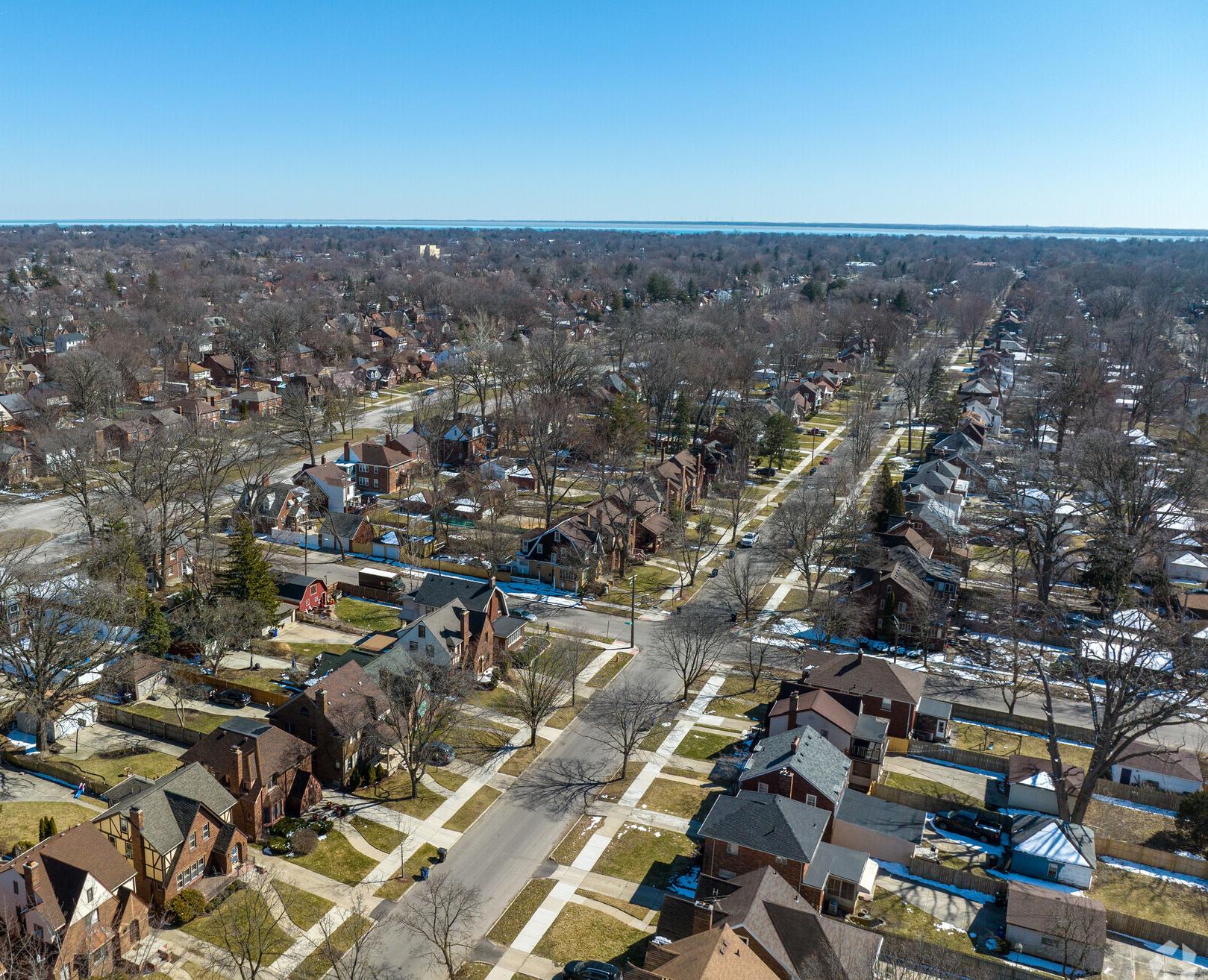

MSU
Authors:
Escarleth Cucurachi Ortega
Monica Guo
Peyton Jackson
Charlotte Peterson
Paige Smith
Partners:
U-SNAP-BAC
(United Streets Networking and Planning-Building a Community)
Morningside Community Organization
Michigan State University
School of Planning, Design and Construction
UP894 Planning Practicum

Dr. Zenia Kotval, Ph.D., FAICP
Professor and Program Director, Urban and Regional Planning MSU
Katharine Merritt, EDFP, MURP Instructor, Urban and Regional Planning MSU
April 2024
3
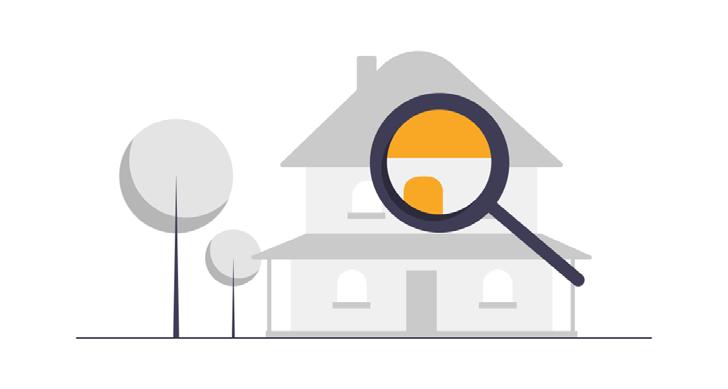
4 ACKNOWLEDGEMENTS 7 EXECUTIVE SUMMARY 8 OBJECTIVES 10 I. INTRODUCTION 11 II. NEIGHBORHOOD OVERVIEW 13 2.1 MORNINGSIDE IN BRIEF 14 2.2 SOCIO-ECONOMIC PROFILE 16 2.2.1 Population Trends 16 2.2.2 Population Gender and Age Structure 16 2.2.3 Racial Composition 17 2.2.4 Educational Characteristics 18 2.2.5 Income & Poverty Characteristics 19 2.2.6 Employment Trends 20 2.2.7 Employment by Industry 21 2.2.8 Shift-Share Analysis 22 2.2.9 Crime Index 23 2.2.10 Housing Occupancy 24 2.2.11 Land Ownership Assessment 24 III. HOUSING EVALUATION 27 3.1 HOUSING ASSESSMENT 28 3.1.1 Housing Profiles by Census Tract 28 3.1.1.1 Census Tract 5013 28 3.1.1.2 Census Tract 5014 30 3.1.1.3 Census Tract 5018 32 3.1.1.4 Census Tract 5019 34 3.1.1.5 Census Tract 5020 36 3.2 HOUSING CONDITIONS EVALUATION 39 3.2.1 Methodology 39 3.2.2 Housing Condition Survey 41 3.2.2.1 Overview 41 3.2.2.2 Windshield Survey 42 3.3 COMMUNITY ENGAGEMENT 44 3.3.1 Community Meeting 44 3.3.2 Internal Housing Condition Community Survey 45 3.3.3 Strengths, Weaknesses, Opportunities and Threats (SWOT) Analysis 47 CONTENT

5 IV. FUNDING ELIGIBILITY AND PRIORITAZATION 49 4.1 HOUSING FUNDING SOURCES 50 4.1.1 Detroit 0% Home Repair Loans Program 50 4.1.2 Michigan Department of Health and Human Services (MDHHS) Home Repairs Program 52 4.1.3 Community Development Block Grant (CDBG) Program 53 4.2 FUNDING ELIGIBILITY PRIORITAZATION TOOL 55 4.2.1 Methodology 55 4.2.2 Funding Eligibility Indicators 58 4.2.2.1 Tenancy 58 4.2.2.2 Elderly Population 59 4.2.2.3 Property Crimes 60 4.2.2.4 Vacancy Rates 61 4.2.2.5 Old Housing Stock 62 4.2.2.6 Affordability Struggles by Middle and Low-Income Households 63 4.2.2.7 Affordability Struggles by Elderly Households 64 4.2.2.8 Poverty Level 65 4.3 HOUSING PRIORITY EVALUATION TOOL 66 V. MORNINGSIDE RECOMMENDATIONS 71 5.1 MORNINGSIDE HOUSING REVITALIZATION STRATEGY 72 5.1.1 Inform: Sharing Information 74 5.1.2 Expand: Continue Housing Assessment Evaluation and Fundings Application 76 5.1.3 Replicate: Maintain Successful Practices with New Funding Sources 80 5.2 MORNINGSIDE HOUSING TOOLKIT 84 5.2.1 Databases 84 5.2.2 GIS Project 84 5.2.3 Video Tutorials 85 5.2.4 Handbook 85 VI. ADDITIONAL RECOMMENDATIONS 87 6.1 NEIGHBORHOOD VITALITY IMPROVEMENT 88 6.1.1 Recommendation 1: Establish Simple Rules for Home Repair Expenses 88 6.1.2 Recommendation 2: Neighborhood Clean-up and Restoration 88 6.1.3 Recommendation 3: Redevelopment Initiatives 89 6.1.4 Recommendation 4: Land Bank Side Lot Program 90 6.1.5 Recommendation 5: Greening Efforts 91 VII. GLOSSARY 94 VIII. REFERENCES 97 IX. APPENDIX 100
ACKNOWLEDGEMENTS
Urban and Regional Planning requires coordination and cooperation between distinct groups and interests. The research and findings in this document could not have been completed without the assistance and dedication of the people and organizations listed below, to whom our group owes many thanks.
• Linda Smith, Executive Director of U-SNAP-BAC
• Eric Dueweke, Morningside Community Organization
• Habitat for Humanity Detroit
Additional groups include:
• Darnell Adams, Vice President of Detroit Community
• Initiatives at the Gilbert Family Foundation
• The residents of the Morningside neighborhood
• Detroit Land Bank
• Michigan State Urban and Regional Planning Program
• HOPE Housing Justice Lab, Michigan State University
FUNDING ACKNOWLEDGEMENT
Planning Practicum receives support from our community clients. It is financially aided by the generous contributions from Michigan State University Extension and the Regional Economic Initiative grant provided by the United States Department of CommerceEconomic Development Administration and the Michigan Economic Development Corporation. The opinions expressed in the statements, findings, conclusions, and recommendations are the authors’ sole responsibility and do not necessarily reflect the views of Michigan State University or any federal or state agency.
7
EXECUTIVE SUMMARY
10,334 Total Population

4,398 Housing Units

$48,897
Median Household Income



Morningside is a neighborhood located on the eastside of Detroit, Michigan. The community is backed by several strong partner organizations, including U-SNAP-BAC (The United Streets Networking and Planning and the Morningside Community Organization), who work to improve housing conditions and increase homeowner education across the neighborhood. These partners are committed to serving Morningside, and are seeking further research to assess community housing needs. In response, a method for prioritization of repairs, paired with tools to identify target areas for funding has been created to aid in efficient distribution of government funds. With strategic prioritization of both individual homes and target areas throughout the neighborhood, the project aims to support Morningside residents in conducting home repairs. Additional recommendations extend to community vitality initiatives, which work to engage residents and enhance overall community desirability.


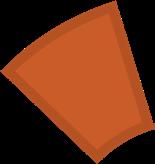



Morningside has 4,398 housing units in five census tracts. This report uses tract 5019, with 1,112 housing units, as a representative sample size for the external condition assessment. Tract 5019 is bordered by East Warren Avenue and Mack Avenue, and has lower household incomes than the surrounding tracts. Almost thirty percent of households in the tract live below the poverty line and there is a significant number of vacant parcels. The tract was surveyed using a weighted ranking system which quantified the repair needs of individual homes. These survey questions will be shared with community partners, along with instructions for replication of the process in the several remaining tracts that make up Morningside.
Following a system of housing prioritization that categorizes homes based on their visible external conditions for the 5019 Census Tract, 80% have been classified as properties in “good” condition. Additionally, 12% of lots were vacant, 4% earned “fair” rankings, 3% were not residential lots, and one percent 1% were “critical” or “poor”. A second survey was also administered to gauge the demand
8 African American 87% White 8% 2+ races 4% American Indian, Asian & Pacific Islander 1% African American White 2+ races American Indian, Asian & Pacific Islander Owners 71% Renters 29% Owners Renters
for internal home repairs at a Morningside community meeting. Roughly half of all respondents reported roof leaks, flooding in their basements, unsecure doors, and at least one broken window in their home. A smaller number of community members also communicated the need for repaired heating systems, assistance in fixing nonfunctional bathrooms, and new water heaters. The potential funding sources provided include funding opportunities that are applicable to external repairs, as well as these delineations of internal renovations. Recommendations also account for current market conditions that have exacerbated affordability challenges and are further complicated by the existing aging housing stock in Morningside.
The proposed strategies aim to ensure that community members are able to access funding to occupy safely habitable housing units, while furthering neighborhood vitality efforts. Recommendations have been categorized by timeframe, with strategies that can be completed in under three years classified as short-term, and three or more years as medium-term.
The first set of actionable recommendations focuses on informing and engaging residents. The methodology for surveying external conditions can be practiced by homeowners with their own properties. Conducting a community workshop to familiarize the neighborhood with the process of assessment would efficiently disseminate process tips and strategies. The workshop could be bolstered by the provided “Guide to Assessing your House” instructional material. Neighborhood walks where members of the community can evaluate housing conditions on the ground, guided by U-SNAP-BAC and Morningside Community Organization leaders, are also suggested to efficiently gather data, identify target areas, and record community feedback.
The next set of recommendations involves expanding assessment practices to the remaining tracts throughout Morningside. This
step relies on familiarity with the provided Housing Prioritization Evaluation Database. All addresses in Morningside are listed in the database and can be populated with individual condition rankings gathered from previous assessment. The area priority ranking of the respective census tract is automatically factored into the overall housing priority score. This tool allows administrators to extend current priority initiatives past census tract 5019. Additionally, all of the figures in the database can be updated to be representative of new Census data or conducted home repairs. The results can be mapped using a free geographic information system (GIS) software, QGIS. With prioritization areas highlighted, in combination with the previous identification of the types of home repairs necessary, funding eligibility can be determined.
The Funding Eligibility Evaluation tool is intended to align funding sources with eligibility criteria. The tool accounts for affordability, demographic, and housing stock indicators. The Percentage of families living below poverty level and the percentage of housing units built before 1939, receive double weight because of their relevance to both financial feasibility of repairs, as well as the likelihood of home repairs being necessary. The resulting area funding eligibility priority for each tract can be used to direct funding applications depending on which areas demonstrate the greatest need.
In addition to the housing strategies, recommendations have been outlined to increase community vitality in Morningside. Morningside already has an active community organization that hosts neighborhood events, clean-up days, and maintains a community garden. These efforts can be expanded to help address the 17% of lots throughout the neighborhood that are vacant.
Addressing the gaps currently present in the housing conditions of the neighborhood in the coming years generates community longevity and works to ensure housing attainability for residents.
9
OBJECTIVES
MAIN OBJECTIVE
The overall goal is to effectively allocate available funding towards housing rehabilitation and repair projects in the Morningside neighborhood, prioritizing areas based on housing conditions and community needs. This involves implementing and replicating the methodology that comprehensively assesses housing conditions, determines priority areas for intervention, and ensures appropriate resource allocation. Additionally, the strategy should provide guidance on where to start interventions and establish criteria for determining recommended interventions.
PARTICULAR OBJECTIVES
1. Assessing Home Repair Needs in a Sample Area
Objective: Identify homes requiring repair within a sample area through comprehensive assessment, providing a foundational understanding of the scope and urgency of rehabilitation efforts.
2. Developing a Strategic Rehabilitation Plan
Objective: Strategically plan and prioritize the order and distribution of rehabilitation efforts using a targeted methodology, ensuring efficient allocation of resources and maximizing impact on community stability.
3. Empowering Residents and Neighborhood’s Administrators with Tools and Information
Objective: Provide residents with specific tools and information to empower them in participating actively in housing revitalization efforts, fostering community engagement and ownership of the revitalization process.
10
I. INTRODUCTION
In partnership with Michigan State University, United Streets Networking and Planning-Building a Community (U-SNAPBAC), Habitat for Humanity, and the Morningside Community Organization, a housing revitalization initiative has commenced to address the critical housing challenges within Detroit’s Morningside neighborhood. This collaborative effort aims to provide a targeted approach toward housing need prioritization, strategic allocation of resources, and community vitality improvements.
The project serves to highlight the pressing need for housing rehabilitation in Morningside. The neighborhood consists of an aging housing stock, and many residents are cost-burdened. As a result, there is a high demand for home repairs that homeowners often struggle to fund. The methods proposed in this report intend to identify the most prevailing issues and devise practical solutions that align with the community’s goals.
Comprising a multi-faceted analysis, the project thoroughly examines socio-economic trends alongside an external conditions assessment for one census tract that can be replicated by Morningside administrators and community members for remaining tracts. Data findings, from population demographics to property ownership patterns, are provided as evidence for proposed recommendations.
In addition to assessment of the physical housing stock, metrics have been provided to facilitate funding disbursement tailored to the needs of each census tract. This localized perspective enables understanding of the challenges faced by each neighborhood segment and connection to funding sources that are most applicable to the residents.
Integral to the project’s success is its attention to community engagement, ensuring that the voices and concerns of Morningside residents are central to the decision-making process. Through resident feedback offered at a Morningside community meeting and a housing condition survey administered both digitally and inperson, the project seeks to address immediate housing needs and lay the foundation for a resilient and thriving community.
As the project unfolds, it is structured to efficiently disseminate funding opportunities to identified neighborhood targets for repair, while engaging community members in revitalization initiatives. The project aspires to create lasting positive change through strategic partnerships, data-driven insights, and community-driven solutions, enhancing the quality of life for all who call Morningside home.
11

II. NEIGHBORHOOD OVERVIEW
This chapter delves into the socio-economic and housing landscape of the Morningside neighborhood in Wayne County, Detroit, Michigan. It begins by examining population trends, gender and age structure, racial composition, educational characteristics, income and poverty levels, and employment trends, including a breakdown of employment by industry and a Shift-Share Analysis. Furthermore, it evaluates the crime index to gauge safety and community well-being. The housing profile section provides a succinct overview of housing conditions, occupancy assessment, and land ownership distribution. This comprehensive analysis forms the foundation for understanding the community’s needs and challenges, which are crucial for devising effective strategies in the subsequent chapters.
II
Figure 1. The neighborhood of Morningside. Photo by Morningside Newsletter.
CHAPTER
2.1 MORNINGSIDE IN BRIEF
Morningside is a historic neighborhood built between 1918 and 1950 in the east-central part of Detroit. The area is bound by Harper Avenue and Interstate 94 to the north, Mack Avenue to the south, East Outer Drive and Whittier to the east, and Alter Road and East Outer Drive to the west. The area has a rich history and diverse population, contributing to its unique character. This section aims to provide an overview of the key figure indicators shaping the Morningside community and compare it with the city of Detroit.
It is essential to clarify that the U.S. Census Bureau (American Community Survey) does not officially recognize specific neighborhoods in its data collection. The demographic information presented in this report is based on broader geographic units, such as cities, census tracts, and block groups, rather than individual neighborhoods.
As shown in Figure 2, there are 5 Census Tracts in the Morningside Neighborhood. Census Tracts 5014 and 5018 also covered the East English Village Neighborhood. The Housing Assessment chapter will include details of the 5 Census Tracts.

14 NEIGHBORHOOD OVERVIEW
Figure 2. Morningside Location in Michigan.
The homes in Morningside vary in age and condition. This historic single-family neighborhood built 90% of its homes before 1950. The neighborhood’s diverse architectural styles, ranging from quaint bungalows to stately Tudors, offer a snapshot of Detroit’s rich past. According to the current Detroit zoning ordinance, most parcels in the Morningside neighborhood are single-family and two-family residential districts (R1 & R2). A small number of general business districts (B4) are located along Warren Avenue and Mack Avenue. Like many areas in Detroit, Morningside has struggled with divestment and elevated vacancy rates. Some properties exhibit signs of aging and require maintenance, while others showcase diligent upkeep, contributing to the overall character of the community. Recent community efforts have centered on blight removal and revitalizing salvageable properties
15 NEIGHBORHOOD OVERVIEW
Figure 3. Morningside Zoning Map. Source: City of Detroit.
2.2 SOCIO-ECONOMIC PROFILE
2.2.1 Population Trends
As of the latest available data (2022), Morningside’s population is estimated to be 14,943. The population has decreased by 0.46% since 2020.
2.2.2 Population Gender and Age Structure
Morningside’s median age is 35, Detroit’s is 35, and Wayne County’s is 38. Morningside and Detroit have younger demo figures than the county.
According to the age pyramid shown in Figure 2, Morningside has a relatively balanced gender ratio. The comparison to Wayne County shows a more significant percentage of the population older than 35 years old in the county than the population older than 35 years old. A greater percentage of the younger population (34 years old or below) is also in the Morningside Neighborhood: Morningside’s youthfulness and balanced gender ratio contribute to its diverse and dynamic environment. Therefore, community engagement with the younger generation is essential at Morningside.
According to Table 1, the population from 2010 to 2022 at all levels experienced a decrease. The change rate of Morningside is smaller than that of the city of Detroit but much larger than the change ratio of the County between 2010 and 2020. It suggests that Morningside Neighborhood is experiencing a slightly milder decline than Detroit despite the overall negative population trend. It also indicates that Morningside and Detroit are undergoing more significant population declines than Wayne County. The extreme demographic challenges affecting Morningside and Detroit are more localized and not reflective of the county trends.
Table 1 also shows change rates in total population for the county, city, and Morningside Neighborhood levels during and after the COVID-19 pandemic (2020-2022). Morningside is facing a mild population decline with a change rate of -0.46%. Although still negative, this change rate is considerably less severe than that of the county and the city of Detroit. It shows that Morningside was less affected than the city and state during this period

16 NEIGHBORHOOD OVERVIEW
Population 2010 2020 2022 Change Rate 20102020 Change Rate 20202022 Morningside Neighborhood 16,477 15,012 14,943 -8.90% -0.46% Detroit City 711,120 639,111 620,376 -10.10% -2.90% Wayne County 1,814,847 1,789,129 1,757,043 -1.40% -1.80%
Table 1. Population Trends. Source: U.S. Census Bureau (American Community Survey Five-Year Estimate).
Figure 4. Age Pyramid of Morningside. Source: ESRI Census Summary.

2.2.3 Racial Composition
The racial composition of Morningside Neighborhood is characterized by an 87.2% majority African American population complemented by a White population, residents identifying with two or more races, and smaller populations of American Indian, Asian, and Pacific Islander backgrounds.
American White 2 and More Races American Indian, Asian, Pacific Islander, etc.
17 NEIGHBORHOOD OVERVIEW
Figure 5. Morningside Racial Composition. Source: U.S. Census Bureau (American Community Survey Five-Year Estimate).
8.10% 3.50% 1.20%
87.20%
African
Figure 6. Morningside Detroit, 1991. Photo by Jim West.
2.2.4 Educational Characteristics
Educational attainment in Morningside has increased since 2012, indicating that more people are obtaining higher education levels. Significantly more county, city, and neighborhood residents earned a high school diploma or equivalent than a bachelor’s degree. In Wayne County, 83.80% of people earned a high school diploma, and nearly the equivalent number of people in Morningside earned a high school diploma or equivalent.
Morningside maintains two educational centers, JE Clark Preparatory Academy (K- 8th grade) and Ronald Brown Academy (6th- 8th grade). The nearest high school for Morningside residents is in the adjacent neighborhood, East English Village, which suggests that residents have higher accessibility to high school education. However, there is a significantly lower rate of people 25 years or older with a bachelor’s degree.
In 2012, 10.80% of people in Morningside had a bachelor’s degree. In 2022, 15.90% of neighborhood residents had a bachelor’s degree. Additionally, fewer people earned a bachelor’s degree in Morningside than city and county residents. In general, Morningside had higher rates of residents with a high school diploma than residents with a bachelor’s degree.

2012 2022 High School Diploma or Equivalent Bachelor’s Degree or Higher High School Diploma or Equivalent Bachelor’s Degree or Higher Morningside Neighborhood 82.70% 10.80% 87.90% 15.90% Detroit City 77.20% 12.30% 82.80% 16.90% Wayne County 83.80% 20.80% 87.70% 27.30%
Table 2. Educational Attainment (ages 25 and over). Source: U.S. Census Bureau (American Community Survey Five-Year Estimate).
Figure 7. J.E. Clark Preparatory Academy. Photo by Homes.com.
2.2.5 Income & Poverty Characteristics
In 2012, a significant percentage of Morningside residents were considered low-income, meaning residents may face financial challenges compared to others with a higher income. However, annual median income across the county, city, and neighborhood has significantly increased since 2012. In Morningside, residents’ annual median income nearly doubled from $27,909 to $48,750. In contrast, residents of Detroit make less than those in Morningside. In 2012, the annual median income in Detroit was $26,955, and Morningside was $27,909. In 2022, the median income in Detroit was $36,453, and in Morningside, it was $48,750, indicating that residents in the neighborhood are experiencing fairly higher wages than their Detroit counterparts. Although residents in Morningside earn a higher income than people in Detroit, annual median incomes in the neighborhood are still significantly low compared to others with a high income. Additionally, Morningside residents earn lower incomes, which hinders residents from accessing higher-paying jobs.
The percentage of people in Morningside below the poverty line is relatively high, which indicates that residents lack essential funds to maintain a sustainable life. As of 2022, the poverty line was $14,880, the minimum income people make to cover basic needs. Since 2012, the poverty rate across the county, city, and neighborhood has decreased. Wayne County’s poverty rate in 2012 was 23.80%, and in 2022 dropped to 20.20%. In Detroit, the poverty rate was 38.10% in 2012 and decreased in 2022 to 31.50%. Morningside’s poverty rate was 37.10% in 2012 and decreased to 27.10% in 2022. Additionally, Morningside retains a poverty rate that is lower than Detroit’s. Overall, the poverty rate in Morningside is significantly high, which suggests residents lack sufficient funds to maintain a suitable life.
19 NEIGHBORHOOD OVERVIEW
2012 2022 Morningside Neighborhood $27,909 $48,750 Detroit City $26,955 $36,453 Wayne County $41,504 $55,867 2012 2022 Morningside Neighborhood 37.10% 27.10% Detroit City 38.10% 31.50% Wayne County 23.80% 20.20%
Table 3. Median Annual Income. Source: U.S. Census Bureau (American Community Survey Five-Year Estimate) & ESRI Census Summary.
Table 4. Poverty. Source: U.S. Census Bureau (American Community Survey Five-Year Estimate).
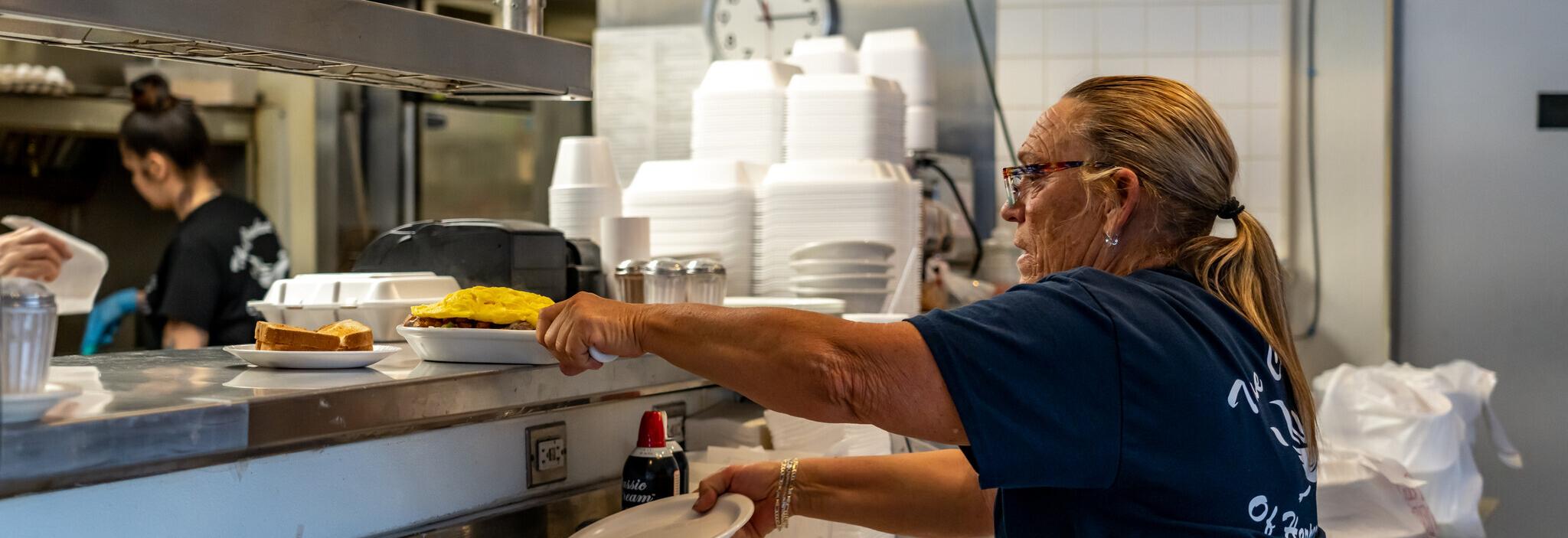
2.2.6 Employment Trends
As depicted in table 5, despite a general trend of employment variability over the past several years, Detroit has experienced greater volatility in its unemployment rates than state averages. Michigan and Detroit faced a spike in unemployment in 2020, with Detroit’s unemployment rate being two times greater than the state’s. The most recent data from 2022 indicates that Detroit still suffers elevated unemployment rates at 14.2%, compared to 5.7% at the state level.
The census tracts that make up the Morningside neighborhood resemble figures for the city, suggesting that Morningside is not immune to Detroit’s challenges. The implications of increased unemployment include decreased income averages, lower quality of life factors, and diminished ability to care for and maintain homes. As a result, the need for home repair grants magnifies, expanding the need in communities like Morningside with a housing stock that consists primarily of single-family homes.
2017 2020 2022
20 NEIGHBORHOOD OVERVIEW
Figure 8. The Cracked Egg on Mack Ave. Photo by Homes.com.
Morningside Neighborhood 15% 10.20% 13.30% Detroit City 19% 14.20% 14.20% Wayne County 6.80% 5.50% 5.70%
Table 5. Unemployment Rate. Source: U.S. Census Bureau (American Community Survey Five-Year Estimate).
2.2.7 Employment by Industry
Additional analysis of employment in the industry sector provides further understanding of local economic conditions influencing Morningside. The location quotients (LQ) listed in Table 6 are provided by the U.S. Bureau of Labor Statistics and ranked from highest to lowest LQ above one. Industries that receive a ranking greater than one employ a greater portion of the local workforce than the national composition. Given that architecture and engineering, production, legal, healthcare practitioners/technical occupations, and business and financial operations make up the greatest portion of employers in the metropolitan area’s economy, drastic shifts in these industries are likely to have the greatest impact on employment rates. Consequently, higher unemployment rates would likely result in diminished disposable income and the ability to fund necessary home repairs without financial assistance.
21 NEIGHBORHOOD OVERVIEW
Educational services, health care, and social assistance 26% Manufacturing 17% Arts, entertainment, recreation, accommodation and food services 13% Retail trade 10% Transportation and warehousing, and utilities 8% Professional, scientific, management, administrative, and waste management services 8% Other services, except public administration 5% Finance and insurance, and real estate and rental and leasing 4% Public administration 3% Construction 3% Wholesale trade 2% Information 1%
26% 17% 13% 10% 8% 8% 5% 4% 9% Educational Services, and Health Care, and Social Assistance Manufacturing Arts, Entertainment, and Recreation, and Accomodation and Food Services Retail Trade Transportation and Warehousing, and Utilitie Professional, Scientific, and Management, and Administrative and Waste Management Services Other Services, Except Public Administration Finance and Insurance, and Real Estate and Rental and Leasing Construction, Wholesale Trade, Information and Public Administration
Table 6. Employment by Industry - Detroit-Warren-Dearborn, MI (Metropolitan Area). Source: U.S. Bureau of Labor Statistics
Figure 9. Industry by Occupation - Morningside (2021). Source: U.S. Census Bureau (American Community Fiveyear Estimate).
2.2.8 Shift-Share Analysis
At the county level, shift-share calculates the performance of the local economy that Morningside participates in. Wayne County’s employment growth of 14.31% is calculated as the summation of national growth, industry mix, and regional shift for the area.
Positive employment growth indicates that the existing industries are sustaining the current population’s workforce but are also not expanding as quickly as the predominant industries at the national level from 2010-2022. Similarly, a positive industry mix reflects a sufficient speed of industry growth. The regional shift compares industry counterparts at the national level. Due to the negative value of -10.18%, Wayne is considered underperforming. While the end figure is positive, the components that make up actual growth are minimally positive and maybe a point of consideration for employment stability in the future.

Actual Growth National Growth Industry Mix Regional Shift 14.31% 22.87% 1.62% -10.18%
Figure 10. Bucharest Grill in Morningside. Photo by Homes.com.
Table 7. Shift-Share Analysis Employment Change from 2010 - 2022 (Wayne County, MI). Source: Michigan REA.
2.2.9 Crime Index
Tables 8 and 9 provide insight into crime conditions in Detroit, in collation with state and national criminality figures. The data for both violent and property crimes are tracked using the National IncidentBased Reporting System (NIBRS), which collects documentation of incidents from participating agencies across the United States. Therefore, the figures do not include unreported offenses or crimes reported to enforcement agencies without automated recordkeeping systems. While the United States has been experiencing increases in property and violent crimes across five years since 2017, Michigan has been on an overall decline for both distinctions. Similarly, Detroit has seen decreases between 5 and 10% between 2017 and 2022. The reported violent crimes have fallen by more than double the state’s rate. Diminishing violent crimes is crucial to the desirability of Morningside as a place to live and to ensuring perceptions of safety. Property crimes have also declined at a rate of about 8%, which is slightly lower than that experienced by the state. A continuation of decline is critical to managing demand for home repairs, as burglary and vandalism can destroy or remove home features integral to safe and secure living units.
23 NEIGHBORHOOD OVERVIEW
United States Michigan Detroit 2017 332,414 39,824 13,744 2020 565,882 41,171 14,494 2022 809,381 38,423 12,710 Percent Change 143.50% -3.50% -7.50% United States Michigan Detroit 2017 2,513,538 181,945 2020 3,542,734 139,990 2022 5,049,721 153,346 Percent Change 101% -15.70%
Table 8. Reported Violent Crimes. Source: Federal Bureau of Investigation, Crime Data Explorer.
Table 9. Reported Property Crimes. Source: Federal Bureau of Investigation, Crime Data Explorer.
2.2.10 Housing Occupancy
We combined data from the U.S. Decennial Census and the United States Postal Service to identify the occupancy status of the homes in Morningside, Detroit, and Wayne County. The vacancy rate has decreased from 2012 to 2022 in Wayne County, Detroit, and Morningside.
2.2.11 Land Ownership Assessment
To assess land ownership within Morningside, we used data provided by Regrid Mapping Software. There are 3,905 different owners of Morningside’s 5560 properties. Of these properties, the owner occupies 78% of homes, 16% are occupied by the land bank, and the remaining 6% is occupied by landlords who own multiple properties. The Detroit Land Bank is the largest landowner, owning 913 lots within Morningside. The Land Bank has acquired these vacant lots through tax foreclosure and the necessary demolition of hazardous homes throughout this neighborhood. Of the remaining owner classification, 29 landlords or redevelopment organizations own 5-9 properties.

24 NEIGHBORHOOD OVERVIEW
Area Vacancy Rate 2012 Vacancy Rate 2022 Morningside Neighborhood 32% 17% Wayne County 17% 11% Detroit City 29% 23%
78% 16% 6% Homeowner Land Bank Landlord/ Organization
Table 10. Comparison of vacancy rates of homes in 2012 and 2022. Source: U.S Decennial Census.
Figure 12. Morningside Landowners. 2022. Source: Regrid Mapping Software.
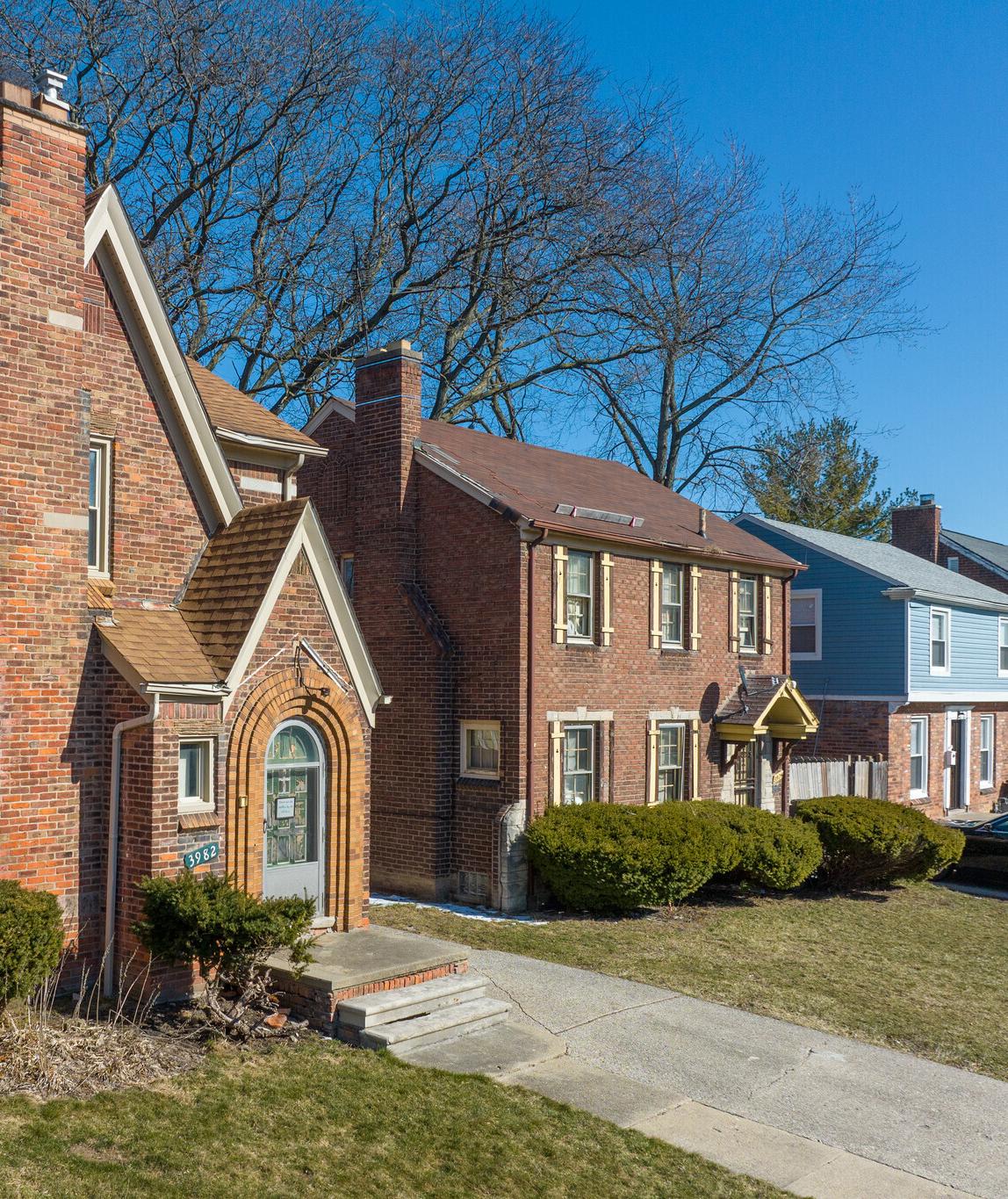
In summary, Morningside’s socioeconomic conditions are integral to the community’s prevalence of necessary home repair assistance. The neighborhood has experienced elevated unemployment and poverty rates and lower educational attainment compared to state averages within recent years. These aspects complicate the local economy and can generate volatility in income across residents. As a result, housing and home repairs should be at the forefront of community focus and funding aid.
25 NEIGHBORHOOD OVERVIEW
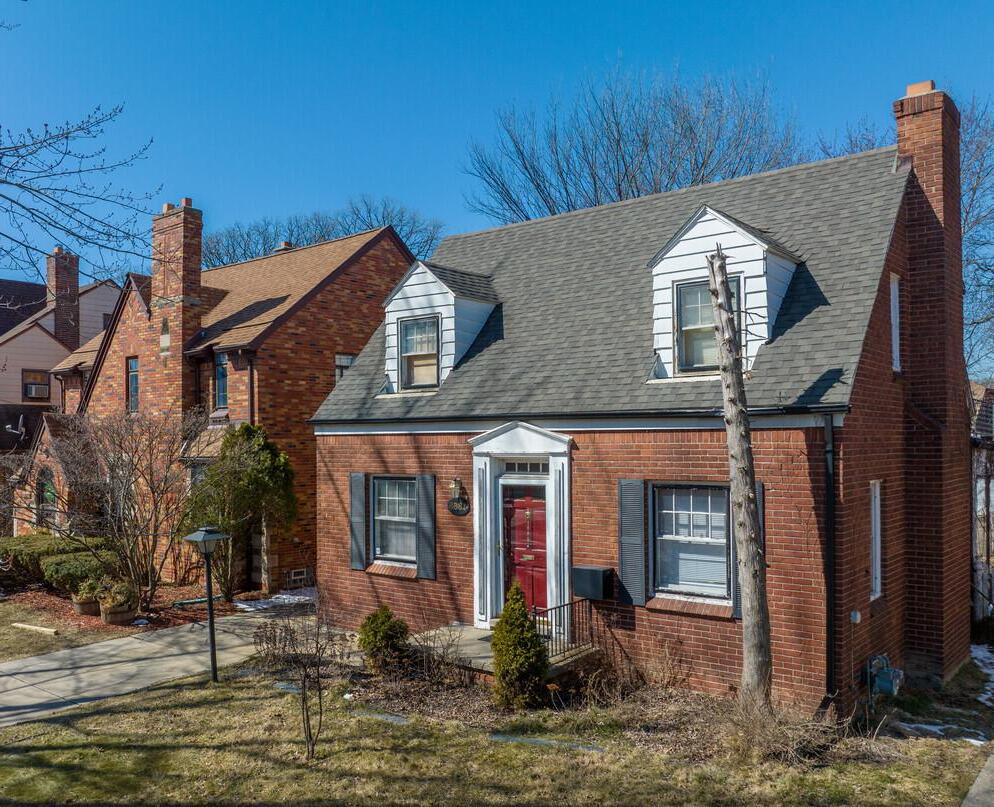
III. HOUSING EVALUATION
The chapter provides housing profiles for each census tract within the neighborhood, offering insights into specific housing conditions and priorities. It also outlines the principles of the housing survey designed to understand and prioritize housing repairs effectively. Additionally, the chapter includes a SWOT analysis, emphasizing community engagement, strengths, weaknesses, opportunities, and threats pertinent to housing improvement initiatives. This detailed assessment lays the groundwork for informed decision-making and targeted interventions to enhance housing conditions and community well-being.
III
Figure 13. A row of masonry homes in the Morningside neighborhood. Photo by Homes.
CHAPTER
3.1 HOUSING ASSESSMENT
3.1.1 Housing Profiles by Census Tract
This section focuses on the housing profile, delving into the socioeconomic and housing characteristics of various census tracts within the target region. The aim is to provide a comprehensive overview of each census tract, highlighting key figure trends, housing stock compositions, affordability challenges, and pertinent socioeconomic factors. Through rigorous data analysis and interpretation, insights are sought into the unique housing dynamics and challenges of residents in each census tract.
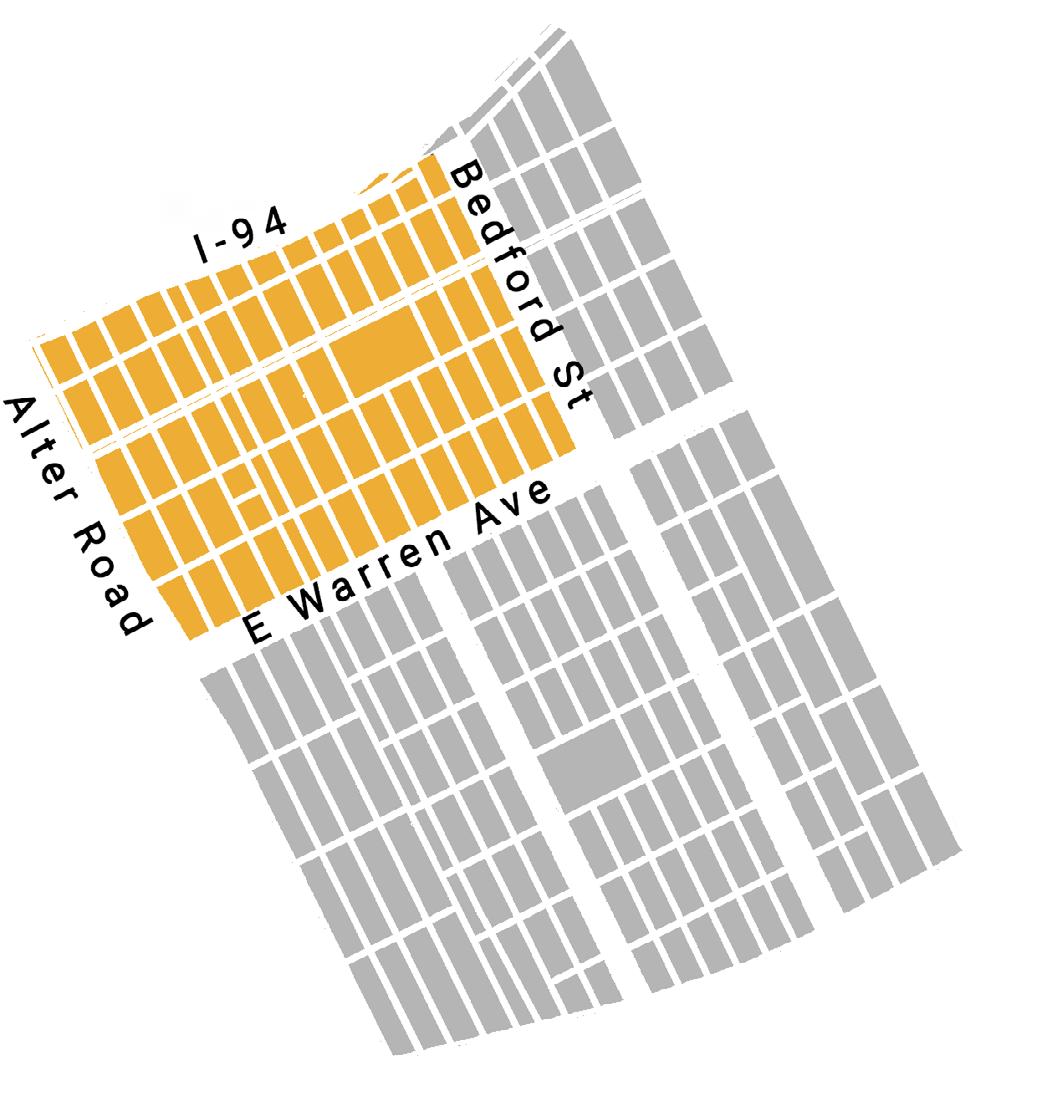
3.1.1.1 Census Tract 5013

Source: ESRI, 2023. Total Population
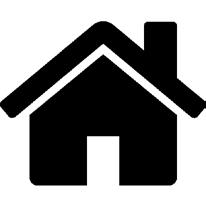
Housing Units

Household Size
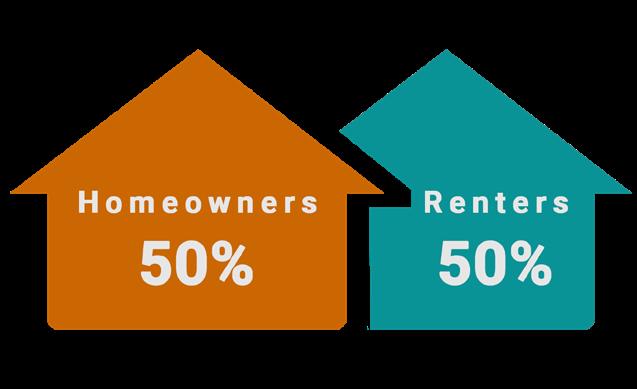
Census tract 5013 represents a predominantly Black community grappling with housing affordability and property maintenance challenges. According to ESRI (2023), this tract encompasses 3,078 individuals residing in 1,308 housing units, with a median income of $38,370 and a median home value of $61,194. The area reflects a predominantly Black figure, comprising 93.2% of the population, while White residents constitute 2.9%, and those identifying with two or more races make up 3.3%. These figures suggest that a community with a significant proportion of low to moderate-income households potentially faces challenges in accessing affordable housing options and necessary resources for property maintenance and improvement. The predominance of Black residents underscores the importance of addressing systemic disparities and historical inequities in housing access and quality within this census tract.
28 HOUSING EVALUATION
Figure 14. Location of census tract 5013 in the neighborhood.
Figure 15. Total Population by Race (Census Tract 5013). Source: ESRI, 2023.
3,078
1,308
2.92
0.10% 0.50% 2.90% 3.30% 93.20% American Indian Other race White 2+ Races Black
Figure 16. Tenancy representation of census tract 5013.
The neighborhood exhibits a balanced distribution between homeowners and renters, with a significant proportion of property crime incidents. Data from the American Community Survey (2022) shows that 83% of individuals aged between 35 and 74 years are homeowners, 71% between 15 and 74 years are homeowners, and 71% of those aged between 15 and 44 years are renters. This distribution indicates a generational divide in housing tenure, potentially contributing to property crime rates, which are notably high at 2,485 per 100,000 population, according to Social Explorer (2021). Additionally, the housing stock predominantly comprises older structures, with 53% built-in 1939 or earlier (Regrid, 2024) and a vacancy rate of 23% (Regrid, 2024), signifying potential renovation needs and neighborhood instability.
Significant housing costs burden low-income households, with all renters earning less than $35,000 and spending over 30% of their income on housing. Over 50% of homeowners with similar incomes face similar burdens. Additionally, over 28% of householders between 35 and 64 years old and 23% of those over 65 years old experience housing cost burdens exceeding 30% of their income (ACS, 2022). The high poverty rate of 27.87% (Social Explorer, 2021) exacerbates these challenges, disproportionately affecting vulnerable populations.
Census tract 5013 faces significant housing rehabilitation needs, high housing cost burdens among low-income households and renters, and a significant percentage of families living below the poverty level conceivably due to aging housing stock, limited financial resources, and economic hardship. To address these challenges, concerted efforts should focus on implementing comprehensive housing rehabilitation programs, expanding affordable housing options, and providing financial assistance to low-income households. Collaborative initiatives involving local nonprofits and government agencies are essential for improving housing conditions and fostering community stability.
Percentage of Households with Housing Costs Greater than 30% of Household Income: By Age of Head of Household Householder 35 to 64 years: Householder 65 years and over:
29 HOUSING EVALUATION
Figure 17. Households by the age of Head of Household: Disaggregated by Tenure (Census Tract 5013). Source: American Community Survey 2022 5-Year Estimates.
Figure 18. Households with Housing Costs Greater than 30% of Household Income: By Tenure and Income (Census Tract 5013). Source: American Community Survey 2022 5-Year Estimates.
% 6% 23% 20% 14% 26% 10% 2% 6% 39% 26% 4% 15% 9% % % 15 to 24 years 25 to 34 years 35 to 44 years 45 to 54 years 55 to 64 years 65 to 74 years
to 84 years 85 years and over Age of Head of Household
of Households by Age of Head of Household: Disaggregated by Tenure Owner Renter 87% 51% 17% 19% 2% 100% 100% % % % Less than $20,000: $20,000 to $34,999: $35,000 to $49,999: $50,000 to $74,999: $75,000 or more: Houshold Income
Figure 19. Households with Housing Costs Greater than 30% of Household Income: By Age of Head of Household (Census Tract 5013). Source: American Community Survey 2022 5-Year Estimates.
75
Percentage
Owner-occupied
Renter-occupied
28% 23% Householder
Householder
Age of Householders
Percentage of Households with Housing Costs Greater than 30% of Household Income: By Tenure and Income
housing units:
housing units:
35 to 64 years:
65 years and over:
3.1.1.2 Census Tract 5014
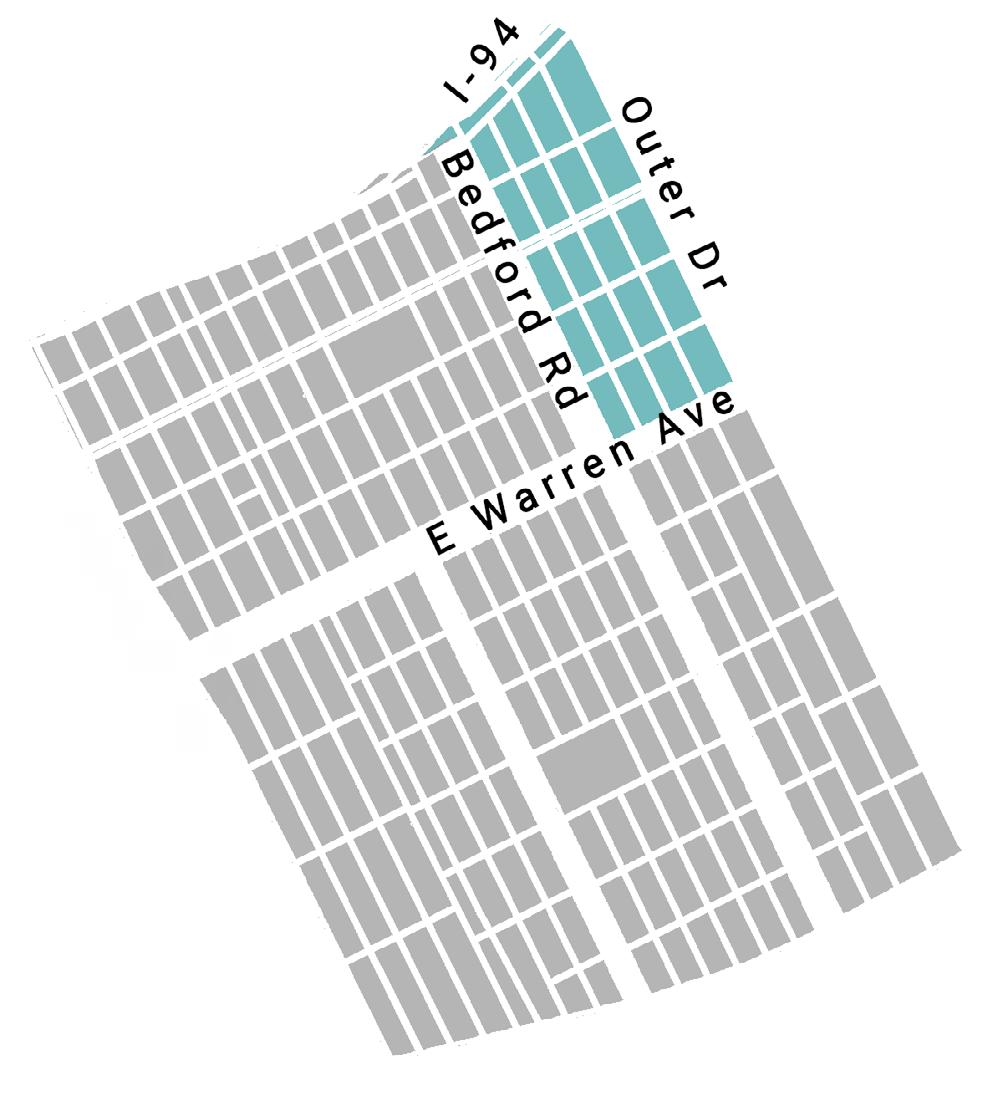
Over half of census tract 5014 in the Morningside Neighborhood falls within the East English Village. Consequently, only blocks within the neighborhood’s boundaries were considered for this study. This approach ensures a targeted analysis that closely aligns with the distinct characteristics and requirements of the Morningside community, excluding areas that may not accurately reflect its demographic, socioeconomic, and geographic composition.
Census tract 5014 is home to a predominantly Black community facing significant housing challenges amidst a landscape of demographic diversity. With a population of 1,381 individuals residing in 512 housing units, census tract 5014 exhibits a varied figure composition, as ESRI (2023) reported. The median income of $44,414 and median home value of $50,532 portray a community where financial resources may be limited compared to property values. The area is characterized by a notable presence of Black residents, comprising 90.1% of the population, White residents at 5.7%, and those identifying with two or more races at 3.3%. These demographics suggest a community with diverse socioeconomic backgrounds, where systemic inequities may exacerbate disparities in housing affordability and access to resources.

1,381 Housing Units


512 Household Size
3.04
Source: ESRI, 2023. Total Population

30 HOUSING EVALUATION
Figure 20. Location of census tract 5014 in the neighborhood.
Figure 21. Total Population by Race (Census Tract 5014). Source: ESRI, 2023.
0.20% 0.30% 0.40% 3.30% 5.70% 90.10% Asian American Indian Other race 2+ Races White Black
Figure 22. Tenancy representation of census tract 5014.
The area presents a demographic landscape characterized by most homeowners, with 82% of the population owning homes, especially among older age groups, indicating a sense of stability and investment in the neighborhood. However, the notable incidence of property crime, standing at 2,526 per 100,000 population (Social Explorer, 2021), underscores the need for proactive safety measures to ensure the well-being of all residents.
Moreover, the zone features an aging housing stock, with 67% built before 1939 (Regrid, 2024), highlighting the need for renovation and maintenance efforts to ensure habitability and safety. Despite a moderate vacancy rate of 9% (Regrid, 2024), these older structures may require revitalization to maintain neighborhood vibrancy and stability. The prevalence of substantial housing cost burdens among low-income households, renters, and younger householders underscores the urgency of targeted interventions to alleviate affordability challenges.
In conclusion, this area faces significant housing affordability issues despite its higher median home value. Efforts should focus on expanding affordable housing options, providing rental assistance programs, and supporting economic opportunities for residents. Strengthening partnerships between community organizations, housing agencies, and local stakeholders is imperative for implementing effective solutions and improving housing strength.
Owner-occupied housing units: Renter-occupied housing units:
Less than $20,000: $20,000 to $34,999: $35,000 to $49,999: $50,000 to $74,999: Household Income
Householder 15 to 24 years: Householder 35 to 64 years:
Householder 65 years and over:
Householder 15 to 24 years: Householder 35 to 64 years: Householder 65 years and over:
Age of Householders
31 HOUSING EVALUATION
Figure 23. Households with Housing Costs Greater than 30% of Household Income: By Tenure and Income (Census Tract 5014). Source: American Community Survey 2022 5-Year Estimates.
100% 16% 29%
Figure 24. Households with Housing Costs Greater than 30% of Household Income: By Age of Head of Household (Census Tract 5014). Source: American Community Survey 2022 5-Year Estimates
100% 78% 9% 7% 100% 100% % 70%
3.1.1.3 Census Tract 5018

Over half of census tract 5018 in the Morningside Neighborhood falls within the East English Village. Consequently, for this study, only blocks within the neighborhood’s boundaries were considered. This approach ensures a targeted analysis that closely aligns with the distinct characteristics and requirements of the Morningside community, excluding areas that may not accurately reflect its demographic, socioeconomic, and geographic composition.
This area depicts a potentially more affluent population with higher household income and home values than neighboring areas. According to ESRI (2023), this area encompasses a total population of 1,527 individuals residing in 700 housing units, with an average household size of 2.62. Despite a diverse racial composition, with Black residents comprising 80.4% of the population, White residents at 14.3%, and those identifying with two or more races making up 3.7%, the median income of $74,634 and median home value of $157,943 suggest greater financial resources within the community. However, challenges persist, including a generational divide in housing tenure, with 70% of individuals aged between 45 and 74 years being homeowners, while 83% of those aged between 35 and 54 years are renters, according to ACS (2022) data. The prevalence of property crime incidents, moderately high at 2,446 per 100,000 population, according to Social Explorer (2021), indicates the need for enhanced security measures despite the majority of homeownership, particularly among older age groups.

1,527 Housing Units


700 Household Size
2.62
Source: ESRI, 2023. Total Population
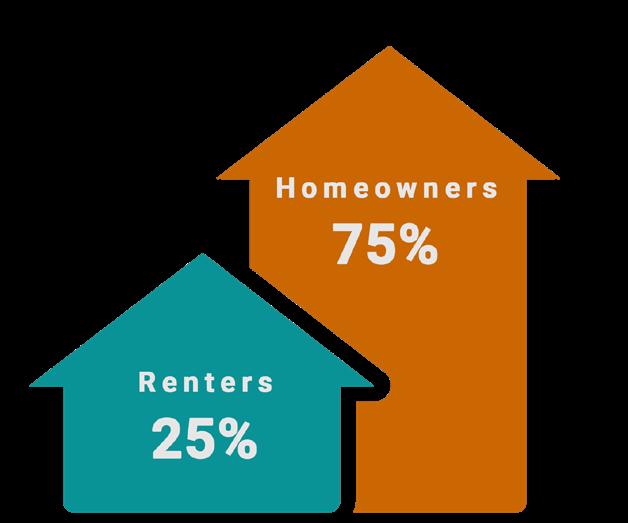
32 HOUSING EVALUATION
Figure 25. Location of census tract 5018 in the neighborhood.
Figure 26. Total Population by Race (Census Tract 5018). Source: ESRI, 2023.
0.20% 0.30% 1.10% 3.70% 14.30% 80.40% American Indian Asian Other race 2+ Races White Black
Figure 27. Tenancy representation of census tract 5018.
This tract exhibits a housing stock predominantly comprised of older structures, with 69% of the housing stock and 66% built in 1939 or earlier, according to (Regrid, 2024) data. This aging housing stock, coupled with a moderate vacancy rate of 9% reported (Regrid, 2024), highlights the need for renovation and maintenance efforts to ensure residential habitability and neighborhood stability. Remarkable housing cost burdens persist, particularly among lowincome households and renters. All renters with incomes less than $75,000 are allocating more than 30% of their household income towards housing costs, reflecting a significant affordability challenge (ACS, 2022). Disparities in housing cost burdens across different age groups, with 40% of householders between 25 and 34 years and over 18% of householders over 65 years facing housing cost burdens, underscore the widespread affordability issue within this region. Furthermore, the prevalence of families living below the poverty level, at 2,446 per 100,000 people (Social Explorer, 2021), emphasizes residents’ economic hardships.
In conclusion, despite its potentially more affluent demographic profile, this tract grapples with housing affordability challenges. To address these challenges effectively, collaborative efforts should focus on enhancing affordable housing options, providing housing counseling services, and promoting homeownership opportunities tailored to this region’s residents’ needs.
33 HOUSING EVALUATION
Figure 28. Households by the age of Head of Household: Disaggregated by Tenure (Census Tract 5018). Source: American Community Survey 2022 5-Year Estimates.
Figure 29. Households with Housing Costs Greater than 30% of Household Income: By Tenure and Income (Census Tract 5018). Source: American Community Survey 2022 5-Year Estimates.
1% 10% 14% 18% 33% 19% 3% % 23% 60% 10% 2% 4% % 15 to 24 years 25 to 34 years 35 to 44 years 45 to 54 years 55 to 64 years 65 to 74 years 75 to 84 years Age of Head of Household Owner Renter 100% 42% 46% 8% 100% 100% 100% 100% Less than $20,000: $20,000 to $34,999: $35,000 to $49,999: $50,000 to $74,999: Household Income Owner-occupied housing units: Renter-occupied housing units: 40% 14% 18%
25 to 34 years: Householder 35 to 64 years: Householder 65 years and over: Age of Householders
25 to
years: Householder 35 to 64 years: Householder 65 years and over:
Figure 30. Households with Housing Costs Greater than 30% of Household Income: By Age of Head of Household (Census Tract 5018). Source: American Community Survey 2022 5-Year Estimates.
Householder
Householder
34
3.1.1.4 Census Tract 5019

Census tract 5019 portrays a community contending with housing affordability despite relatively low median home values, signaling a pressing need for interventions to improve housing conditions. ESRI (2023) data reveals residents grappling with affordability challenges despite their lower median home values in this region. The tract accommodates 2,490 individuals in 1,112 housing units, with a median income of $51,457 and a median home value of $57,051. This data suggests that residents may struggle to access affordable housing despite their moderate income.

2,490 Housing Units

Moreover, this area exhibits a demographic landscape characterized by most homeowners and a substantial proportion of renters, alongside a moderate incidence of property crime. Data from the ACS (2022) indicates that 77% of individuals aged between 45 and 74 years are homeowners, while 64% of those aged between 25 and 54 years are renters. This correlation between age and housing tenure suggests a generational divide, with older residents more inclined to own homes while younger individuals prefer renting. Property crime incidents are also moderately high, at 2,483 per 100,000 population (Social Explorer, 2021). The prevalence of renters, especially among younger age groups, may contribute to property crime rates, highlighting the transient nature of the population.

1,112 Household Size
2.93
Source: ESRI, 2023. Total Population

34 HOUSING EVALUATION
Figure 31. Location of census tract 5019 in the neighborhood.
Figure 32. Total Population by Race (Census Tract 5019). Source: ESRI, 2023.
0.10% 0.20% 0.20% 1.10% 3.60% 4.10% 90.80% Pacific Islander American Indian Asian Other race 2+ Races White Black
Figure 33. Tenancy representation of census tract 5019.
The housing stock in this region is predominantly composed of older structures, with a notable proportion of vacant units. The Regrid (2024) statistics reveal that 64% of the housing stock dates back to 1939 or earlier, emphasizing the aging nature of the structures. Moreover, information (Regrid, 2024) indicates a substantial vacancy rate of 12% within the tract, highlighting the presence of unoccupied housing units.
Furthermore, the area experiences significant housing cost burdens, particularly among low-income households, renters, and middleaged householders. ACS (2022) data reveals that all renters with less than $35,000 in census tract 5019 allocate more than 30% of their household income towards housing costs. Similarly, over 70% of owners with less than $20,000 experience a housing cost burden. Disparities in housing cost burdens are evident across different age groups, with over 26% of householders between 35 and 64 years and over 16% of householders over 65 years facing affordability struggles. Additionally, Social Explorer (2021) data indicates that 28.47% of families in the tract live below the poverty level, underscoring residents’ economic challenges.
In conclusion, census tract 5019 grapples with significant housing cost burdens among low-income households, renters, and middle-aged householders, likely due to limited financial resources and a shortage of affordable housing options. To address these challenges, targeted interventions should focus on expanding affordable housing options, providing rental assistance programs, and supporting economic empowerment initiatives for residents. Strengthening partnerships between community organizations, housing agencies, and local stakeholders is essential for implementing practical solutions and fostering housing stability.
35 HOUSING EVALUATION
Figure 34. Households by the age of Head of Household: Disaggregated by Tenure (Census Tract 5019). Source: American Community Survey 2022 5-Year Estimates.
Figure 35. Households with Housing Costs Greater than 30% of Household Income: By Tenure and Income (Census Tract 5019). Source: American Community Survey 2022 5-Year Estimates.
5% 5% 31% 20% 26% 9% 3% 29% 14% 30% 14% 7% 7% % 25 to 34 years 35 to 44 years 45 to 54 years 55 to 64 years 65 to 74 years 75 to 84 years 85 years and over Age of Head of Household Owner Renter 74% 44% % 6% 100% 100% 39% 23% Less than $20,000: $20,000 to $34,999: $35,000 to $49,999: $50,000 to $74,999: Household Income Owner-occupied housing units: Renter-occupied housing units: 27% 17% Householder 35 to 64 years: Householder 65 years and over: Age of Householders Householder 35 to 64 years: Householder 65 years and over:
Figure 36. Households with Housing Costs Greater than 30% of Household Income: By Age of Head of Household (Census Tract 5019). Source: American Community Survey 2022 5-Year Estimates
3.1.1.5 Census Tract 5020




Census tract 5020 represents a community with housing affordability challenges despite relatively low median income and home values, pointing to potential difficulties in accessing affordable housing options. Derived from ESRI (2023) data, this area encompasses 1,858 individuals in 766 housing units, with a median income of $38,795 and a median home value of $76,911. The demographic composition is predominantly Black, comprising 93.0% of the population, 3.7% White residents, and 2.6% identifying with two or more races.
This census tract depicts a demographic landscape characterized by most homeowners and a moderate incidence of property crime. According to the ACS (2022), 44% of individuals aged between 55 and 74 years are homeowners, while 50% of those aged between 25 and 34 years are renters. Overall, 78% of the population are homeowners, with the remainder as renters. Property crime incidents are moderately high, standing at 2,479 per 100,000 people, according to data from Social Explorer (2021), necessitating proactive measures to ensure residents’ safety.
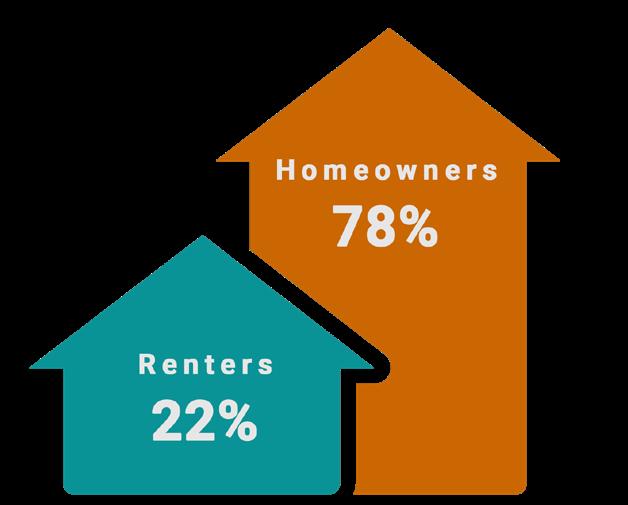
36 HOUSING EVALUATION
Figure 37. Location of census tract 5020 in the neighborhood.
Figure 38. Total Population by Race (Census Tract 5020). Source: ESRI, 2023.
Total Population 1,858 Housing Units 766 Household Size 2.96
Source: ESRI, 2023.
0.20% 0.50% 2.60% 3.70% 93.00% Asian Other race 2+ Races White Black
Figure 39. Tenancy representation of census tract 5020.
The housing stock in census tract 5020 is a mix of older and more recent structures, with 32% of the housing dating back to 1939 or earlier (Regrid, 2024). Data indicates a vacancy rate of 37%, emphasizing the need for renovation, maintenance, and strategies to repurpose vacant units (Regrid, 2024).
Significant housing cost burdens are evident among this region’s lowincome households, renters, and older householders. ACS (2022) information reveals that all renters earning less than $35,000 allocate over 30% of their income to housing costs, with a similar burden for over 65% of low-income homeowners. Disparities in affordability issues across different age groups are notable, with over 53% of householders over 65 years facing burdens exceeding 30% of their household income. Social Explorer (2021) data indicates that 22.46% of families in the tract live below the poverty level, emphasizing the need for targeted interventions and support services to alleviate housing cost burdens.
Census tract 5020 faces significant housing affordability challenges, particularly affecting low-income households, renters, and older residents. Efforts should prioritize enhancing affordable housing options, providing counseling services, and implementing aging-inplace initiatives, requiring collaboration between local nonprofits, government agencies, and community stakeholders.
Figure 40. Households by the age of Head of Household: Disaggregated
37 HOUSING EVALUATION
by Tenure (Census Tract 5020). Source: American Community Survey 2022 5-Year Estimates.
Figure 41. Households with Housing Costs Greater than 30% of Household Income: By Tenure and Income (Census Tract 5020). Source: American Community Survey 2022 5-Year Estimates.
9% 15% 44% 15% 10% 4% 4% 50% 15% 13% 14% % 9% % 25 to 34 years 35 to 44 years 45 to 54 years 55 to 64 years 65 to 74 years 75 to 84 years 85 years and over Age of Head of Household Owner Renter 76% 67% 10% 100% 100% % Less than $20,000: $20,000 to $34,999: $35,000 to $49,999:
18% 53% Householder 35 to 64 years: Householder 65 years and over: Age of Householders Householder 35 to 64 years: Householder 65 years and over:
Figure 42. Households with Housing Costs Greater than 30% of Household Income: By Age of Head of Household (Census Tract 5020). Source: American Community Survey 2022 5-Year Estimates.
Household Income Owner-occupied housing units: Renter-occupied housing units:

38 HOUSING EVALUATION
Figure 43. Census tract 5019 Location in the Neighborhood.
3.2 HOUSING CONDITIONS EVALUATION
The Housing Priority Assessment begins with a thorough evaluation of the exterior conditions of each property. To evaluate this, a housing condition survey was used. This survey addresses aesthetic concerns and examines factors such as paint or finish condition, yard maintenance, and the cleanliness of doors and windows. To survey the external condition of homes throughout the neighborhood. We have selected Wayne County census tract 5019 in Morningside, as our sample group. This census block was selected as the sample area because it is centrally located and is a fair representation of the average conditions throughout the neighborhood, as determined through the socio-economic profile and housing evaluation.
3.2.1 Methodology
Each concern is assigned a point value corresponding to the severity of deterioration observed, with a higher total indicating more urgent needs. Similarly, hazards like foundation stability, roof integrity, and porch/step condition are scrutinized, with points allocated based on the extent of deterioration. For instance, Example A might receive points for major deterioration in the foundation and doors/windows while accruing points for minor deterioration in paint finish and roof condition. This systematic assessment ensures a comprehensive understanding of each property’s condition, aiding in prioritizing housing interventions within the Morningside neighborhood.
Based on the assessment of Example A, it accumulates 11.00 points, categorizing its housing condition as “Poor.” This designation indicates that major improvements are necessary in several areas of the home, highlighting the urgency of intervention to address the identified concerns and ensure the stability and livability of the property within the Morningside neighborhood.
39 HOUSING EVALUATION
Example A Aesthetic concerns Minor Deterioration (1 point) Major Deterioration (2 points) Extreme Deterioration (3 points) Total Paint or finish (chipping) 2.00 4.00 Yard (abandoned cars, litter) 1.00 Doors and windows (dirty) 1.00 Hazards Minor Deterioration (1 point) Major Deterioration (2 points) Extreme Deterioration (3 points) Total Foundation (crumbling, sinking) 2.00 7.00 Roof (missing shingles, holes) 1.00 Porch or steps (unlevel) 2.00 Doors and windows (missing, broken) 2.00 Total Housing Condition Description 11.00 Poor Major improvements are needed in certain aspects of the home
House Address
Table 11. Example of Housing Survey Filled.
Table 12. Results of the housing condition of the example.
Overall, the housing condition stock within Census tract 5019 in Morningside presents a mixed picture. Approximately 1% of the housing units are classified as critical, indicating severe issues requiring urgent attention. Another 1% are categorized as poor, suggesting significant rehabilitation needs. While 4% are deemed fair, indicating moderate issues, a substantial portion, approximately 80%, are considered to be in good condition, reflecting stable housing stock. However, challenges persist as 12% of the units are vacant, indicating potential blight and disinvestment. Moreover, 3% of the properties are not residential, suggesting a diverse landscape within the tract. This data underscores the necessity for strategic interventions to address critical and poor housing conditions, revitalize vacant properties, and ensure the overall stability and resilience of the community.

40 HOUSING EVALUATION
Housing Conditions Lots % Critical 7 1 Poor 11 1 Fair 44 4 Good 888 80 Vacant 132 12 Not Residential 29 3 Total 1111 100
Table 13. Housing Conditions in Census Tract 5019.
Figure 44. Housing Conditions Results of Census Tract 5019.
3.2.2 Housing Condition Survey
To assess the conditions of Morningside homes, we have created an observational survey for the external aesthetic and hazardous features. The features are rated to be in good condition or minor, major, or extreme deterioration.
3.2.2.1 Overview
A housing structure with minor structural and aesthetic concerns may exhibit noticeable but non-critical issues that can be addressed without compromising the overall integrity of the building. Regarding doors, there might be minor alignment or hinge problems, leading to slight difficulty in opening or closing. Windows may have minor sealant or glazing issues, allowing air leakage. The siding might display cosmetic imperfections such as small cracks or fading. The yard may have some patches of uneven grass or minor landscaping concerns. Garbage-related issues may include a need for a more organized waste disposal system or minor repairs to garbage bins. While these concerns may affect the overall appearance and functionality, they typically do not pose immediate threats to the safety or structural stability of the dwelling. A home with minor deterioration is significantly less costly than one with major and extreme concerns.
A housing structure with major structural and aesthetic concerns would exhibit significant issues that pose potential risks to both safety and overall integrity. Doors may show signs of severe warping or misalignment, making them difficult to open or close securely. Windows might have broken panes or frames, compromising the home’s structural stability and energy efficiency. The siding could display extensive damage, including large cracks, peeling paint, or detached sections. The yard might have significant grading or drainage problems, leading to potential water damage or erosion. Garbage-related issues could involve inadequate waste management
infrastructure, creating unsanitary conditions. The foundation may show visible cracks or settling, jeopardizing the stability of the entire structure. A porch with major concerns may also exhibit severe deterioration, compromising its safety and functionality. In such cases, addressing these issues is crucial to ensure the habitability and protection of the property.
A housing structure with extreme structural and aesthetic concerns would present severe and potentially hazardous conditions, demanding urgent attention and comprehensive intervention. Doors may be damaged beyond functionality, unhinged, structurally compromised, or missing. Windows could be shattered or missing entirely, exposing the interior to the elements. Siding may be extensively deteriorated, with large sections missing or compromised, increasing vulnerability to weather conditions. The roof may have holes or extreme warping. The yard might contain broken cars, an accumulation of oddities, or complete neglect, posing environmental and safety risks. Garbage-related issues may involve hazardous waste or extreme unsanitary conditions, impacting the health of occupants. The foundation may display profound structural damage, including extensive cracks or settling, jeopardizing the stability of the entire structure. A porch with extreme concerns could collapse, posing imminent danger. In such dire circumstances, immediate and comprehensive intervention is crucial to address the property’s safety and habitability.
41 HOUSING EVALUATION
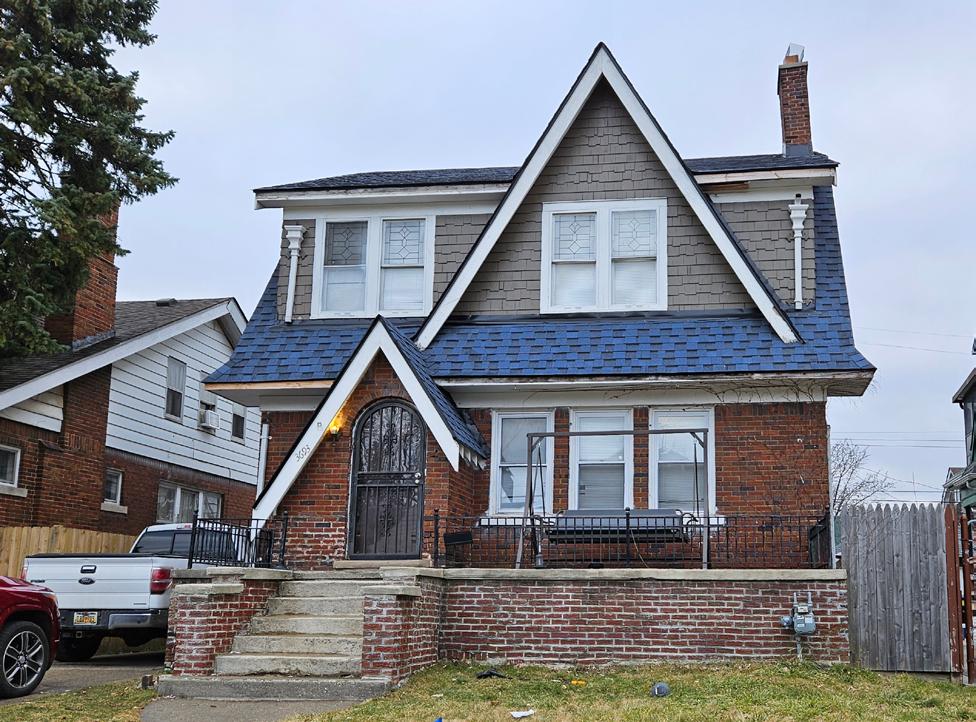


3.2.2.2 Windshield Survey
Our windshield survey covered 305 homes in block group two and will evaluate each home’s conditions, including potential hazards and aesthetic concerns. Ratings regarding hazardous conditions are weighted more because of their significance and importance to the entire structure. This survey will be rated on a one-to-three scale indicating minor, major, and extreme conditions of each criterion. We aim to identify homes within the census block and rank the necessary repair level.
The survey rating system is based on a composite score of each property. The quality rating corresponds to the point range below in Table 12. This rating system provides an idea of which houses to prioritize for home repairs in Morningside.
Most homes needing repair in census block 2, tract 5019 in Morningside, were considered “fair,” meaning homes needing repair with minor structural issues. Homes in this category generally showed minor deterioration concerns regarding either aesthetic or hazardous conditions. A “good” home consisted primarily of minor repairs such as aesthetic concerns like paint chipping and dirty windows or doors. Houses ranked as “poor” showed significant deterioration, mostly indicating aesthetic problems, such as paint chipping, and hazardous concerns, like crumbling foundations and unlevel porches. A “critical” home appeared to have extreme deterioration, meaning major improvements must occur or possible demolition may be necessary. The components from the housing conditions survey and the rating system will help Morningside residents use this as a tool to determine the conditions of their homes so they can make necessary repairs.
42 HOUSING EVALUATION
Minor Damage Major Damage Extreme Damage
Aesthetic Concerns Minor Deterioration (1 Point) Major Deterioration (2 Points) Extreme Deterioration (3 Points) Paint or finish (chipping) 12 13 8 Yard (abandoned cars, litter) 14 8 3 Doors and windows (dirty) 9 11 6 Hazards Minor Deterioration (1 Point) Major Deterioration (2 Points) Extreme Deterioration (3 Points) Foundation (crumbling, sinking) 11 7 4 Roof (missing shingles, holes) 5 12 3 Porch or Steps (Unlevel) 10 10 5 Doors and Windows (Missing, Broken) 7 11 4
Table 14. Housing Condition Survey: Number of homes by deteriorated feature and magnitude of deterioration.
Quality Rating Definition of Quality Rating
Good Minimal improvements are necessary: safe and sound structure.
Fair Improvements appear necessary; minor structural problems.
Poor Major improvements are needed in certain aspects of the home.
Critical Major improvement or demolition appears necessary.
Table 16. Description of Rating.
Aesthetic concerns
Paint or finish (chipping)
Yard (abandonded cars, litter)
Doors and windows (dirty)
Hazards
Foundation (crumbling, sinking)
Roof (Missing shingles, holes)
Porch or steps (unlevel)
Doors and windows (missing, broken)
Figure 45 presents the percentage of homes exhibiting different levels of aesthetic concerns and safety hazards, categorized by the severity of the issues. For aesthetic concerns, under the “Paint or finish” category, 3.93% of homes are experiencing minor deterioration, 4.60% show major deterioration, and 2.60% exhibit extreme deterioration. In the “Yard” category, 4.60% of homes have minor deterioration, 2.60% major deterioration, and 1% extreme deterioration. The “Dirty doors and windows” category shows 3% of homes with minor deterioration, 3.60% with major deterioration, and 2% with extreme deterioration.
Regarding hazards, under “Foundation is crumbling or sinking,” 3.60% of homes have minor deterioration, 2.30% have major decline, and 1.30% have extreme decline. For “Roof,” 1.60% of homes show minor deterioration, 3.90% have major deterioration, and 1% have extreme deterioration. In the “Porch or steps” category, 3.30% of homes exhibit minor deterioration, 3.30% major deterioration, and 1.60% extreme deterioration. Finally, under “Broken/ missing doors and windows,” 2.30% of homes have minor deterioration, 3.60% have major deterioration, and 1.30% have extreme deterioration. These percentages provide a detailed overview of the distribution of housing issues across different severity levels for aesthetic concerns and hazards.
Most homes appear in good condition, with a handful of dilapidated homes sprinkled throughout. The results indicate that of the damaged homes, most of the damage is of the minor classification. The most prominent issues documented were damage to the paint or siding of homes, crumbling front stairs, and doors or windows. The data also indicates that multiple hazards are likely present if a home shows at least one sign of damage. Addressing the structural concerns of the neighborhood is important because outliers exhibiting damage are known to increase crime and feelings of distress and decrease property values.
43 HOUSING EVALUATION
Point Range Quality Rating 0-4 Good 5-9 Fair 10-13 Poor 14+ Critical
Figure 45. Survey results of the external conditions of Morningside homes. (Feb 13, 2024).
0% 10% 20% 30% 40% 50% 60% 70% 80% 90% 100%
Table 15. Housing Condition Survey Rating System
Minor Deterioration Major Deterioration Extreme Deterioration Good Condition
3.3 COMMUNITY ENGAGEMENT
3.3.1 Community Meeting
The housing revitalization strategy project was introduced to the Morningside community at an evening public meeting on February 13, 2024, at Bethany Lutheran Church. Forty residents, including representatives from Habitat for Humanity and U-SNAP-BAC, attended the meeting. A survey was provided to assess homeowners’ needs regarding the current state of their properties and overall feedback on the neighborhood. Seven participants responded digitally, and 16 surveys were collected by hand.
The first section of the survey consisted of 13 multiple-choice questions, followed by four open-ended prompts. The multiplechoice questions pertained to the internal and external conditions of individual homes, and the last set offered space to share additional livability concerns and perceptions of Morningside’s strongest attributes and areas for improvement. After completing the survey, the floor was opened for a brief question-and-answer session from the public for the MSU team.
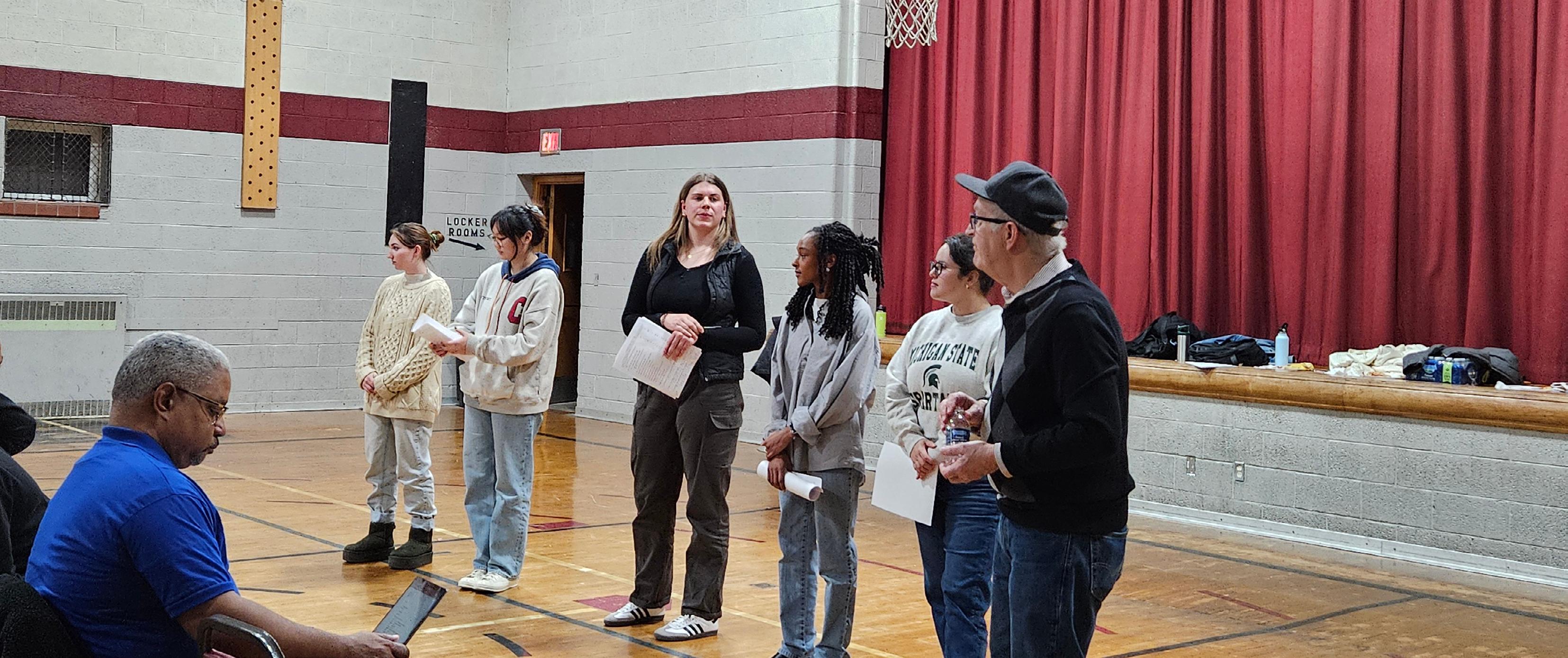 Figure 46. Community Meeting at Morningside.
Figure 46. Community Meeting at Morningside.
Do you have any water leaking into your home from the roof?
3.3.2 Internal Housing Condition Community Survey
An internal housing survey was conducted on February 13, 2024, at Morningside’s monthly community meeting to gauge potential home repairs not visible from the exterior. While the sample of 23 survey responses collected digitally and through paper copies indicate challenges that residents may be experiencing within their homes, the survey should ultimately be implemented to collect data from the community and connect homeowners with funding opportunities. The sample survey is provided with ratios of participants who selected responses for multiple-choice questions.
The survey results emphasize the community’s need for a variety of repairs. While roughly half of the respondents reported leaky roofs, basements that take on water, unsecured doors, and at least one broken window in the home, there were a smaller number of residents who require more emergent repairs, which involve inadequate heating systems, nonfunctional bathrooms, and broken water heaters. This data highlights the need for funding options that include internal conditions and can be dispersed quickly for homes requiring immediate repairs to be habitable.
Has water backed up into your basement within the past year?
Are your exterior steps and front porch usable?
Are all
45 HOUSING EVALUATION
No: 11/23 Yes: 11/23 No Response: 1/23
there
walls? No: 10/23 Yes: 13/23 No response: 0/23
your
regularly? No: 11/23 Yes: 10/23 No response: 2/23
Are
visible cracks in your basement
Does
basement leak water
No: 9/23 Yes: 13/23 No response: 1/23
No: 6/23 Yes: 17/23 No response: 0/23
exterior doors secure and usable? No: 10/23 Yes: 13/23 No response: 0/23 How many windows in your house are missing or broken? 0: 11/23 1-2: 6/23 3+: 6/23 Are all interior stairs in your home usable? No: 4/23 Yes: 18/23 No response: 1/23 Do you have at least one functional bathroom? No: 1/23 Yes: 22/23 No response: 0/23 Do you have a working water heater? No: 2/23 Yes: 21/23 No response: 0/23
you have heat in your house? No: 1/23 Yes: 22/23 No response: 0/23
is your method of heating? Radiator: 8/23 Forced air: 14/23 No response: 1/23
a majority of
No: 6/23 Yes: 17/23 No response: 0/23 Do you have a working stove? No: 2/23 Yes: 21/23 No response: 0/23 Is your stove gas or electrical? Gas: 18/23 Electrical: 2/23 Both: 2/23 No response: 1/23
Do
What
Are
the electrical outlets in your house working?
Table 17. Results of the Internal Housing Condition Community Survey
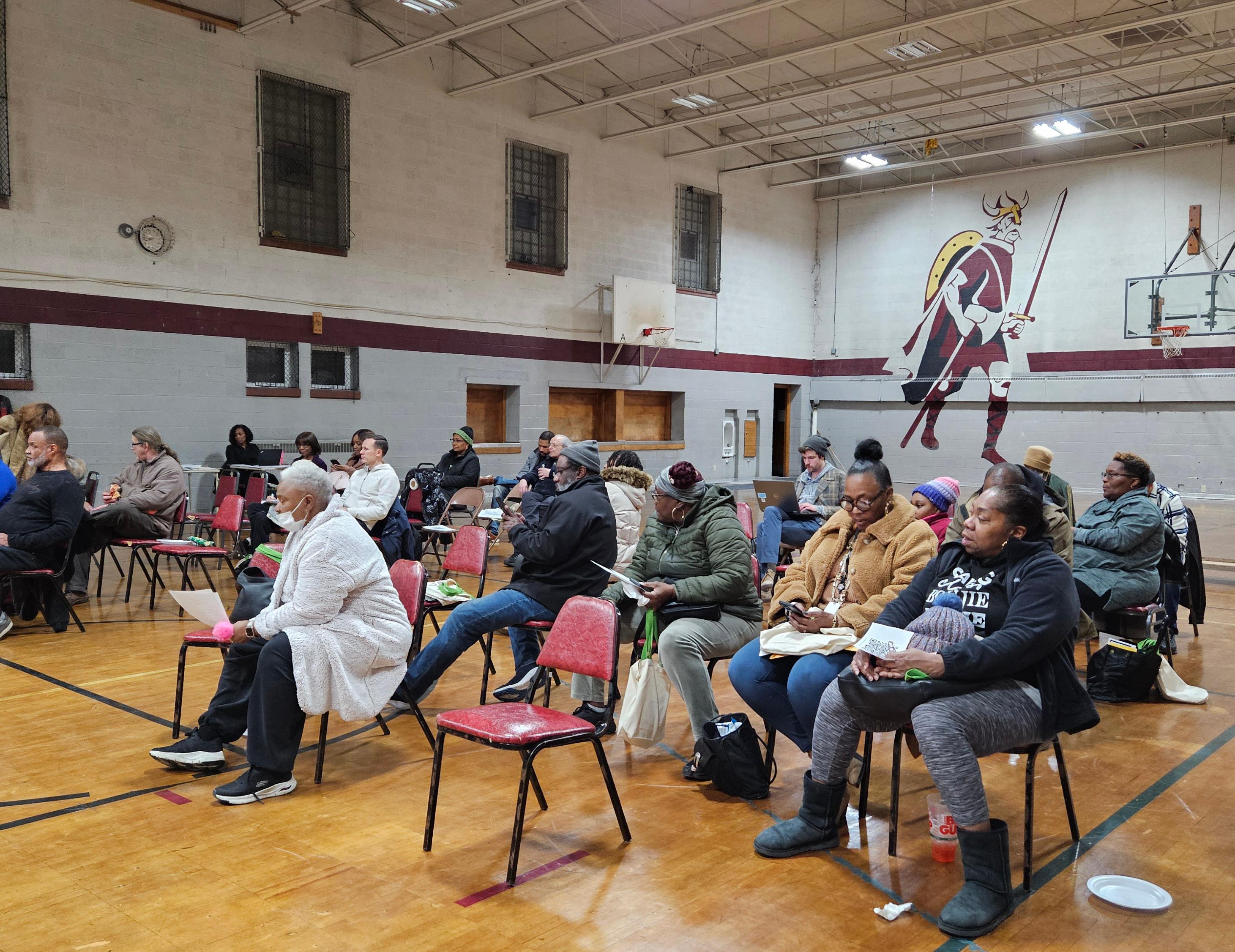 Figure 47. Community meeting participants.
Figure 47. Community meeting participants.
3.3.3 Strengths, Weaknesses, Opportunities and Threats (SWOT) Analysis
Resident feedback was collected during the aforementioned neighborhood meeting to conduct a community strengths, weaknesses, opportunities, and threats (SWOT) profile for Morningside. Analysis of responses focused on the most frequently occurring comments, which were then incorporated into the overall profile. The process and its subsequent findings highlighted areas that the community would like to capitalize on and opportunities for enhancement. The findings of the SWOT analysis are as follow.
The SWOT analysis demonstrates strong community ties prevalent across Morningside. A majority of respondents mentioned the various local organizations, partnerships, and activities that enhance the neighborhood and community atmosphere. Challenges identified ranged from individual property needs, especially those requiring funding to make homes accessible, to the composition of lots throughout Morningside. Many respondents reported that blight and abandoned properties are issues within the community that are not addressed promptly and negatively impact the neighborhood. Additionally, several residents found the prevalence of crime and unregistered rental properties to impede community growth.
To combat the weaknesses and threats identified, respondents posed several opportunities to spur neighborhood improvement. The participants suggested beautification efforts and the availability of educational opportunities surrounding homeownership and maintenance, tax foreclosure, and code enforcement. By focusing on these opportunities and working collaboratively, Morningside can strengthen its community and create more opportunities for diverse populations.
S• Block Club
• Strong sense of community and neighborhood pride
• Robust Website
• Neighbors who look out for each other
• Partnerships and active community organizations
• Neighborhood walkability
OW• Difficulty maintaining continuous membership in neighborhood groups
• Timely blight removal processes
• Poor accessibility for many properties
• More community meeting times to connect with a wider range of residents
• Beautification efforts to improve neighborhood aesthetics
• Increased education on homeownership and maintenance, tax foreclosure, and code enforcement
T• Lack of police presence and prevalence of crime
• Number of unregistered rental properties
• Abandoned buildings and illegal dumping on vacant lots that drive down surrounding property values
47 HOUSING EVALUATION
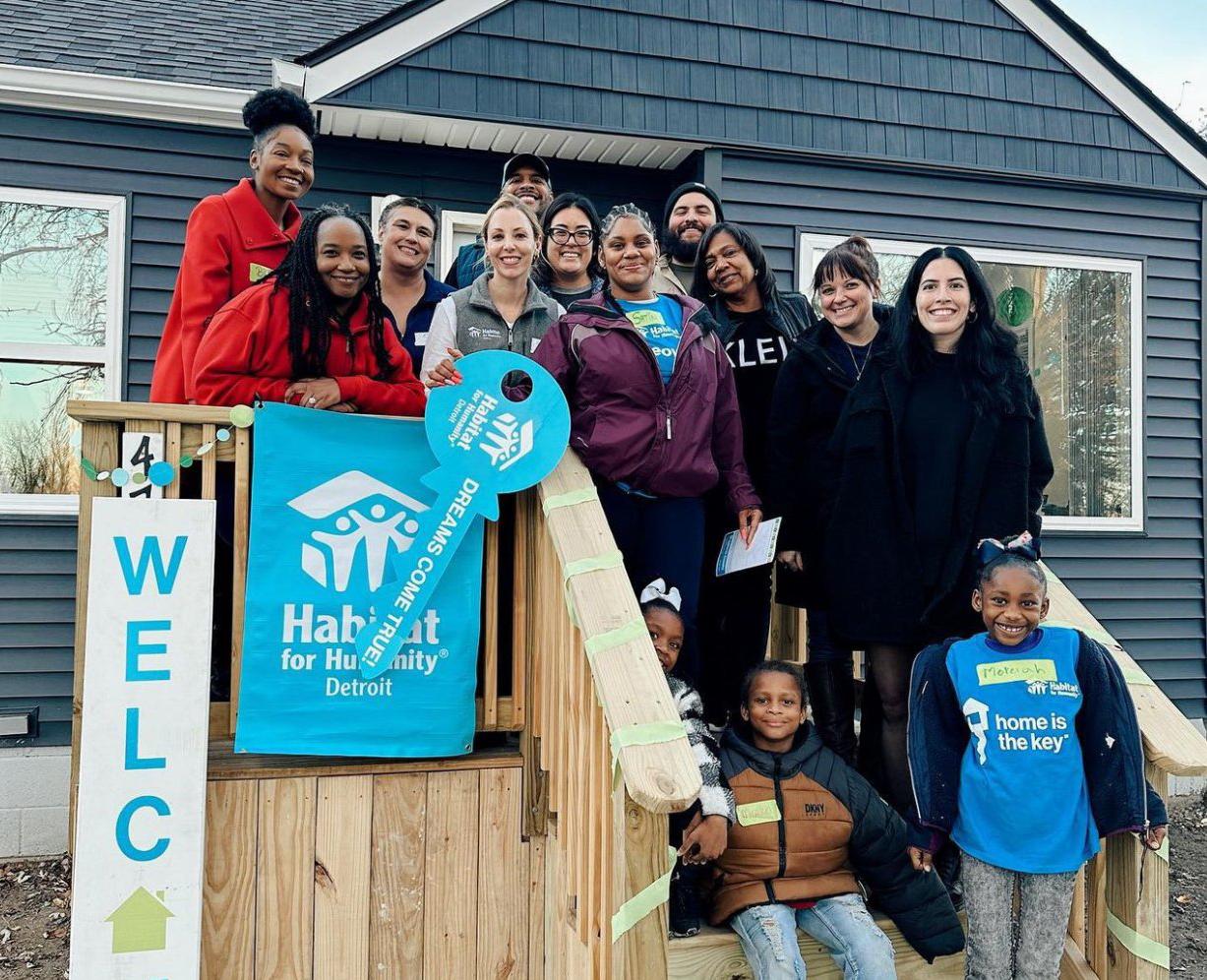
IV. FUNDING ELIGIBILITY AND PRIORITAZATION
Chapter IV delves into the critical aspects of securing funding and prioritizing housing interventions. It highlights various housing funding sources, including the Detroit 0% Home Repair Loans Program, the Michigan Department of Health and Human Services (MDHHS) Home Repairs Program, and the Community Development Block Grant (CDBG) Program. The chapter introduces the Funding Eligibility Prioritization Tool, explaining its methodology and outlining key indicators such as tenancy, elderly population, property crimes, vacancy rates, old housing stock, and affordability struggles. These indicators guide the prioritization process, ensuring resources are allocated to areas with the most urgent housing needs. Additionally, the chapter introduces the Housing Priority Evaluation Tool, which aids in evaluating and ranking housing priorities based on predefined criteria. Through these tools and methodologies, the chapter aims to streamline funding allocation and maximize the impact of housing revitalization efforts.
IV
Figure 48. Habitat for humanity beneficiaries in Morningside. Photo by Morningside Newsletter.
CHAPTER
4.1 HOUSING FUNDING SOURCES
4.1.1 Detroit 0% Home Repair Loans Program
One prominent initiative to facilitate home repairs in Detroit is the Detroit 0% Home Repair Loans Program, administered through the City of Detroit. This program offers interest-free loans ranging from $5,000 to $25,000 to assist homeowners in addressing health and safety hazards, enhancing property values, and securing homeowner’s insurance. Eligible repairs include electrical, furnace, roof, plumbing, door and window replacements, and structural support for porches. Applicants must meet certain criteria, including residency requirements, income thresholds, credit score, and debt-to-income ratios. Applications are available online and at designated locations throughout the city, with assistance provided for completion.
Eligibility Criteria
To meet the qualifications for this loan, homeowners must:
• Own and live in the home for at least six months before applying. Vacant, unoccupied units are not eligible.
• Low—to moderate-income homeowners can apply regardless of where they live. Regardless of income, homeowners in HUDdesignated areas in each city council district can still apply.
• The minimum credit score is 560. The debt-to-income ratio cannot exceed 45%, the housing ratio cannot exceed 35%, and the loan-to-value ratio cannot exceed 150%.
• Homeowner’s insurance and property taxes must be current. The homeowner must be able to afford the loan payments. (City of Detroit)
This program has repaired over 600 homes since 2015. Beginning in March 2024, this year’s applications will be available online and at a number of locations throughout the city, including Neighborhood Intake Centers, City of Detroit Neighborhood District Managers’ offices, and City of Detroit Recreation Centers. (City of Detroit)
Beginning in March 2024, applications will be available online and at a number of locations throughout the city, including Neighborhood Intake Centers, City of Detroit Neighborhood District Managers’ offices, and City of Detroit Recreation Centers.
Fitzgerald Neighborhood 0% Interest Loan Case Study
The Fitzgerald neighborhood is situated on Detroit’s west side and is known for its rich history and community revitalization efforts. The neighborhood has an estimated population of 6,973 residents, 2,767 homes, and demographic and housing characteristics similar to Morningside. (LISC Detroit)
• The majority of Fitzgerald homes were built before 1960 and are costly to upkeep.
• In order to preserve neighborhood value, residents were encouraged to apply for the Detroit 0% Interest Home Repair Loan.
• Since the program started:
◦ 157 applications in the Fitzgerald neighborhood have been received as of 2021.
◦ 72 loans were approved .
◦ 42 home repair projects have been completed.
◦ This has equated to $1.05 million borrowed by homeowners and reinvested back into their homes.
50 FUNDING ELIGIBILITY AND PRIORITAZATION
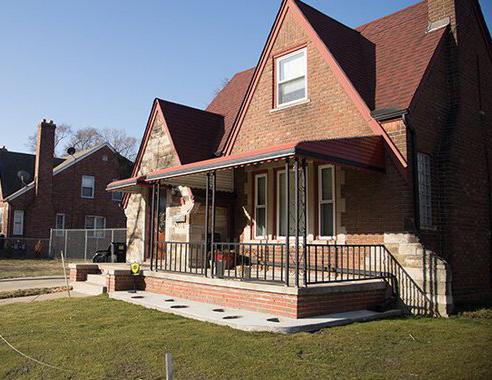 Figure 49. An example is a recently renovated street within the Fitzgerald neighborhood. Source: LISC Detroit.
Figure 49. An example is a recently renovated street within the Fitzgerald neighborhood. Source: LISC Detroit.
4.1.2 Michigan Department of Health and Human Services (MDHHS) Home Repairs Program
The MDHHS provides essential home repair assistance to address immediate threats to health and safety or legal requirements. While the program does not cover non-essential improvements, it offers financial support for energy-related furnace repairs and other nonenergy-related repairs, with lifetime maximums per family group. Eligibility criteria ensure that repairs restore homes to safe and livable conditions, with payments made accordingly.
According to MDHHS:
• “Energy-Related Furnace Repairs are available with a lifetime maximum of $4,000 per family group. All energy-related repairs approved since 1/1/1978 count toward this maximum.
• All non-energy related home repairs, except furnace repair or replacement, including hot water heaters and septic systems for client-owned housing, have a lifetime maximum of $1,500 per family group
Eligibility Criteria
To meet the application qualifications for this grant, homeowners must:
• Applicants must be the owner or purchaser of the home, or hold a life estate on the home with the responsibility for home repairs
• The home is the applicant’s permanent, usual residence
• The home is not listed for sale
• The home is not in jeopardy of loss. Repairs will be denied if there is a house payment or property tax arrearage, unless a workable plan exists for paying the arrearage
• The ongoing cost of maintaining the home is affordable to the applicant (total housing costs cannot exceed 75 percent of the group’s net income)
52 FUNDING ELIGIBILITY AND PRIORITAZATION
4.1.3 Community Development Block Grant (CDBG) Program
The Community Development Block Grant (CDBG) program, operated by the U.S. Department of Housing and Urban Development, provides entitlement grants to local governments for community development activities. In Detroit, CDBG funds have supported home rehabilitation, community facility construction, economic development, and public services. The Neighborhood Opportunity Fund (NOF) program, a component of CDBG, directs resources to public service programs proposed by nonprofit and neighborhood organizations, focusing on education, seniors, recreation, health, and public safety. (Neighborhood Opportunity Fund)
The Community Development Block Grants (CDBG) have historically repaired 200-250 homes annually since the program’s implementation. In 2022, an additional allocation of CDBGs, 500 homes, were repaired for qualifying senior residents of Detroit. This was possible through the Senior Emergency Home Repair (SEHR) program. Each year, these funds are distributed to a variety of public improvement programs. Information on applying for future funding is located on the Detroit website.
Eligibility Criteria
To meet the application threshold for this grant, nonprofit organizations must:
• Meet HUD National Objective (serves low to moderate income individuals)
• Attend NOF application workshop or view webinar Complete and submit proposals) by the deadline
• Read and sign Application Certification forms
• Has a board with at least five (5) members, which meets at least twice a year
• Has 501(c)(3) status prior to applying for proposal Has at least two (2) years of operation and proof of operations
• Has no unresolved government audit and monitoring problems (i.e., tax, legal, etc.)
• Submit most recent fiscal year cash flow statement, financial statement and if available, recent audit
• Submit current Michigan Annual Nonprofit Report
• Applicant’s organization has provided proof of operating cash on hand (at least 7% of the request)
• Submit Recorded Articles of Incorporation (Obtain certificate here)
53 FUNDING ELIGIBILITY AND PRIORITAZATION
Fair Housing Center of Metropolitan Detroit Case Study
An example of CDBG in action is in 2021, the Fair Housing Center of Metropolitan Detroit was awarded $72,945 for providing Detroit residents with on-going fair housing education services to eliminate impediments to fair housing choice and providing equality of housing opportunities for all protected classes and ethnic groups.

Additionally, Morningside residents seeking guidance on home ownership should communicate with Fair Housing Detroit, as they already have homeowner education programs created that may be helpful to the community.
54 FUNDING ELIGIBILITY AND PRIORITAZATION
Figure 50. Fair Housing Center booth promoting homeowner education through Detroit’s NOF, funded through federal CDBGs.
4.2 FUNDING ELIGIBILITY PRIORITAZATION TOOL
This section is dedicated to a detailed examination of the funding eligibility indicators and the methodology utilized for prioritizing allocation within the Morningside neighborhood. This segment aims to provide a comprehensive understanding of how funding eligibility criteria are assessed and prioritized to ensure optimal resource allocation. Within this framework, particular emphasis is placed on the Funding Eligibility Evaluation Tool (section 4.2.2), which delineates the methodology employed to rank and prioritize funding eligibility areas within the neighborhood. Through the systematic application of this tool, stakeholders gain insights into the most pressing needs and strategic avenues for investment, thereby guiding decision-making processes towards impactful community revitalization efforts.
4.2.1 Methodology
This evaluation tool involves evaluating various indicators across different areas in the neighborhood to determine area priorities for funding eligibility. Each indicator is assigned points based on its prevalence within the neighborhood, with the highest percentage receiving the highest point value of 5 and subsequent rankings receiving decreasing points accordingly. Recognizing the significance of particular indicators, the analysis has led to doubling the points assigned to poverty and housing age indicators within the assessment framework. This systematic approach ensures that resources are effectively allocated to areas with the greatest need, promoting equitable housing improvements throughout the Morningside neighborhood while addressing the amplified importance of poverty and housing age within the assessment.
One crucial aspect considered is affordability, measured through the percentage of cost-burdened households with incomes below $75,000, households with members over 65 years old, and families living below the poverty level.
Continuing the assessment, demographics are crucial in determining area priorities for housing interventions. The percentage of homeowners and homeowners aged 65 years and over are key indicators in this evaluation. Each census tract is assigned indicator points based on the prevalence of these demographics within the neighborhood. This comprehensive analysis ensures that housing interventions are tailored to the unique demographics of each area within the Morningside neighborhood, promoting inclusivity and equitable access to housing resources for all residents.
55 FUNDING ELIGIBILITY AND PRIORITAZATION
Area Average CostBurden Owners With Income Less Than $75,000 (%) Indicator Points Cost-Burden Households With Age Over 65 Years (%) Indicator Points Families Income Below Poverty Level (%) Indicator Points (x2) Census Tract 5013 35 1 23 3 28 8 Census Tract 5014 49 3 29 4 14 2 Census Tract 5018 49 4 18 2 26 6 Census Tract 5019 41 2 17 1 28 10 Census Tract 5020 51 5 53 5 22 4 Area Homeowners (%) Indicator Points Homeowners By Age 65 Years And Over (%) Indicator Points Census Tract 5013 50 1 38 4 Census Tract 5014 82 4 26 2 Census Tract 5018 84 5 35 3 Census Tract 5019 61 2 38 4 Census Tract 5020 78 3 18 1
Table 18. Affordability Area Priority Indicators.
Table 19. Demographic Area Priority Indicators.
Furthermore, the condition of the housing stock within each census tract is another critical factor in prioritizing housing interventions. This includes evaluating property crime rates, the percentage of vacant housing units, and the proportion of housing units built in 1939 or earlier. Each indicator is assigned points based on its prevalence within the neighborhood, with higher percentages receiving higher point values. This comprehensive analysis enables targeted interventions to address specific challenges within the Morningside neighborhood’s housing stock, contributing to its revitalization and long-term sustainability.
Following the comprehensive assessment of each census tract, the priority of each area is determined by adding the total points from all categories. Based on this total and considering the indicators, the census tracts are ranked, with the highest-ranking tract receiving the highest priority score of 5. For example, Census Tract 5014 emerges as the top priority area due to its highest total points and significant indicators, indicating urgent attention is required to address various housing challenges, including high-cost burden, elderly households, poverty, property crimes, vacant homes, and aging housing stock. Conversely, Census Tracts 5018 and 5020, with lower total points and minor indicators, are classified as having low priority, suggesting that resources may be better allocated elsewhere. This prioritization approach ensures that limited resources are directed towards areas with the most pressing housing needs, facilitating targeted interventions to enhance community stability and well-being within the Morningside neighborhood.
56 FUNDING ELIGIBILITY AND PRIORITAZATION
Area Property Crimes (%) Indicator Points Vacant Housing Units (%) Indicator Points Housing Units Built In 1939 Or Earlier (%) Indicator Points (x2) Census Tract 5013 74 4 23 4 53 4 Census Tract 5014 72 1 9 1 67 10 Census Tract 5018 75 5 9 2 66 8 Census Tract 5019 73 3 12 3 64 6 Census Tract 5020 73 2 37 5 32 2 Area Total Indicators Points Area Points Area Priority Description Census Tract 5013 29 3 Medium Noticeable need. Some cost-burden, elderly residents, poverty, vacancy. Targeted interventions beneficial. Census Tract 5014 35 5 Highest Highest need. High cost-burden, elderly households, poverty, property crimes, vacant homes, old housing stock. Urgent attention required. Census Tract 5019 31 4 High Significant need. Moderate cost-burden, elderly homeowners, poverty, vacancy, aging homes. Prioritize resources for improvement. Census Tract 5018 & 5020 27 1 Low Minimal need. Few cost-burdened, elderly households, poverty, vacancy. Focus on maintenance and community programs.
Table 20. Housing Stock Area Priority Indicators.
Table 21. Area Priority Assessment.

57 FUNDING ELIGIBILITY AND PRIORITAZATION
Figure 51. Area Priority Assessment Results of Morningside Neighborhood.
4.2.2 Funding Eligibility Indicators
In this section, the analysis shifts focus on funding eligibility indicators for the Morningside community revitalization project. The objective is to provide guidance on identifying areas where the most targeted population may be allocated. Through meticulous examination of requirements for potential additional funding avenues and existing grants within the community, a strategic approach will be outlined. By discerning these indicators, the aim is to facilitate informed decisions regarding resource allocation, ensuring equitable distribution across Morningside while maximizing impact. The subsequent analysis supports these assertions through the utilization of data sourced from the American Community Survey 2022 5-Year Estimates (ACS, 2022), the Social Explorer 2017-2021 5-Year Estimates (Social Explorer, 2021), and the Environmental Systems Research Institute, Inc. (ESRI, 2023).
4.2.2.1 Tenancy
Understanding the distribution of homeowners and renters within each census tract is crucial for evaluating housing needs and accessing funding opportunities in Morningside. This indicator offers valuable insights into residents’ demographic composition and ability to undertake home repairs independently or with assistance. Variations in homeownership rates across different tracts highlight the diverse housing landscape, with some areas boasting a more stable housing market characterized by higher homeownership rates while others have a larger proportion of renters. For example, census tract 5018 exhibits a notably high homeownership rate of 84%, indicating a potentially robust housing market with a significant number of homeowners capable of independent repairs. Conversely, census tract 5019 has a higher proportion of renters at 39%, suggesting a potential need for targeted assistance to support renters in maintaining and enhancing their living conditions. These insights, when compared with the overall homeownership rate in Morningside (71%), indicate a moderate level of housing stability within the neighborhood, slightly
above the county average (64%). Additionally, considering Detroit as a whole, where the homeownership rate is 49%, underscores the disparities across different tracts, highlighting the importance of tailored strategies to address housing needs effectively and ensure equitable access to funding and resources for all residents. Similarly, while Wayne County and Michigan demonstrate homeownership rates consistent with broader state trends, the distribution of homeowners and renters within individual census tracts emphasizes the need for targeted interventions to support diverse communities within Detroit.
58 FUNDING ELIGIBILITY AND PRIORITAZATION
50% 82% 84% 61% 78% 71% 64% 49% 72% 50% 18% 16% 39% 22% 29% 36% 51% 28% Census tract 5013 Census tract 5014 Census tract 5018 Census tract 5019 Census tract 5020 Morningside Wayne County Detroit Michigan Homeowners (%) Renters (%)
Figure 52. Comparison of Tenancy. Source: American Community Survey 2022 5-Year Estimates.
4.2.2.2 Elderly Population
Assessing the percentage of homeowners aged 65 years and over is crucial for understanding the need for accessibility adaptations within housing units in Morningside. As individuals age, they may require modifications to ensure safety and accessibility. Variations exist across different regions, as indicated by the data from the American Community Survey in 2022. Census tracts 5013 and 5019 show relatively high percentages of elderly homeowners, standing at 38%. Conversely, census tract 5020 maintains a lower rate of 18%, suggesting potentially lesser needs for modifications in this region. These findings offer valuable insights into the specific needs within the community, especially when considering the neighborhood’s overall percentage of elderly homeowners (31%) and comparing it to the county and state averages (32%). Furthermore, when considering Detroit as a whole, with an elderly homeowner percentage of 36%, it becomes evident that certain areas may require more focused attention to create age-friendly environments and enhance the quality of life for elderly residents. Understanding these demographics empowers policymakers and community organizations to allocate resources effectively, addressing the unique needs of Morningside’s aging population and fostering inclusivity and accessibility throughout the neighborhood.
59 FUNDING ELIGIBILITY AND PRIORITAZATION
Figure 53. Homeowners by Age 65 years and over. Source: American Community Survey 2022 5-Year Estimates.
38% 26% 35% 38% 18% 31% 32% 36% 32% Census tract 5013 Census tract 5014 Census tract 5018 Census tract 5019 Census tract 5020 Morningside Wayne County Detroit Michigan
4.2.2.3 Property Crimes
Understanding the prevalence of property crimes within the neighborhood is essential for assessing the overall environment and its implications for housing maintenance needs. The property crime rates per 100,000 population exhibit slight variations across census tracts within the Morningside neighborhood, ranging from 2446 to 2526. The property crime rate for the Morningside neighborhood stands at 2484 per 100,000 population. Among the census tracts in Morningside, census tract 5014 exhibits the highest property crime rate (2526), followed closely by census tract 5013 (2485). Conversely, census tract 5018 has the lowest rate (2446). Comparing these rates with Wayne County (2454) and Michigan (1505) reaffirms the neighborhood’s alignment with regional property crime trends. However, it’s noteworthy that Detroit demonstrates a significantly lower property crime rate (1319). These rates offer valuable insights into safety concerns within the community, emphasizing the necessity for targeted interventions to address the underlying social and economic factors contributing to property crimes. Understanding these dynamics enables policymakers and community organizations to implement effective strategies to enhance safety and foster a secure living environment for all residents.
60 FUNDING ELIGIBILITY AND PRIORITAZATION
Figure 54. Property Crimes (Rate per 100,000 Population). Source: Social Explorer, 2021.
2485 2526 2446 2483 2479 2484 2454 1319 1505 Census tract 5013 Census tract 5014 Census tract 5018 Census tract 5019 Census tract 5020 Morningside Wayne County Detroit Michigan
4.2.2.4 Vacancy Rates
The vacancy rate serves as a critical indicator impacting various facets of the neighborhood, from the progressive deterioration of properties to the emergence of a landscape of decline and potential stigma associated with residing in the area. High vacancy rates not only indicate an abundance of unoccupied housing units but also suggest a lack of demand for housing, which can result in neglected properties, decreased property values, and limited economic opportunities within the neighborhood. Data from the American Community Survey 2022 and other sources reveal variations in the percentage of vacant housing units across census tracts within the Morningside neighborhood. Census tract 5020 exhibits the highest vacancy rate at 37%, indicating significant challenges in this area. Conversely, census tracts 5014 and 5018 maintain lower vacancy rates at 9%, suggesting relatively healthier housing markets in these regions. This variation highlights the diverse housing landscape within the community. Furthermore, considering Wayne County, which has a vacancy rate of 11%, and the state of Michigan, with a vacancy rate of 10%, it becomes evident that the Morningside neighborhood may be experiencing a higher concentration of housing vacancies than the county and state averages. Similarly, compared to Detroit as a whole, which has a vacancy rate of 22%, the challenges posed by vacancy rates in the Morningside neighborhood are underscored, emphasizing the importance of targeted interventions to address these issues and promote neighborhood stability and revitalization.

61 FUNDING ELIGIBILITY AND PRIORITAZATION
Figure 55. Vacant Lots in Morningside.
Figure 56. Vacant Housing Units. Source: ESRI, 2023.
11% 11% 10% 22% 37% 12% 9% 9% 23% Wayne County Morningside Michigan Detroit Census tract 5020 Census tract 5019 Census tract 5018 Census tract 5014 Census tract 5013
4.2.2.5 Old Housing Stock
The age of housing units significantly impacts maintenance costs, particularly in older constructions where structural issues may arise, resulting in high repair expenses. Given the demographic profile of the neighborhood consisting of low and middle-income householders, the prevalence of older housing stock exacerbates affordability struggles. Older homes often require more frequent repairs and renovations, posing financial burdens on residents already facing economic challenges. Data from the American Community Survey (2022) and Regrid (2024) reveals variations in the percentage of housing units built in 1939 or earlier across census tracts within the Morningside neighborhood. Census tract 5014 exhibits the highest proportion at 67%, indicating a significant presence of older housing stock prone to maintenance issues. Similarly, census Tract 5018 shows a high percentage at 66%. In contrast, census tract 5020 has a lower rate at 32%, suggesting a comparatively newer housing stock in this area. Comparing these figures with the neighborhood’s overall percentage of housing units built in 1939 or earlier (56%) highlights the diverse housing landscape within the community. Furthermore, when considering Detroit as a whole, which has a percentage of 27% of housing units built in 1939 or earlier, it becomes evident that the
Morningside neighborhood is experiencing a higher concentration of older housing stock. This assessment underlines the challenges posed by aging housing stock in the Morningside neighborhood and emphasizes the importance of targeted interventions to address maintenance issues and enhance affordability for residents.

62 FUNDING ELIGIBILITY AND PRIORITAZATION 19% 19% 14% 27% 32% 64% 66% 67% 53% Wayne
Michigan Detroit Census tract 5020 Census tract 5019 Census tract 5018 Census tract 5014 Census tract 5013
County Morningside
Figure 58. Homes built before 1939 in Morningside Neighborhood.
Figure 57. Housing Units built in 1939 or Earlier. Source: American Community Survey 2022 5-Year Estimates.
4.2.2.6 Affordability Struggles by Middle and Low-Income Households
The affordability struggles of middle and low-income householders are crucial indicators within the neighborhood, given their prevalent demographic profile. High-cost burdens experienced by these residents can indicate the challenges associated with maintaining and repairing the housing stock, particularly for low-income homeowners. Similarly, elevated cost burdens among renters may signify higher rental rates driven by maintenance costs or the need for repairs within rental properties. Data from the American Community Survey 2022 reveals significant variations in affordability struggles among middle and low-income households across census tracts in Morningside.
Census tracts 5014, 5018, and 5020 exhibit notably high average cost burdens among owners with incomes less than $75,000, ranging from 49% to 51%. Additionally, these same Tracts and Tract 5013 demonstrate high average cost burdens among renters in the same income bracket, ranging from 90% to 100%. In contrast, census tract 5019 shows relatively lower percentages of renters facing affordability struggles at 66%. Evaluating these figures with the neighborhood’s overall means reveals the varying degrees of affordability challenges present within different areas of the community. Furthermore, the neighborhood’s affordability struggles exceed Wayne County and Michigan averages for homeowners and renters, indicating the acute affordability issues within the Morningside neighborhood.
63 FUNDING ELIGIBILITY AND PRIORITAZATION
37% 37% 37% 38% 51% 41% 49% 49% 35% Wayne County Morningside Michigan Detroit Census tract 5020 Census tract 5019 Census tract 5018 Census tract 5014 Census tract 5013
Figure 59. Average Cost-Burden Homeowners with Income Less Than $75,000. Source: American Community Survey 2022 5-Year Estimates.
62% 62% 60% 63% 100% 66% 100% 90% 100% Wayne County Morningside Michigan Detroit Census tract 5020 Census tract 5019 Census tract 5018 Census tract 5014 Census tract 5013
Figure 60. Average Cost-Burden Renters with Income Less Than $75,000. Source: American Community Survey 2022 5-Year Estimates.
4.2.2.7 Affordability Struggles by Elderly Households
The affordability struggles of elderly households are paramount for the neighborhood, given their higher maintenance costs due to accessibility adaptations needed with age. As individuals age, housing needs evolve, often requiring modifications for safety and accessibility, which can strain their finances, particularly in areas with older homes. Records from the American Community Survey 2022 reveal variations in affordability struggles among elderly households across census tracts within the Morningside neighborhood. Census tract 5019 displays the lowest percentage of cost-burden households with individuals over 65 years at 17%, indicating relatively better affordability conditions for elderly households. In contrast, census tract 5020 has the highest percentage at 53%, highlighting the significant financial challenges elderly residents face in this area. Linking these figures with the neighborhood’s overall average of 28% provides context for understanding the distribution of affordability challenges among elderly households. The neighborhood’s affordability struggles among elderly households align closely with the county and state averages, underscoring the prevalence of these issues across the region.
Michigan
Wayne County Detroit
Morningside
Census tract 5020
Census tract 5019
Census tract 5018
Census tract 5014
Census tract 5013
64 FUNDING ELIGIBILITY AND PRIORITAZATION
23% 29% 18% 17% 53% 28% 26% 27% 23%
Figure 61. Average Cost-Burden Population with Age over 64 years. Source: American Community Survey 2022 5-Year Estimates.
4.2.2.8 Poverty Level
Understanding poverty levels within the neighborhood provides insights into its residents’ income struggles, which is crucial for developing targeted interventions and support programs. High poverty levels indicate economic hardship, limited resource access, housing stability, and affordability barriers. Records driven from Social Explorer in 2021 expose variations in poverty levels across census tracts within the Morningside neighborhood. Census tracts 5013 and 5019 have the highest percentage of families with income below the poverty level, at 28%. In comparison, census tract 5018 has the lowest rate at 14%, indicating relatively better economic conditions in this area. Contrasting these figures with the neighborhood’s overall poverty level of 24% provides context for understanding the distribution of income struggles within the community.
65 FUNDING ELIGIBILITY AND PRIORITAZATION
28% 26% 14% 28% 22% 24% 15% 32% 10% Census tract 5013 Census tract 5014 Census tract 5018 Census tract 5019 Census tract 5020 Morningside Wayne County Detroit Michigan
Figure 62. Families Income Below Poverty Level. Source: Social Explorer, 2021.
4.3 HOUSING PRIORITY EVALUATION
TOOL
This tool is the final step of this project to evaluate the housing priority within Morningside. The methodology integrates two crucial components: the housing condition evaluation and the funding eligibility evaluation tools.
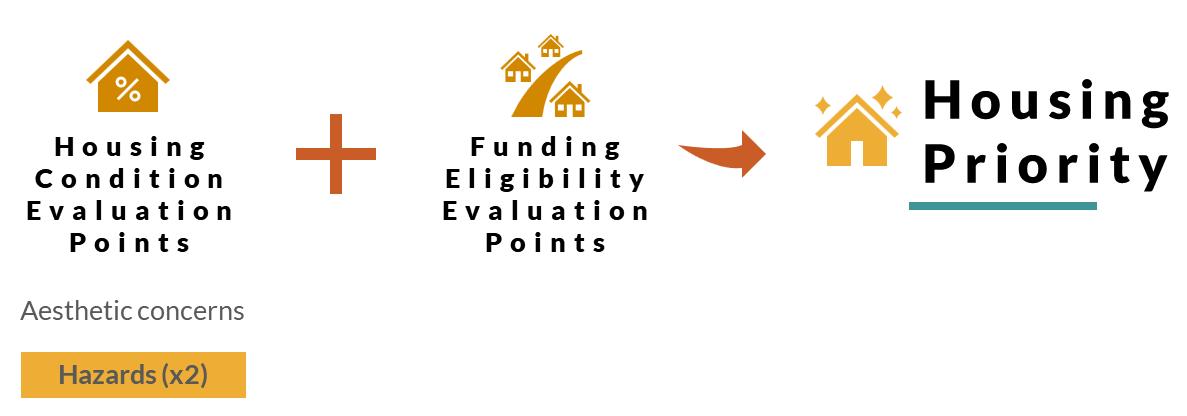
The housing condition evaluation summarizes the findings from the survey, focusing on aesthetic concerns and hazards observed in each housing case. These concerns are quantified with point values, providing a clear indication of the property’s overall condition. For example, the assessment reveals aesthetic concerns and hazards in Example A, resulting in a total point score that categorizes the housing condition as “Poor.”
In this step, the methodology integrates the neighborhood indicators’ area priority results with the housing case assessment (Example A). The neighborhood indicators provide a broader context for understanding each census tract’s specific needs and challenges. The area priority designation for this example is Census Tract 5019, categorized as high, signifies a significant need within the area, encompassing various factors such as cost-burden, elderly residents, poverty, and vacancy.
By aligning the housing case with the neighborhood indicators’ area priority results, stakeholders gain insight into the relative urgency of intervention within the specific context of the housing case’s location. This integration enables informed decision-making regarding intervention strategies and resource allocation, ensuring that targeted interventions are tailored to effectively address the identified needs within the Morningside neighborhood.
66 FUNDING ELIGIBILITY AND PRIORITAZATION
Housing Condition Evaluation House Address Aesthetic concerns Hazards Total Points Housing Condition Description Example A 4.00 7.00 11.00 Poor Major improvements are needed in certain aspects of the home. Funding Eligibility Evaluation House Address Area Total Points Area Priority Description Example A Census Tract 5019 4.00 High Significant Need. Moderate CostBurden, Elderly Homeowners, Poverty, Vacancy, Aging Homes. Prioritize Resources For Improvement.
Table 22. Exterior Conditions Assessment Results.
Figure 63. Housing Priority Evaluation Diagram.
Table 23. Area Priority Assessment Results.
The final stage of this assessment focuses on determining the Housing Priority within the Morningside Neighborhood. This process involves a meticulous methodology to effectively rank and categorize housing cases based on their specific needs. Two primary features, aesthetic concerns and hazards, form the basis of our housing survey. Based on insights from various references and recommendations from the MSU faculty’s guidance, the points assigned to hazards were doubled. This decision underscores the critical importance of this category, given its potential to threaten the physical well-being of residents.
Consequently, the total points for housing priority are derived by adding the aesthetic points, the doubled hazard points, and the area priority points. Integrating neighborhood indicators and housing condition assessments further refines our housing priority rankings. By considering a combination of affordability, demographics, and housing stock conditions, we comprehensively evaluate each housing case’s context.
In addition, the approach for assigning points rank in the housing priority assessment is based on a comprehensive evaluation of housing conditions, neighborhood indicators, and priority areas for funding eligibility within the Morningside Neighborhood. Each point rank reflects a specific combination of factors that collectively determine the urgency and severity of housing needs:
• Top Priority (Points >=25): A top priority designation signifies housing cases with the most urgent needs. For a case to be considered a top priority, it must meet minimum requirements, such as having the highest points of hazards (24), our primary concern for intervention. Additionally, it could be situated in the lowest priority area, earning 1 point, thereby totaling 25 points. This combination of hazard levels and low-priority neighborhood designation highlights the critical need for immediate action to address significant resident well-being and safety risks.
• High Priority (Points 17-24): High-priority housing cases represent substantial needs that require prompt attention. To qualify as high priority, a case typically exhibits major deterioration in hazards, earning hazard points nearing the maximum (16). Additionally, it may be located in a neighborhood with a low-priority designation, receiving 1 point. This combination underscores the urgency of addressing major hazards and significant community needs.
Noticeable need. Some cost burdens are elderly households, poverty, and vacancies. Consider moderate repairs or renovations.
Minimal need. Few cost-burdened elderly households, poverty, and vacancy. Focus on minor repairs or maintenance. <=5
• Medium Priority (Points 10-16): Medium priority cases denote noticeable needs that warrant targeted interventions. These cases often present extreme deterioration in aesthetic concerns, earning near-maximum aesthetic points (9). While not as severe as top or high-priority cases, they still require attention due to moderate housing conditions and people’s needs. Additionally, they may be situated in neighborhoods with low priority scores, earning 1 point. This combination justifies a medium-priority designation.
67 FUNDING ELIGIBILITY AND PRIORITAZATION
Points Rank Housing Priority Description >=25 Highest
17-24 High Significant
10-16 Medium
The highest need is extreme deterioration, a high cost burden, elderly households, poverty, property crimes, vacancy, and old housing. It is urgent; major improvement or demolition is needed.
need. Moderate-cost burden, elderly residents, poverty, vacancy, aging homes. Prioritize major repairs or renovations.
Low
<=9
None Negligible
need. Minimal housing deterioration.
Table 24. Housing Priority Rank.
• Low Priority (Points <=9): Low priority housing cases indicate minimal needs that can be addressed through routine maintenance. These cases typically exhibit less extreme deterioration in aesthetic concerns, with aesthetic points totaling less than 9. Given their relatively minor needs and higher community priority scores, they receive lower priority designations.
• None (Points <=5): This priority rank indicates negligible need for intervention. Properties in this category exhibit minimal housing deterioration and have minor aesthetic concerns. The area where these properties are situated typically holds low priority for immediate attention.
The resulting housing priority rank, as outlined in the accompanying data, reflects a nuanced understanding of the diverse needs and challenges present in the Morningside Neighborhood. This approach pretends to enable the community to strategically allocate resources and interventions strategically, maximizing their impact and fostering community well-being.
For instance, the results, for example, A, indicate 22 points (Aesthetic Concerns 4 points plus Hazards 14 points (7 points per two) plus Area Priority 4 points), reflecting a high housing priority designation. This term signifies a substantial need within the property, characterized by moderate-cost burden, elderly residents, poverty, vacancy, and aging homes. The recommendation is to prioritize major repairs or renovations to address these pressing needs effectively.
It’s essential to emphasize that this assessment tool serves as a reference or guide for Morningside authorities to understand the neighborhood’s necessities better. By providing a structured methodology for assessing housing conditions and prioritizing interventions, this tool facilitates informed decision-making and resource allocation to address the diverse challenges present in the community.
Assessing housing priorities within the neighborhood has been a comprehensive endeavor to understand the current state of residential properties. Through rigorous data collection and analysis, the following results have been obtained for the sample area (Census Tract 5019):
68 FUNDING ELIGIBILITY AND PRIORITAZATION
Housing Priority Result House Address Total Points (Hazards x2) Housing Priority Description Example A 21 High Significant need. Moderate-cost burden, elderly residents, poverty, vacancy, aging homes. Prioritize major repairs or renovations.
25.
Table
Housing Priority Assessment.
Housing Conditions Lots % Highest 7 1 High 16 1 Medium 78 7 Low 237 21 None 612 55 Vacant 132 12 Not Residential 29 3 Total 1111 100
Table 26. Results of Housing Priority Assessment in Census Tract 5019.
These results provide an overview of the distribution of housing priorities within the Morningside neighborhood. It is evident that a significant portion of properties either have no identified priority or are vacant, indicating pressing needs for intervention and revitalization efforts. By understanding the distribution of priorities, stakeholders can strategically allocate resources and prioritize interventions to address the most critical housing rehabilitation and repair issues. These results will serve as a foundational component in formulating a three-year housing plan that aligns with community needs and organizational capacities while leveraging available funding sources effectively.

69 FUNDING ELIGIBILITY AND PRIORITAZATION
Figure 64. Housing Priority Assessment Results of Census Tract 5019.
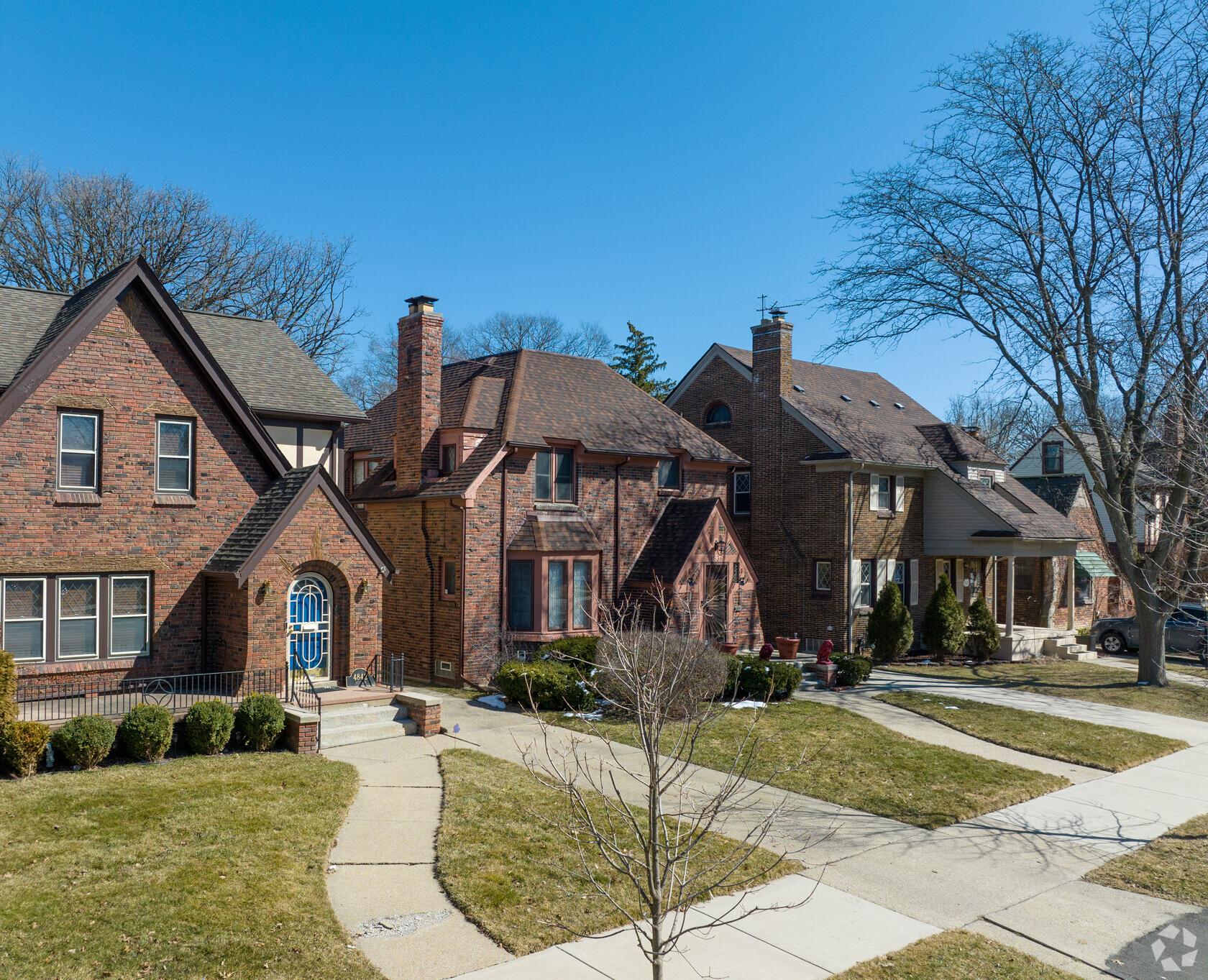
V. MORNINGSIDE RECOMMENDATIONS
Chapter V of the project delineates the Housing Revitalization Strategy, focusing on community engagement and resource allocation. It advocates for an inclusive approach, with strategies to inform residents about housing conditions, expand assessment evaluations, and apply for funding. The Housing Revitalization Strategy underscores the significance of sharing information, continuing assessment evaluations, and replicating successful practices with new funding sources. It aims to empower residents through specific tools and information dissemination, fostering active participation in revitalization efforts. In addition, The Morningside Housing Toolkit includes databases for housing conditions evaluation and prioritization, a GIS project for mapping housing results, video tutorials on database and GIS usage, and a handbook for residents on assessing home conditions. These resources aim to empower administrators and residents alike, facilitating informed decision-making and efficient allocation of resources for housing revitalization efforts in Morningside.
V
Figure 65. Morningside neighborhood. Photo by Homes.com
CHAPTER
5.1 MORNINGSIDE HOUSING REVITALIZATION STRATEGY
To enhance the clarity and accessibility of this section, we have included two video tutorials and one handbook provided in the Toolkit presented under separate cover. These resources are instrumental in supporting the implementation of the proposed strategies. The first recommendation involves initiating communication efforts to inform residents about assessing their housing conditions using project guidelines. To achieve this, the “ How to evaluate the conditions of your home “ serves as a practical handbook offering step-by-step instructions and criteria for property evaluation. This guide empowers residents to make informed decisions regarding repairs or improvements. Additionally, expanding neighborhood initiatives to cover the entire area is recommended. U-SNAP-BAC and Morningside Community Organization can utilize two key tutorials from the toolkit: the “How to Use Housing Prioritization Evaluation Database” and the “How to Use QGIS to Map Housing Results” tutorials. These resources equip administrators with essential skills to assess housing priorities effectively and visualize results, fostering inclusive community engagement and funding application efforts. Finally, consider replicating successful practices by applying for recommended funding sources outlined in this paper. It is suggested that the Funding Eligibility Evaluation Tool be used to identify targeted populations that align with funding requirements for strategic resource allocation.
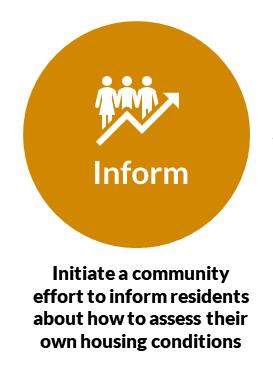

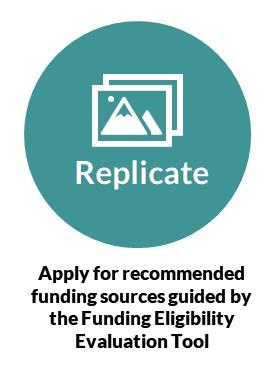
72 MORNINGSIDE RECOMMENDATIONS
Figure 66. Morningside Funding Housing Priority Strategy Diagram.
 Figure 67. A neighbor and her house in Morningside. Photo by Morningside Newsletter.
Figure 67. A neighbor and her house in Morningside. Photo by Morningside Newsletter.

5.1.1 Inform: Sharing Information

Initiate a neighborhood-wide communication strategy to inform residents about how to assess their own housing and identify and evaluate their housing conditions using the project’s newly developed guidelines. This recommendation can be effectively implemented by using the “How to evaluate the conditions of your home” handbook, facilitating targeted outreach to the Morningside neighbors and dissemination of information through social media (newsletter and website), community flyers, and worth of mouth promotion.
What

We developed these guidelines presented in a separate handbook to provide practical assistance for residents to conduct thorough self-assessments of their homes’ conditions. Developed through insights gained from the housing condition survey conducted in the assessment section of this paper, this resource offers step-by-step instructions and criteria for evaluating different aspects of a property. By following this guide, residents can recognize damage and areas needing attention, leading to informed decisions on how to prioritize e repairs or improvements in their homes.
is the “How to evaluate the conditions of your home” handbook?
Figure 68. Community Participation. Photo by Jaime Lopes on Unsplash.
How can Morningside achieve this recommendation?
Two targeted actions are identified considering the neighborhood’s current resources. These actions aim to leverage existing strengths and infrastructure to enhance community engagement and participation in housing assessments and revitalization efforts:

Organize a “How to evaluate the conditions of your home” Workshop
To bolster community engagement and empower residents with essential practical skills, U-SNAP-BAC and Morningside Community Organization could host a workshop focused on “How to Evaluate the Conditions of Your Home.” This workshop will be based on the handbook developed by team. Facilitators could guide attendees step-by-step through the handbook, demonstrating how to assess their homes effectively. This hands-on approach will enable participants to gain confidence in using the home assessment guide and prioritize essential repairs or improvements. Resources needed for this initiative may include:
a) Venue: Access to a suitable venue for hosting community meetings and workshops, preferably in the Morningside neighborhood for accessibility.
b) Promotion and Outreach: Strategies for promoting the workshops to residents, including digital marketing (Morningside newsletter and website), flyers, and word-of-mouth promotion within the community.
c) Evaluation and Feedback Mechanism: Implementation of a system to gather feedback from workshop participants to assess the effectiveness of the sessions and identify areas for improvement.

Organize a “How to evaluate the conditions of your home” Neighborhood Walks
Neighborhood walks offer an opportunity for residents to actively engage with their community and participate in the process of identifying aesthetic concerns and hazards within the neighborhood. By organizing these walks, U-SNAP-BAC and Morningside Community Organization can create a platform for residents to come together, share their perspectives, and contribute to the general knowledge about how to evaluate the housing conditions of their community. Resources needed for this initiative may include:
a) Preparation and Planning: Select suitable days and times for the neighborhood walks, considering residents’ availability and preferences. Identify a block or set of blocks in each of the areas proposed in this project to focus on for the walks.
b) Community Engagement: Promote the neighborhood walks through various channels, including social media, flyers, and the community newsletter. Encourage residents to participate and emphasize the importance of their input in improving housing conditions within the neighborhood.
c) Facilitation and Guidance: During the walks, designate knowledgeable facilitators or representatives from U-SNAP-BAC and Morningside Community Organization to lead the discussions and help participants identify common issues and potential enhancements.
d) Documentation and Feedback: Encourage residents to actively observe and take note of any housing challenges or improvement opportunities they identify during the walks. Provide feedback forms or digital platforms for residents to share their observations and suggestions for addressing identified issues.
75 MORNINGSIDE RECOMMENDATIONS
5.1.2 Expand: Continue Housing Assessment Evaluation and Fundings Application

Expanding neighborhood initiatives beyond Census Tract 5019 to cover all of Morningside is recommended. This expansion would provide a complete assessment of housing conditions and priorities across all areas. To support this endeavor, it is recommended to use two key tutorials in the housing toolkit provided to Morningside: the “How to Use Housing Prioritization Evaluation Database” tutorial and the “How to Use QGIS to Map Housing Results” tutorial. By providing administrators from U-SNAP-BAC and Morningside Community Organization with the necessary skills and resources, this expansion can be effectively implemented, fostering inclusive community engagement and funding application efforts throughout Morningside.
What is the “How to Use Housing Prioritization Evaluation Database” tutorial?

The “How to Use Housing Prioritization Evaluation Database” tutorial offers a comprehensive guide for administrators to navigate the housing prioritization evaluation database. It provides step-by-step instructions on data entry, filtering, sorting, and generating results. By leveraging this resource, administrators can make informed decisions and drive community revitalization efforts in Morningside.

76 MORNINGSIDE RECOMMENDATIONS
Figure 69. Training Participation. Photo by Jason Goodman on Unsplash.
What is the
to Use QGIS to Map Housing Results” tutorial?

Organize

The “How to Use QGIS to Map Housing Results” tutorial is a practical guide developed as part of the housing toolkit provided to Morningside. This tutorial equips administrators with the skills needed to utilize QGIS, a free geographic information system software, to visualize the results of the housing priority evaluation tool. It provides step-by-step instructions on how to add additional information to the file developed by the project, customize symbology, and generate informative maps. By following this tutorial, administrators can effectively visualize and analyze the results of the housing priority evaluation tool, facilitating informed decisionmaking and targeted community revitalization efforts in Morningside.
How can Morningside achieve this recommendation?
Two specific actions have been identified, considering the neighborhood’s current resources and strong sense of community. These actions seek to capitalize on existing neighborhood strengths as strong sense of community, robust website and bunch of resources as other studies within the neighborhood:
Through the tutorials provided as part of the toolkit, administrators can learn how to use the tools to evaluate housing priority and organize a workshop with their team members to make practical examples as a rehearsal and strengthen their knowledge. With the two video tutorials already prepared as part of the project deliverables, participants may receive training on using the housing priority assessment database and mapping results in QGIS. This hands-on approach, coupled with practical examples addressed during the workshop, can potentially enhance U-SNAP-BAC members’ capacity to contribute effectively to housing revitalization efforts in Morningside. Additionally, this workshop can be repeated for future volunteers or administrators. The following resources are recommended to safeguard the successful completion of this step:
a) Documentation of Training Materials: Gather and document training materials used in previous housing assessment training sessions, including presentations, guides, and tools utilized during hands-on exercises.
b) Standardization of Procedures: Define standardized procedures for conducting housing assessment training sessions, outlining key objectives, timelines, and evaluation criteria to ensure consistency across sessions.
c) Feedback and Continuous Improvement: Solicit feedback from participants and trainers after each housing assessment training session to evaluate effectiveness and identify areas for improvement. Use feedback to refine training materials and procedures continuously.
77 MORNINGSIDE RECOMMENDATIONS
“How
a “How to evaluate the conditions of your home” Workshop

Use Housing Condition and Prioritization Tools for Funding Assignment
Through the tutorials provided as part of the toolkit, administrators can learn how to use the tools to evaluate housing priority and organize a workshop with their team members to make practical examples as a rehearsal and strengthen their knowledge. With the two video tutorials already prepared as part of the project deliverables, participants may receive training on using the housing priority assessment database and mapping results in QGIS. This hands-on approach, coupled with practical examples addressed during the workshop, can potentially enhance U-SNAP-BAC members’ capacity to contribute effectively to housing revitalization efforts in Morningside. Additionally, this workshop can be repeated for future volunteers or administrators. The following resources are recommended to safeguard the successful completion of this step:
a) Documentation of Training Materials: Gather and document training materials used in previous housing assessment training sessions, including presentations, guides, and tools utilized during hands-on exercises.
b) Standardization of Procedures: Define standardized procedures for conducting housing assessment training sessions, outlining key objectives, timelines, and evaluation criteria to ensure consistency across sessions.
c) Feedback and Continuous Improvement: Solicit feedback from participants and trainers after each housing assessment training session to evaluate effectiveness and identify areas for improvement. Use feedback to refine training materials and procedures continuously.
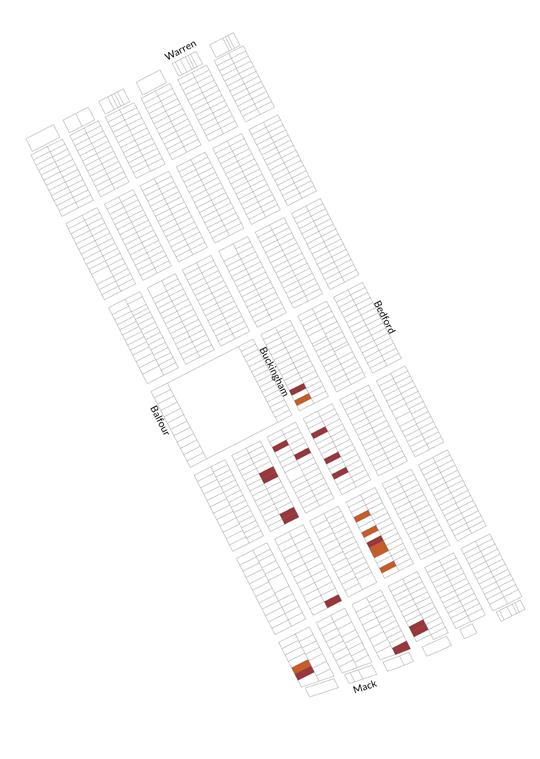


23 Houses
The houses shown in the diagram (highest and high priority) could be tackled in the first year of funding execution.
78 Houses
The houses shown in the diagram (medium priority) could be tackled in the second to fifth years of funding execution.
237 Houses
Short Term Medium Term Long Tem
The houses shown in the diagram (low priority) could be tackled after the fifth year of funding execution.
78 MORNINGSIDE RECOMMENDATIONS
Figure 70. Sample Area Housing Priority Schedule Diagram.
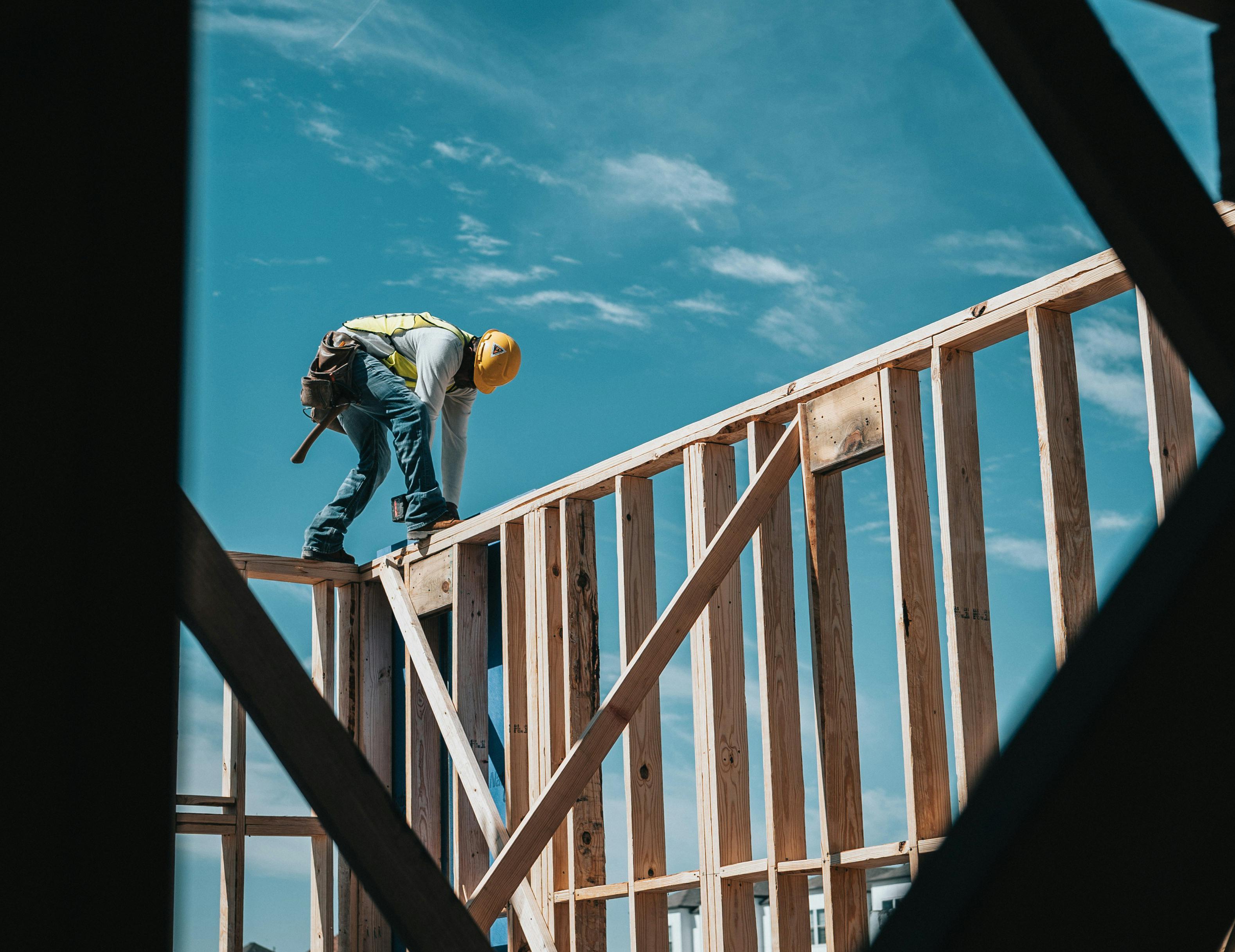 Figure 71. Housing Construction. Photo by Josh Olalde on Unsplash.
Figure 71. Housing Construction. Photo by Josh Olalde on Unsplash.

5.1.3 Replicate: Maintain Successful Practices with New Funding Sources
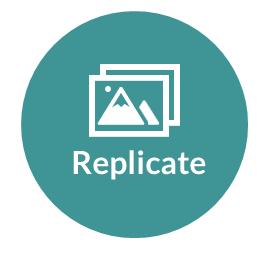
As a strategic move forward, it is advised to replicate successful practices with new funding sources. This entails applying for recommended funding sources outlined in this paper and utilizing the Housing Prioritization Evaluation Tool to identify targeted populations aligning with funding requirements. By doing so, strategic resource allocation can be ensured, maximizing the impact on housing revitalization efforts. This recommendation emphasizes the importance of maintaining successful practices while capitalizing on additional resources to drive sustained progress in the community

The Housing Prioritization Evaluation Tool for Morningside analyzes critical indicators such as target demographics, housing stock, and affordability to pinpoint appropriate funding sources. Customized to meet Morningside’s needs, it identifies areas where resources are most needed and is a visual reference for the grant funding. This tool has the potential to enhance decision-making by providing valuable insights and optimizing the use of available funding sources for home repair development efforts.
Figure 72. Housing Development. Photo by Alexander Andrews on Unsplash.
What is the “Housing Prioritization Evaluation” Tool?
How can Morningside achieve this recommendation?
Two specific actions have been identified, leverage the neighborhood’s inherent strengths in housing revitalization efforts:

Utilize Housing Prioritization Evaluation Tool for Fundings Allocating Reference
By using the Housing Prioritization Evaluation Tool for new funding sources, Morningside could optimize resource allocation. This tool provides a systematic approach to assess eligibility criteria for various funding sources, enabling targeted identification of populations and areas most in need of support. Through this process, community leaders can prioritize initiatives that align closely with the community’s needs and priorities, ensuring that funding efforts are directed where they will have the greatest impact. By streamlining the allocation process and focusing resources on the most eligible populations, Morningside can maximize the effectiveness of its funding initiatives, leading to more efficient and sustainable outcomes in community development and revitalization efforts.
a) Highest Priority: This designation highlights the population most critical for meeting funding requirements, representing areas with the highest concentration of vulnerable residents in urgent need of resources. U-SNAP-BAC and Morningside Community Organization should prioritize funding for these properties, aiming to address them within the first year to provide immediate assistance to those most in need.
b) High Priority: While not as urgent as the highest priority category, this area still requires prompt attention due to significant funding needs. Following the highest priorities, U-SNAP-BAC and Morningside Community Organization should address properties in this category shortly, aiming for repairs within the first year.
c) Medium Priority: Homes with moderate deterioration and primarily aesthetic concerns. These properties can be addressed within a medium-term timeframe, spanning from two to five years, given they do not pose significant hazards.
d) Low Priority: This area comprises homes with minimal funding needs; some may have the resources to address repairs independently. Special cases can be addressed over a longer-term period exceeding five years, allowing U-SNAP-BAC and Morningside Community Organization to prioritize more pressing needs while still addressing unique situations as they arise.
81 MORNINGSIDE RECOMMENDATIONS
For example, considering the current data and the indicators for funding eligibility, the following schedule is a reference to know where U-SNAP-BAC and Morningside Community Organization the funding could be allocated based on the amount of funding eligibility population are likely living:
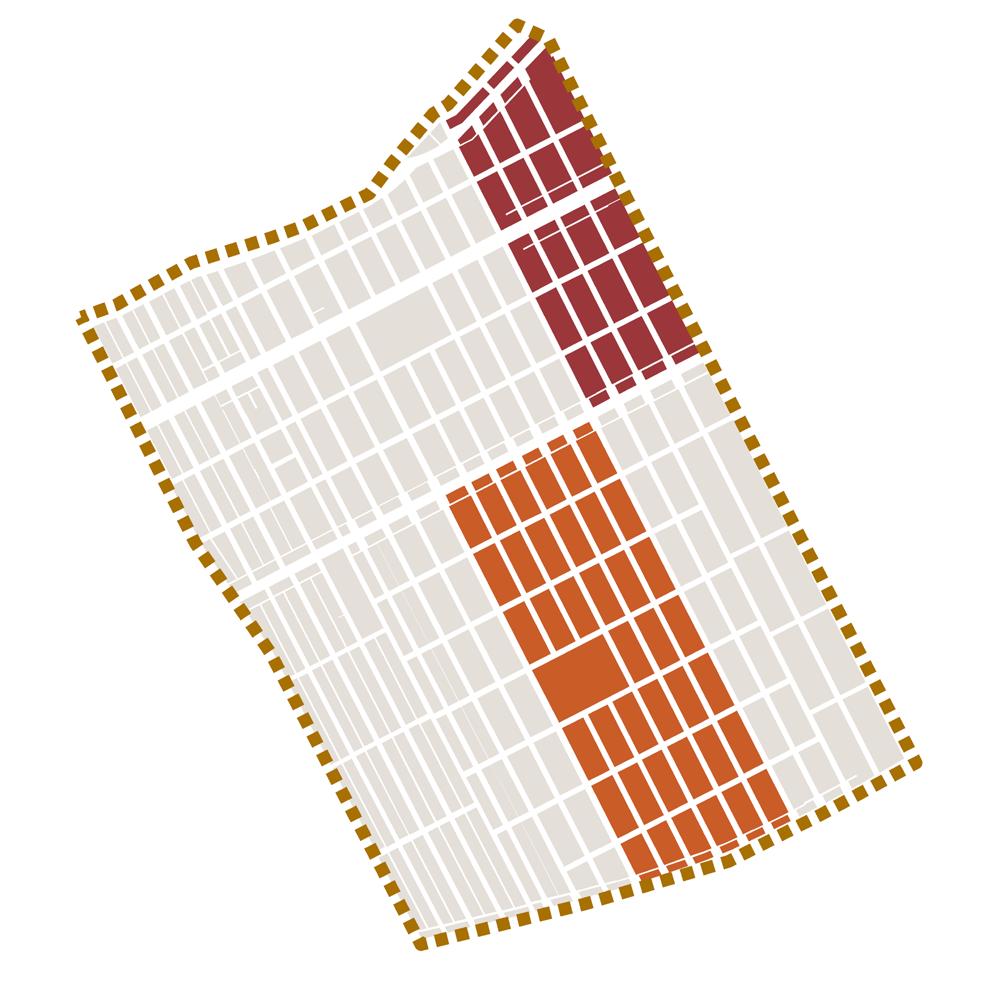
Short Term
The areas shown in the diagram (highest and high funding eligibility priority) could be tackled in the first year of funding application because they are likely to contain a significant population that fits most of the funding sources’ requirements.
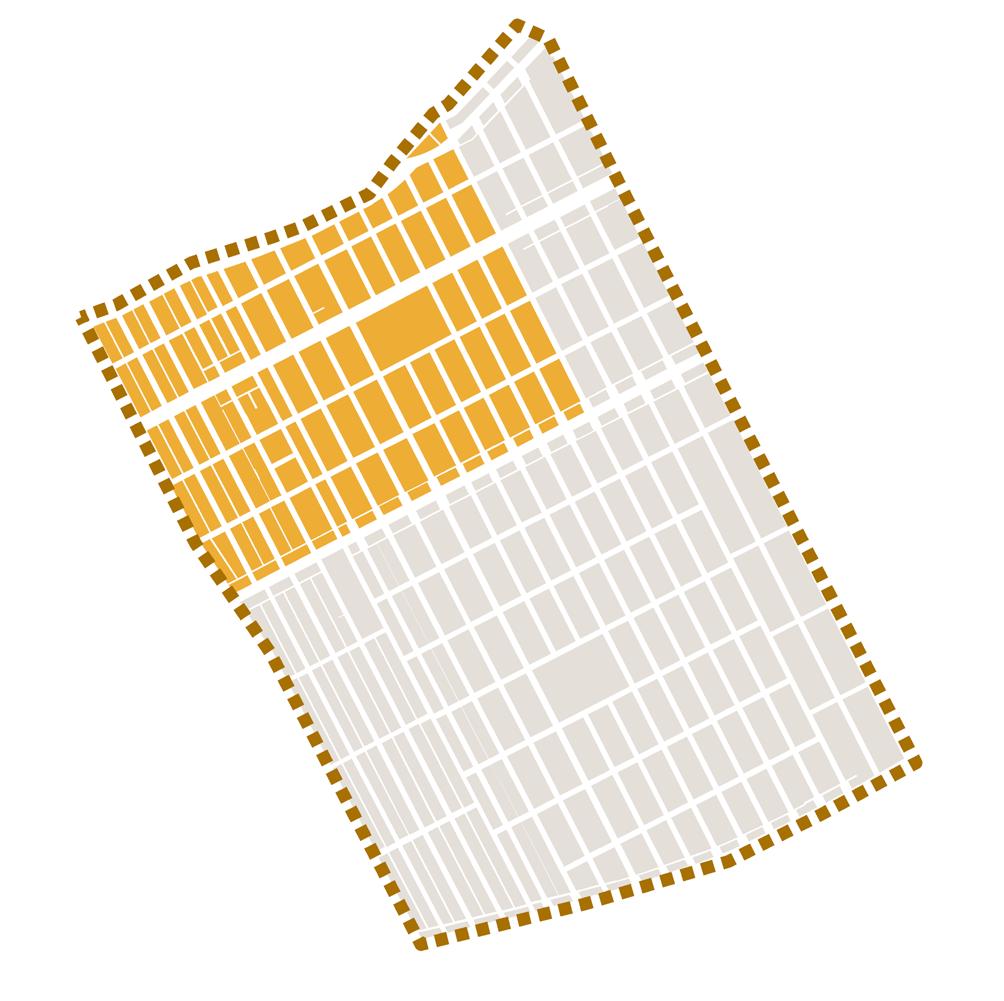
Medium Term
The areas shown in the diagram (medium funding eligibility priority) could be tackled in two to five years in the funding application process because they likely contain a significant population that fits some of the funding sources’ requirements.
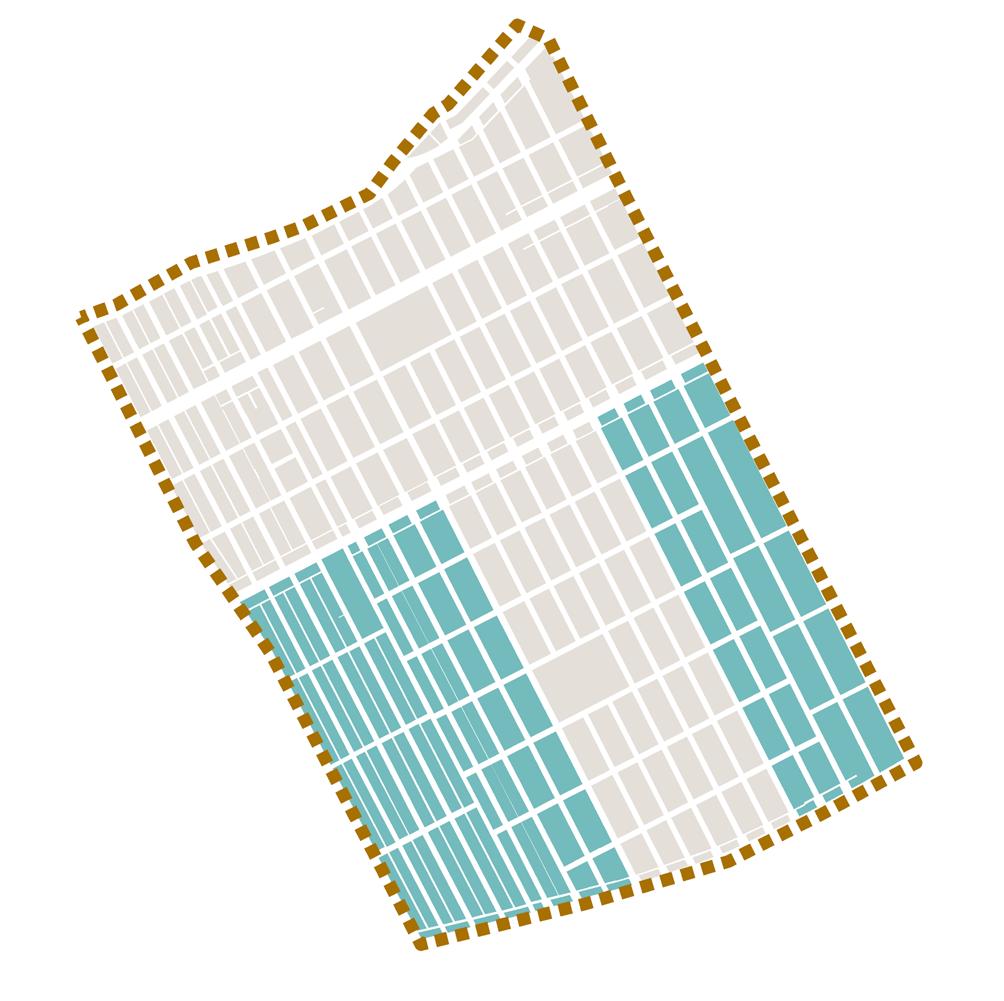
Long Tem
The areas shown in the diagram (low funding eligibility priority) could be tackled in more than five years in the funding application process because they likely contain a minimal population that fits most of the funding sources’ requirements.
82 MORNINGSIDE RECOMMENDATIONS
Figure 73. Morningside Funding Eligibility Prioritization Schedule Diagram.

Continuously Update Funding Eligibility Evaluation Tool’s Indicator Data
The recommended action entails continuously updating the data of the Housing Prioritization Evaluation Tool, as outlined in the “How to Use Housing Prioritization Evaluation Database” tutorial. This process ensures the tool remains accurate and reliable by incorporating the latest information from official sources or neighborhood surveys. This proactive approach helps to maintain the tool’s effectiveness in guiding resource allocation decisions and supports informed decision-making for housing revitalization efforts in the neighborhood. The following resources could be considered for the updating effort:
a) Access to reliable, up-to-date data sources is vital. This may include:
• American Community Survey (5-Year Estimates)
• Social Explorer
• Environmental Systems Research Institute, Inc.
• Regrid, Nationwide Land Parcel Data & Location Context
• Data Driven Detroit
b) Survey Tools: Tools and methodologies for conducting neighborhood surveys to gather firsthand data on housing conditions, demographics, and community needs.
c) “How to Use Housing Prioritization Evaluation Database” tutorial provided in the toolkit.
 Figure 74. Data Updating. Photo by Campaign Creators on Unsplash.
Figure 74. Data Updating. Photo by Campaign Creators on Unsplash.
5.2 MORNINGSIDE HOUSING TOOLKIT
In this section, we introduce the Morningside Housing Toolkit, a comprehensive set of tools developed during the project. These tools were crafted through the evaluation of neighborhood housing and socioeconomic data, as well as insights from our community partners, U-SNAP-BAC and Morningside Community Organization. While the detailed toolkit is presented separately, here, we provide a concise overview and list of resources aimed at enhancing the potential for successful housing revitalization in Morningside.
5.2.1 Databases
• Morningside Regrid Data

This database contains comprehensive information from Regrid’s Land Data specifically tailored for the Morningside neighborhood. It includes addresses of all parcels within the neighborhood, zoning details, tax information, and other pertinent data crucial for administrators of Morningside, such as U-SNAP-BAC and Morningside Community Organization. This database pretends to be a valuable tool to support the housing revitalization effort in Morningside.
• Morningside Housing Conditions Evaluation Tool
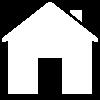
This database encompasses the format of the housing condition survey, displaying the outcomes of home assessments. It integrates the evaluation of aesthetic concerns and hazards, providing a result of the condition of each property within the neighborhood.

• Morningside Housing Prioritization Evaluation Tool
This database simplifies the housing priority evaluation process for neighborhood administrators. By inputting the results of the housing condition evaluation, administrators can swiftly determine which homes should receive priority for funding resources based on predefined criteria. Additionally, the tool provides indicators for assessing funding eligibility priority areas, offering insights into the criteria and facilitating easy updates. This comprehensive resource streamlines decision-making and ensures efficient allocation of resources for housing revitalization efforts in Morningside.
5.2.2 GIS Project
• Morningside QGIS Project

This project is designed within the QGIS software, a free Geographic Information System (GIS), providing administrators with a user-friendly platform to visualize the results of the housing prioritization evaluation. It offers a convenient way to update and analyze new evaluation results for areas beyond the sample area addressed in this project. This tool empowers administrators to efficiently manage and visualize housing data, facilitating informed decision-making for housing revitalization efforts in Morningside.
84 MORNINGSIDE RECOMMENDATIONS
5.2.3 Video Tutorials

You can also see the tutorial by scanning the following code:

• How to Use Housing Prioritization Evaluation Database
Previously explained. This tutorial is specifically designed to train administrators from U-SNAPBAC and Morningside Community Organization in utilizing the Housing Prioritization Evaluation Database. It provides step-by-step guidance on navigating the database, entering data, and interpreting results. Accessible via the provided web address, this video equips administrators with the necessary skills to effectively prioritize housing interventions and allocate resources strategically in Morningside.
Link: https://youtu.be/nSpbFgM5M-0?si=IkC5H1rGIssQUB0

You can also see the tutorial by scanning the following code:

• How to Use QGIS to Map Housing Results
Previously explained. This tutorial is tailored to train administrators from U-SNAP-BAC and Morningside Community Organization in utilizing the Morningside QGIS project. It offers comprehensive instructions on utilizing QGIS software to map housing results effectively. Accessible via the provided web address, this video equips administrators with the skills needed to visualize and analyze housing data, facilitating informed decision-making for housing revitalization efforts in Morningside.
Link: https://youtu.be/ascDJz4voo?si=M4DGwaHXDH7Ragz2
5.2.4 Handbook
• How to evaluate the conditions of your home

You can also see the handbook by scanning the following code:

Previously explained. This comprehensive handbook serves as a step-by-step guide for residents to effectively utilize the housing condition survey for assessing their homes. Designed to be accessible and informative, this handbook equips residents with the necessary skills to conduct thorough assessments of their properties. By following the instructions provided, residents can identify areas needing attention and prioritize repairs or improvements. Accessible via the provided web address, this resource empowers residents to contribute actively to housing revitalization efforts in Morningside.
Link: https://issuu.com/escarlethcucurachiortega/ docs/how_to_evaluate_the_conditions_of_your_ home_handbo?fr=xKAE9_zU1NQ
85 MORNINGSIDE RECOMMENDATIONS

VI. ADDITIONAL RECOMMENDATIONS
Morningside has several opportunities to promote community wide revitalization with a hands-on approach. These improvements include establishing a permanent cleanup committee and forging partnerships with organizations to target blight and enhance the communities visual aesthetics. Repurposing structures for affordable housing, as seen with projects like The Ribbon, can address housing needs and stimulate economic growth. Encouraging homeowners to acquire adjacent vacant lots through programs like the Land Bank Side Lot Program can increase property values and beautify the area. Additionally, expanding community garden initiatives and utilizing vacant lots for green spaces can promote environmental sustainability and strengthen community bonds. These recommendations for vitality improvements delve into the transformative potential of connecting communities for a more resilient future.
VI
Figure 75. Jefferson Branch Library in Morningside. Photo by Homes.com.
CHAPTER
6.1 NEIGHBORHOOD VITALITY IMPROVEMENT
6.1.1 Recommendation 1: Establish Simple Rules for Home Repair Expenses
To streamline home repair expense guidelines for residents, U-SNAPBAC and Morningside’s Board of Directors could explore distinct methodologies, with two recommended approaches: the percentage rule and the square footage rule.
a) The Percentage rule:
The percentage rule suggests allocating a specific percentage of the home’s total value annually for maintenance needs. For example, residents could earmark up to 4% of their home’s total value yearly for repairs (Beauchamp, 2023). This approach provides a clear mechanism for budgeting maintenance costs tied to property value, fostering responsible homeownership and preserving property values over time.
b) The square footage rule:
This rule proposes setting a maximum repair budget based on property size. Administrators would allocate a fixed dollar amount per square foot, determining the overall repair budget by multiplying the square footage by the established rate (Beauchamp, 2023). This method offers a standardized means of calculating repair expenses, ensuring impartial access to funding resources for all residents and promoting fairness and transparency in resource allocation.
Both the percentage rule and the square footage rule offer valuable frameworks for guiding residents’ spending decisions on home repairs in Morningside. By carefully considering the merits of each approach and community dynamics, the neighborhood can establish clear and effective guidelines that support responsible homeownership and equitable resource access.
6.1.2 Recommendation 2: Neighborhood Clean-up and Restoration
Residents in Morningside could consider implementing a neighborhood permanent clean up committee that specifically targets areas in the neighborhood in high need of improvement projects. Morningside currently has a 17% vacancy rate, where much of these lots are either left unoccupied or owned by the Detroit Land Bank. Many of these vacant lots are left unmaintained, some of which endure illegal dumping which has been an ongoing issue in Morningside. Initiating a neighborhood clean-up program could help increase a sense of community and bring pride to residents through community enhancement efforts.
The Morningside community has recently taken proactive steps to address blight within the neighborhood, as evidenced by the formation of the Morningside Blight Brigade. In partnership with Emerald Isles, this initiative aims to harness the collective power of residents in combating blight. The Blight Brigade seeks to streamline the blight removal process and conduct regular neighborhood clean-up activities. Through coordinated reporting via platforms like SeeClickFix.com and the Improve Detroit app, along with educational outreach on relevant ordinances, the group intends to tackle various blight-related challenges such as illegal dumping and neglected properties. Currently, Morningside conducts two cleanups each year with Emerald Isles. The community could consider expanding resident participation as well as strengthening their current partnership and expanding their community partnerships to increase the frequency of clean-ups. This could result in the amplification of aesthetic revitalization within Morningside. Building new partnerships with organizations like Emerald Isles would also be beneficial to ramp up resources and participation. (Newell, 2024)
88 ADDITIONAL RECOMMENDATIONS
To help revitalize the community, residents should have access to the necessary tools needed to help enhance the quality of the neighborhood. Providing homeowners with access to tools and equipment alleviates financial burdens and offers a low-cost option for residents to engage in cleanup efforts in a timely manner. A potential remedy for this issue could be implementing a community tool shed, similar to the Edison Neighborhood Association Community Tool Shed in Kalamazoo, Michigan. The Edison Neighborhood Toolbox provides an easy and inexpensive way for residents to use tools for community clean-up. Residents can rent out tools needed for free.

6.1.3 Recommendation 3: Redevelopment Initiatives
The J.E. Clark Preparatory Academy could be reused and redeveloped into multi-family affordable housing in Morningside. Housing affordability in Detroit has been an ongoing issue, and providing more affordable housing in the area could help alleviate the financial struggles within the housing market. The J.E. Clark Preparatory Academy, located in the south central part of Morningside, is facing possible closure within the next four years. Possible closure of this property will leave this structure unoccupied, allowing possible future opportunities for reuse and redevelopment projects. Currently, the former St. Matthew School, located in Morningside just south of Harper, is being reconfigured into affordable housing, and The Ribbon project located in East English Village, the neighborhood adjacent to Morningside, will also provide mixed-use affordable housing along the commercial strip off of the East Warren Corridor.
To help revitalize the neighborhood, the community should have the necessary funding in order to initiate redevelopment projects. The Ribbon project is currently funded by the Strategic Neighborhood Fund and Detroit Housing for Future Fund. This project seeks to revitalize a previously vacant property in the hopes of catalyzing economic growth and community cohesion along the East Warren Commercial Corridor. Many residents in Morningside are considered low-income and these current projects strengthen the desirability for future redevelopment and reutilization within the neighborhood. For instance, the Ribbon program is located at 16530 East Warren Avenue in the East English Neighborhood next to Morningside. It is a transformative multi-family mixed-use development led by Flux City Development, reimagining the vacant Charter One bank building into a vibrant community hub. The project’s genesis lies in extensive community engagement efforts, including virtual meetings
89 ADDITIONAL RECOMMENDATIONS
Figure 76. Kalamazoo residents using the Edison Neighborhood Toolbox to remove blight.
and partnerships with local organizations like the East Warren Development Corporation and Invest Detroit, which provided invaluable insights into the community’s desires. Through extensive community engagement and partnerships with local organizations, Flux City Development has responded to the neighborhood’s needs by incorporating a ground-floor restaurant. With 18 residential units, ten of which are earmarked as affordable housing, and support from a range of funding sources such as the Strategic Neighborhood Fund and Detroit Housing for the Future Fund, The Ribbon promises not only to breathe new life into a neglected property but also to catalyze economic growth and community cohesion along the East Warren Commercial Corridor. This project will create inclusive, vibrant urban spaces that catalyze positive change. The Ribbon could be an inspiring example for Morningside on multi-family affordable housing. The Ribbon not only addresses the pressing need for accessible housing options but also offers inclusive development in the community.

6.1.4 Recommendation 4: Land Bank Side Lot Program
Within Morningside there are many lands bank owned vacant lots for sale. We recommend that Morningside homeowners acquire the vacant lots adjacent to their homes. Purchasing the side lot will provide homeowners the opportunity to increase the overall property value of their home by acquiring surrounding lots. Ownership over the lot also provides enforceability of blight regulations within the neighborhood. Homeowners can be held accountable for maintaining property and removing possible blight in order to improve the visual appeal of Morningside.
The Detroit Land Bank Authority offers a side lot program for homeowners. If the Land Bank currently owns a vacant lot, it can be purchased by a homeowner adjacent to the vacant lot. The vacant lot must be positioned on either side, behind, or adjacently behind the owners home to qualify. Vacant lots across the street are not eligible for this program. Purchasers must meet several eligibility criteria including adjacency, home ownership, being current on property taxes and if applicable achieve DLBA Compliance Vacant lots must meet eligibility criteria including; zoning, taxes, demolition clearance, size, and adjacency. The land bank is selling side lots for $100.
After Land Bank vacant lots have been on the market for 180 days and an adjacent homeowner has not purchased the lot, it becomes a neighborhood lot. Neighborhood lots can be sold to homeowners living within 500 feet of the vacant lot. These lots require a three year contingency for blight violations. If the purchaser uses the lot for undesirable uses, such as storage for vehicles, equipment, etc., the land bank reserves the right to take back ownership of the lot. Neighborhood lots are sold for $250.
90 ADDITIONAL RECOMMENDATIONS
Figure 77. The Ribbon Future Image. Source: Flux City.
6.1.5 Recommendation 5: Greening Efforts

A multitude of single-family homes in Morningside are abutted by vacant lots. With 17% of land parcels in the neighborhood being vacant, there is an opportunity for land development that prioritizes community well-being and can be achieved relatively quickly, and with minor expenses. The Morningside Community Organization already operates a Community Garden located on Barham Street, but acquisition of additional vacant parcels could further the reach of the program’s benefits.
Morningside’s existing Grassroots Community Garden is a burgeoning community asset, inspiring the neighborhood to collaborate and expand their agricultural knowledge. We recommend the expansion of Morningside’s community garden efforts to increase possible participation of this environmentally positive initiative. Transforming vacant lots into lush green spaces not only improves the aesthetic appeal of the neighborhood but also contributes to environmental conservation. Gardens help mitigate urban heat island effects, provide habitats for pollinators, and improve air quality. Expanding the community garden efforts allows for greater food production within the neighborhood. By growing fresh fruits and vegetables locally, Morningside residents can improve access to nutritious food options.
Solidifying partnerships with Scrap Soils, a proposed partner mentioned in the Morningside Newsletter, and other community gardening organizations will be beneficial to the educational processes and management of shared gardening spaces. Identifying residents with existing gardening knowledge who may be interested in teaching others is another low-cost option to promote urban gardening. Scrap Soils is an organization dedicated to urban
91 ADDITIONAL RECOMMENDATIONS
Figure 78. Example of Detroit Land Bank Authority side lots and neighborhood lots eligible for acquisition.
composting. This organization’s partnership with Morningside would reduce food waste bound for the landfill as well as provide quality soil to be used for community gardening.
By building upon the success of the existing Grassroots Community Garden and embracing the presence of vacant lots, Morningside can cultivate a more resilient, connected, and vibrant community that celebrates its green spaces and collective efforts towards a sustainable future.
A case study could be Flint Michigan partnered with the University of Michigan to conduct research into the community benefits that neighborhood gardens offer from 2002-2004. Like Morningside, Flint has identifiable areas of uncared for land that residents expressed interest in developing to provide opportunities for social engagement, public health improvement, and availability of, and access to, fresh food. Feedback collected from Morningside’s community input session at the Morningside Community Organization meeting in February indicated that residents value neighborhood connection highly, and would like to participate in beautification efforts within the community. Additional gardens throughout the neighborhood could extend access to more residents, while converting vacant land parcels into community beacons. Flint’s implementation of multiple volunteer-based community garden efforts has been found to further physical restoration and revitalization work across the city, while building social capital (Alaimo, 2005).

92 ADDITIONAL RECOMMENDATIONS
Figure 79. Image of Morningside Grassroots Community Garden. Source: Morningside Detroit.
93 ADDITIONAL RECOMMENDATIONS
VII. GLOSSARY
American Community Survey (ACS): An ongoing survey conducted by the United States Census Bureau that collects detailed demographic, social, economic, and housing data from a sample of the population. It provides vital information used by policymakers, government agencies, businesses, researchers, and communities to make informed decisions and allocate resources effectively. The ACS produces annual estimates for areas with populations of 65,000 or more and multi-year estimates for smaller areas.
Blight: Vacant lots, abandoned buildings, and houses in derelict or dangerous shape, as well as environmental contamination. Blight can also refer to smaller property nuisances that creep up on cities and suburbs: overgrown lawns, uncollected litter, inadequate street lighting, and other signs of neglect.
Census Block: The smallest geographic unit used by the United States Census Bureau for tabulating census data. Blocks are defined by visible features such as streets, roads, streams, and other boundaries. They are used to facilitate the collection and analysis of demographic and housing data and are aggregated to form larger geographic units such as census tracts and census blocks groups.
Census Tract: A geographic area defined by the United States Census Bureau for the purpose of collecting and tabulating census data. Tracts are typically relatively small subdivisions of counties or equivalent entities and are used to facilitate the gathering of demographic, social, and economic data. Census tracts are defined based on population size and geographical features and are often used for statistical analysis and research.
Community Development Block Grant (CDBG): A federal program administered by the U.S. Department of Housing and Urban Development (HUD) that provides grants to local governments to support a wide range of community development activities, including housing rehabilitation, economic development, and public services. CDBG funds are allocated to eligible projects and programs that address the needs of low- and moderate-income individuals and neighborhoods.
Community Engagement: The process of involving residents and stakeholders in decision-making and activities that affect their community, aimed at fostering participation, collaboration, and empowerment.
Cost Burdens: A direct result of low incomes and the shortage of affordable and available rental homes. A household is cost-burdened when it spends more than 30% of its income on rent and utilities and severely cost-burdened when it spends more than 50% of its income on these expenses.
Detroit 0% Home Repair Loans Program: A local initiative administered by the City of Detroit that offers interest-free loans to homeowners for repairing health and safety hazards, improving property values, and securing homeowner’s insurance. The program aims to assist low- and moderate-income homeowners in addressing critical housing needs and enhancing the overall quality of housing stock in Detroit.
Funding Eligibility Evaluation Tool: A tool developed to assess eligibility criteria for various funding sources, helping to identify targeted populations and areas most in need of support for housing improvement initiatives.
94
Illegal Dumping: The unauthorized disposal of waste or garbage in areas not designated for waste disposal, often leading to environmental pollution and community blight.
Michigan Department of Health and Human Services (MDHHS) Home Repairs Program: A state program that provides financial assistance for essential home repairs to address immediate threats to health and safety or legal requirements. The program offers support for both energy-related furnace repairs and non-energyrelated repairs, with lifetime maximums per family group.
Neighborhood Initiatives: Programs and activities focused on improving and revitalizing specific geographical areas, often addressing various community needs such as housing, infrastructure, and social services.
Neighborhood Opportunity Fund (NOF): A component of the Community Development Block Grant (CDBG) program in Detroit that directs resources to public service programs proposed by nonprofit and neighborhood organizations. The NOF program focuses on addressing community needs in areas such as education, seniors, recreation, health, and public safety, with the goal of enhancing neighborhood quality of life and well-being.
Percentage Rule: A method for budgeting home repair expenses, allocating a specific percentage of a property’s total value annually for maintenance needs.
Prioritization: The process of ranking or ordering items, activities, or initiatives based on their relative importance, urgency, or impact. Prioritization helps to allocate resources efficiently and effectively to address the most pressing needs or achieve the greatest outcomes.
Property Crimes: Criminal activities involving the theft or damage of property, impacting neighborhood safety and potentially influencing housing maintenance needs.
QGIS: Short for Quantum Geographic Information System, QGIS is an open-source software used for creating, editing, visualizing, analyzing, and publishing geospatial information.
Redevelopment Initiatives: Programs or projects aimed at revitalizing and repurposing underutilized or abandoned properties, typically focusing on improving community amenities, housing, and economic development.
Revitalization: The process of renewing or restoring vitality to a community, neighborhood, or area that has experienced decline or stagnation. It typically involves various strategies and initiatives aimed at improving infrastructure, housing, economic opportunities, public services, and the overall quality of life for residents.
Socio Economic Profile: A comprehensive overview of the economic and social characteristics of a community, including income levels, educational attainment, employment status, and poverty rates.
Square Footage Rule: A method for budgeting home repair expenses based on property size, allocating a fixed dollar amount per square foot for repairs.
Tax Increment Financing (TIF): A public financing method used for subsidizing redevelopment, infrastructure, and other community improvement projects. It works by earmarking the future increases in property taxes from a designated area to finance the current improvements within that area.
95
Tenancy: The distribution of homeowners and renters within a specific area, providing insights into housing demographics and potential assistance needs for different segments of the population.
Vacancy Rate: The percentage of vacant properties within a specific area, often used as an indicator of housing market conditions and neighborhood vitality.
Workshop: A structured session or program designed to provide hands-on learning, training, or discussion on a specific topic, often involving practical exercises and interaction among participants.
96
VIII. REFERENCES
“0% Interest Home Loans.” Detroit 0% Interest Home Repair Loans, 26 June 2013, www.detroithomeloans.org/.
“American Rescue Plan Act.” Som - State of Michigan, www.michigan. gov/mdhhs/assistance-programs/emergency-relief/home-repairs. Accessed 13 Mar. 2024.
“Neighborhood Opportunity Fund.” City of Detroit, detroitmi.gov/ departments/housing-and-revitalization-department/nonprofitsand-community-groups/neighborhood-opportunity-fund#20242025-Neighborhood-Opportunity-Fund-Subrecipients. Accessed 13 Mar. 2024.
“Renew Detroit Home Repair Program.” City of Detroit, detroitmi. gov/government/mayors-office/renew-detroit-home-repairprogram. Accessed 13 Mar. 2024.
American Community Survey 2022 1-Year Estimates (2022). U.S. Census Bureau. https://data.census.gov/cedsci/Explore census data. Explore Census Data. (n.d.). https://data.census.gov/
Capital Area Housing Partnership. (n.d.). DIY Workshops - HERO Classes. Capital Area
Carrington, E. (2023, April 14). Mixed-use development, the ribbon ready for takeoff. Morningside Detroit. https://www. morningsidedetroit.org/blog/mixed-use-development-the-ribbonready-for-takeoff
City of East Lansing. (n.d.). Current CDBG Programs. Current CDBG Programs | East Lansing,
Community garden storytelling project of flint. Prevention Research Collaborative – UM SPH. (2022, May 11). https://prc. sph.umich.edu/projects/community-garden-storytelling-project/
Community: Edison Neighborhood Association: Kalamazoo. Edison Neighborhood. (n.d.-a). https://www.edisonneighborhood. com/
East English Village. (2023, January 19). Ribbon project east warren. East English Village. https://eastenglishvillage.org/ eevnews/ribbon-project-east-warren
Elisabeth Beauchamp. (2023, November). How Much Money You Should Save for Home Maintenance. Today’s Homeowner. https:// todayshomeowner.com/home-finances/guides/how-muchmoney-you-should-save-for-home-maintenance/
Energy Efficient Home Improvement Credit. Internal Revenue Service. (n.d.). https://www.irs.gov/credits-deductions/energyefficient-home-improvement-credit
Federal Bureau of Investigation - Crime Data Explorer. Cde.ucr. cjis.gov. (n.d.). https://cde.ucr.cjis.gov/LATEST/webapp/#/pages/ explorer/crime/crime-trend
Home: Frankfort Area Community Land Trust. Frankfort Land Trust. (n.d.). https://www.frankfortlandtrust.org/
Housing and Neighborhood Programs. City of Little Rock, Arkansas. (n.d.). https://www.littlerock.gov/city-administration/ city-departments/housing-and-neighborhood/
97
Housing Rehabilitation Program. The City of Grand Rapids. (n.d.). https://www.grandrapidsmi.gov/Government/Departments/ Community-Development/Housing-Rehabilitation-Program
Kearney, M. E. (2022, March 11). Habitat Continues to Build Up Morningside. Morningside Detroit. https://www.morningsidedetroit. org/blog/habitat-continues-to-build-up-morningside
Melinda Clynes of Model D Media. (n.d.). Zero-interest loans help Fitzgerald Residents Repair Homes: Lisc detroit. Local Initiatives Support Corporation. https://www.lisc.org/detroit/regional-stories/ zero-interest-loans-help-fitzgerald-residents-repair-homes/
MI - Official Website. https://www.cityofeastlansing.com/2328/ Current-CDBG-Programs
Michigan Association of Planning. (2021). Benefits of Mixed-Use Development. Michigan Economic Development Corporation.
Michigan Regional Economic Analysis Project (mi-reap). Regional Economic Analysis Project. (n.d.). https://michigan.reaproject.org/
Newell, S. (2024a, March 21). Introducing Morningside Blight Brigade. Morningside Detroit. https://www.morningsidedetroit.org/ blog/introducing-morningside-blight-brigade
NHMC. (2021). Multifamily Benefits. The Housing Affordability Toolkit, 36-44. Retrieved from https://housingtoolkit.nmhc.org/ wpcontent/uploads/2019/04/NMHC_PDF-Sections_Full-Doc.pdf
Purchase a side lot. Home page. (n.d.). https://buildingdetroit.org/ sidelots/
Rahman, Nushrat. “Home Repair Fund: Need for Fixes Could Range from $5B to $20B in Detroit.” Detroit Free Press, Detroit Free Press, 1 Feb. 2024.
Social Explorer 2017-2021 5-Year Estimates (2021). Social Explorer. https://accounts.socialexplorer.com/
State of the Cities Data System (2022). U.S. Census Bureau. https:// socds.huduser.gov/permits/index.html
The ribbon will bring new residential and retail to the East Warren Corridor. Urbanize Detroit. (2022, March 23). https://detroit. urbanize.city/post/ribbon-will-bring-new-residential-and-retaileast-warren-corridor
Tool box. Edison Neighborhood. (n.d.). https://www. edisonneighborhood.com/tool-box
U.S. Bureau of Labor Statistics. (2024, February). U.S. Bureau of Labor Statistics. https://www.bls.gov/
Watson, R. (2024, March 13). Muskegon set out to build houses on hundreds of vacant lots. Here’s how it’s going. Crain’s Grand Rapids Business. https://www.crainsgrandrapids.com/news/real-estate/ muskegon-set-out-to-build-houses-on-hundreds-of-vacant-lotsheres-how-its-going/
Work begins on “The ribbon,” a new $8m mixed-use affordable housing project in East English Village. City of Detroit. (1970, June 15). https://detroitmi.gov/news/work-begins-ribbon-new-8mmixed-use-affordable-housing-project-east-english-village
98
Zaniewski, A. (2017, January 20). Detroit parents angry, heartbroken over possible school closures. Detroit Free Press. https://www. freep.com/story/news/education/2017/01/20/detroit-schoolclosures/96828112/
99
IX. APPENDIX
100
House Address Aesthetic concerns Minor Deterioration (1 point) Major Deterioration (2 points) Extreme Deterioration (3 points) Total Paint or finish (chipping) Yard (abandonded cars, litter) Doors and windows (dirty) Hazards Minor Deterioration (1 point) Major Deterioration (2 points) Extreme Deterioration (3 points) Total Foundation (crumbling,
Roof (Missing shingles, holes) Porch or steps (unlevel) Doors and windows (missing, broken) 0.00 0.00 Housing Condition Survey
sinking)
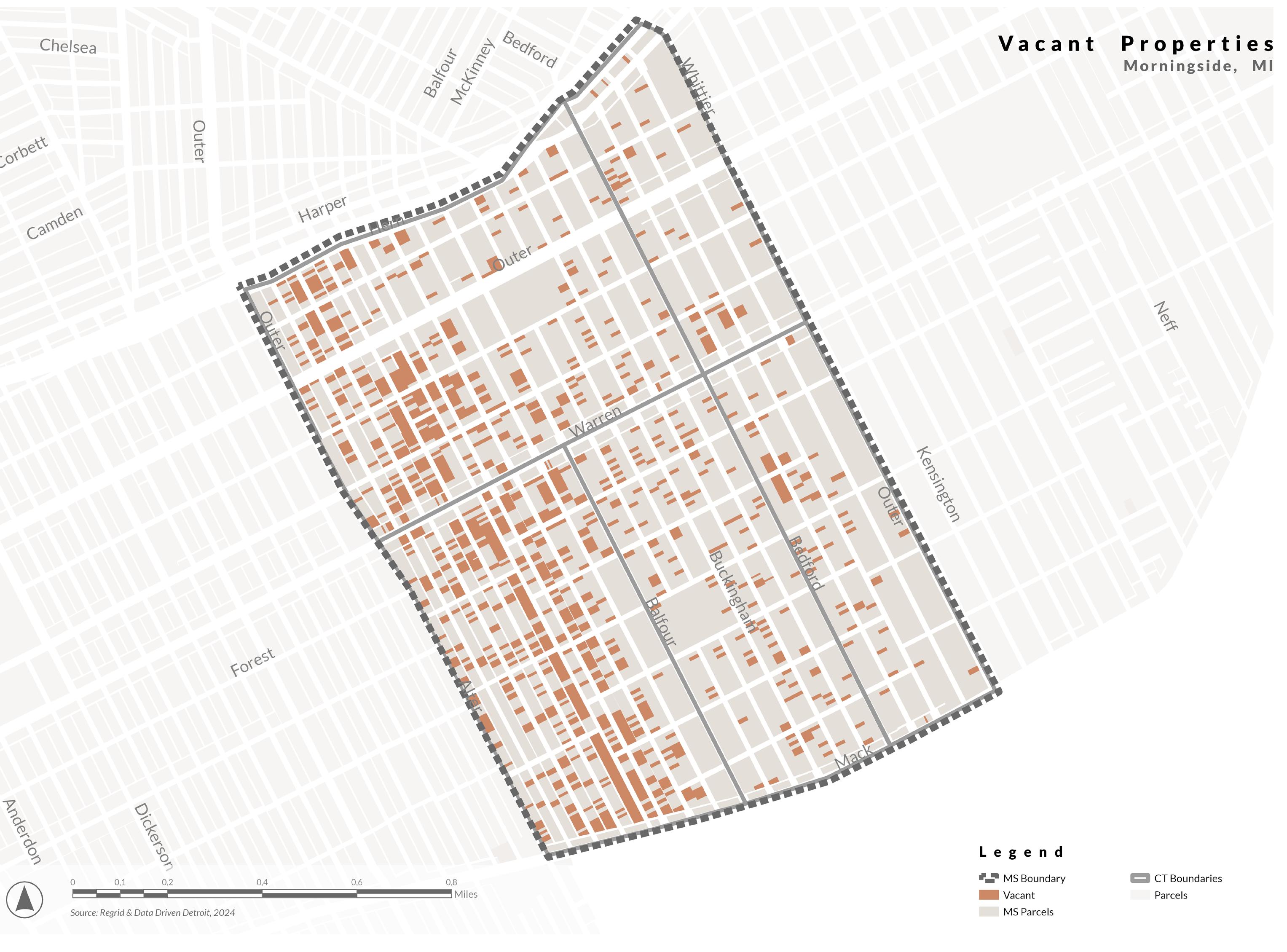
101
Scale Maps
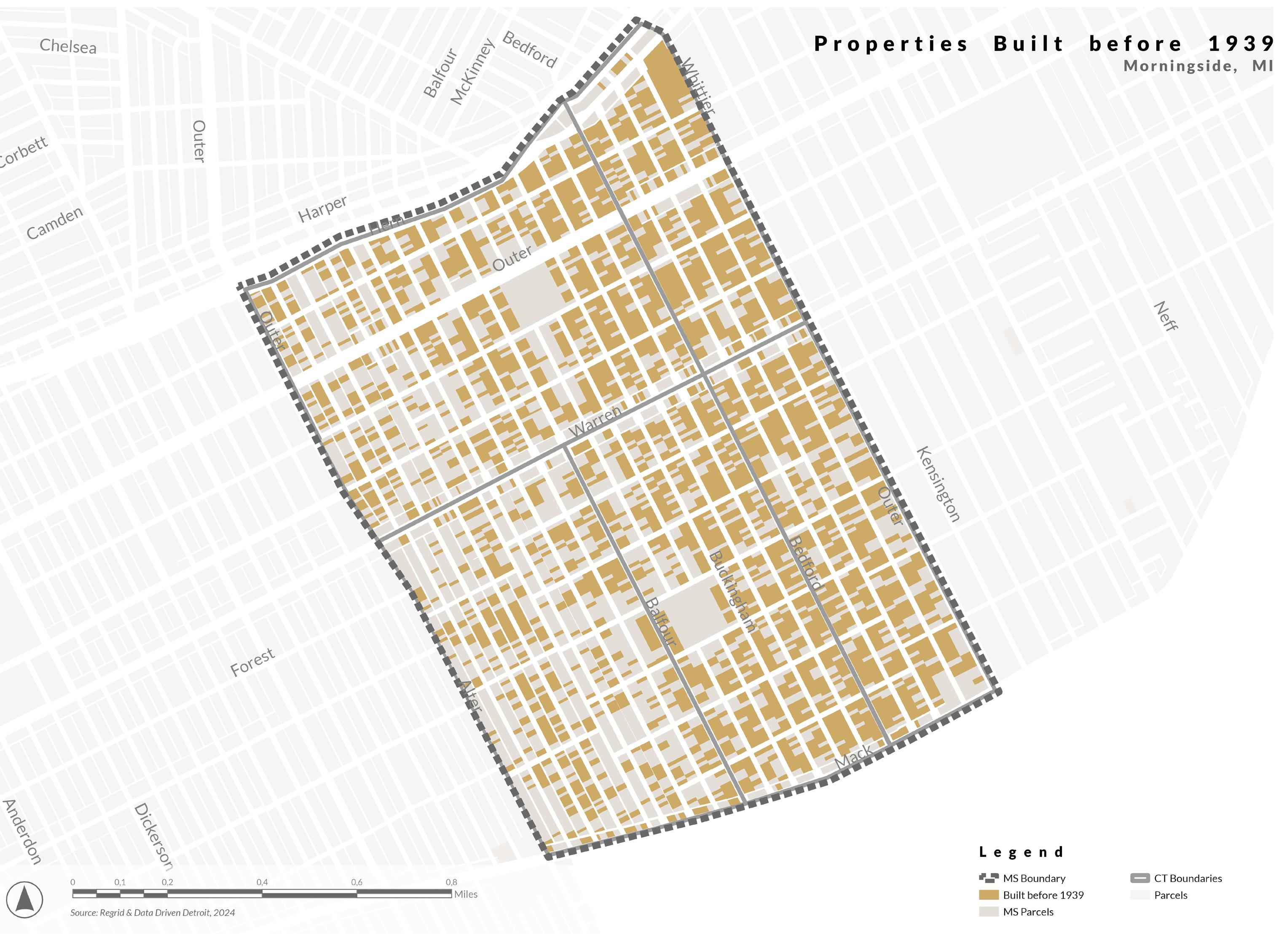
102

103

104
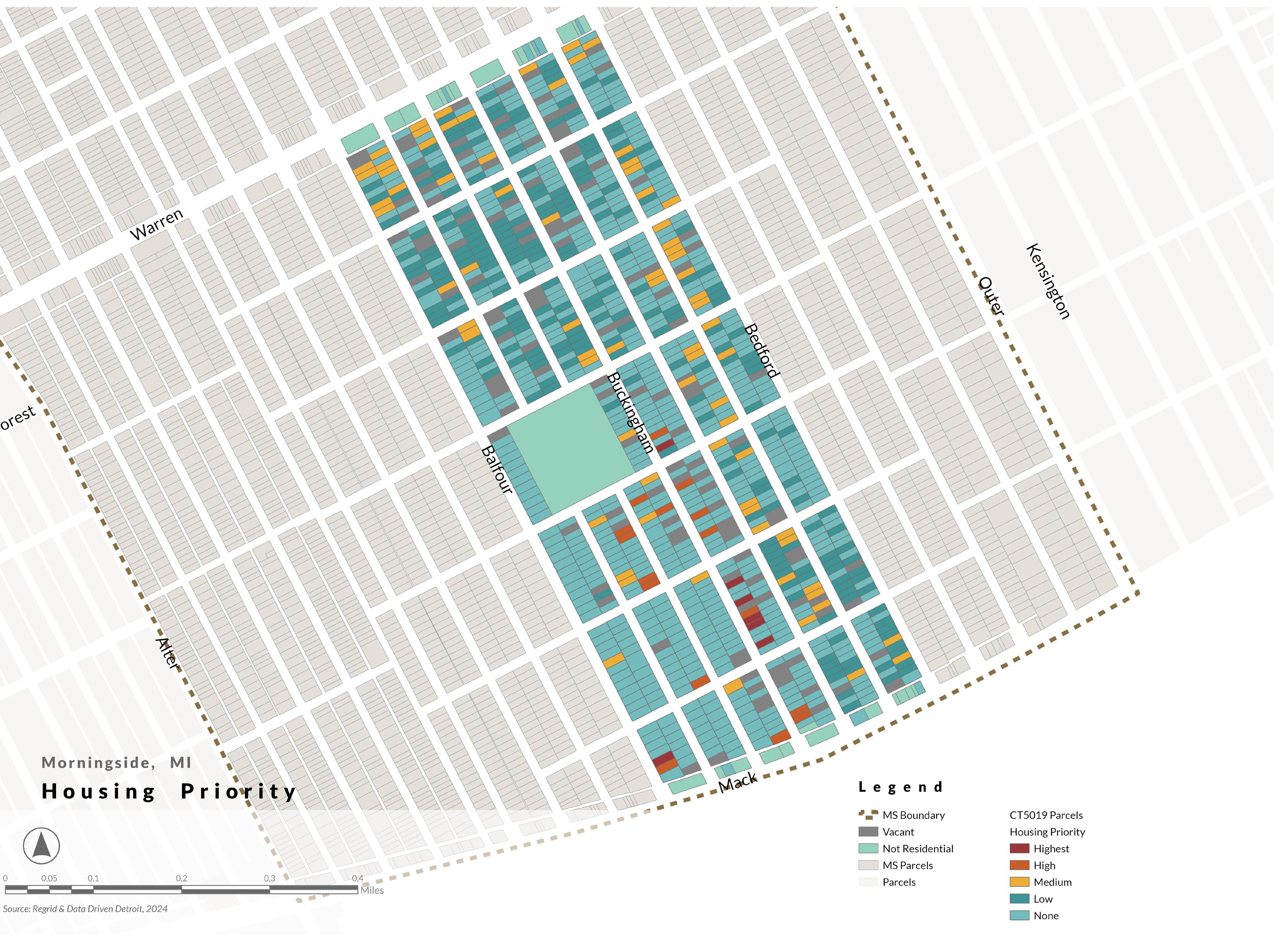
105
Windshield Survey Results
106 House Address AESTHETIC CONCERNS HAZARDOUS CONCERNS COMPOSITE SCORE HOUSING QUALITY RATING DESCRIPTION OF RATING 3610 BUCKINGHAM AVE 6 12 18 Critical Major improvement or demolition appears necessary. 3636 BUCKINGHAM AVE 6 12 18 Critical Major improvement or demolition appears necessary. 3644 BUCKINGHAM AVE 6 12 18 Critical Major improvement or demolition appears necessary. 3666 BUCKINGHAM AVE 8 10 18 Critical Major improvement or demolition appears necessary. 3446 BALFOUR RD 3 11 14 Critical Major improvement or demolition appears necessary. 3690 BUCKINGHAM AVE 7 9 16 Critical Major improvement or demolition appears necessary. 4015 BALFOUR RD 7 8 15 Critical Major improvement or demolition appears necessary. 4112 BUCKINGHAM AVE 6 8 14 Critical Major improvement or demolition appears necessary. 3652 BUCKINGHAM AVE 4 8 12 Poor Major improvements are needed in certain aspects of the home. 3926 BUCKINGHAM AVE 7 6 13 Poor Major improvements are needed in certain aspects of the home. 3438 BALFOUR RD 0 9 9 Fair Improvements appear necessary; minor structural problems. 3605 BERKSHIRE ST 6 6 12 Poor Major improvements are needed in certain aspects of the home. 3950 BUCKINGHAM AVE 4 7 11 Poor Major improvements are needed in certain aspects of the home.
107 3975 BUCKINGHAM AVE 4 7 11 Poor Major improvements are needed in certain aspects of the home. 3440 BUCKINGHAM AVE 5 6 11 Poor Major improvements are needed in certain aspects of the home. 3448 BUCKINGHAM AVE 5 6 11 Poor Major improvements are needed in certain aspects of the home. 3903 BERKSHIRE ST 5 6 11 Poor Major improvements are needed in certain aspects of the home. 3969 BERKSHIRE ST 5 6 11 Poor Major improvements are needed in certain aspects of the home. 3975 BERKSHIRE ST 5 6 11 Poor Major improvements are needed in certain aspects of the home. 3615 BALFOUR RD 2 7 9 Fair Improvements appear necessary; minor structural problems. 3435 BUCKINGHAM AVE 1 7 8 Fair Improvements appear necessary; minor structural problems. 4128 BUCKINGHAM AVE 4 5 9 Fair Improvements appear necessary; minor structural problems. 3990 BUCKINGHAM AVE 3 5 8 Fair Improvements appear necessary; minor structural problems. 4000 BERKSHIRE ST 3 5 8 Fair Improvements appear necessary; minor structural problems. 3976 BERKSHIRE ST 2 5 7 Fair Improvements appear necessary; minor structural problems. 3920 CHATSWORTH ST 5 3 8 Fair Improvements appear necessary; minor structural problems. 3928 CHATSWORTH ST 5 3 8 Fair Improvements appear necessary; minor structural problems. 3717 BUCKINGHAM AVE 2 4 6 Fair Improvements appear necessary; minor structural problems.
108 3461 DEVONSHIRE RD 3 3 6 Fair Improvements appear necessary; minor structural problems. 3645 DEVONSHIRE RD 3 3 6 Fair Improvements appear necessary; minor structural problems. 3934 HAVERHILL ST 3 3 6 Fair Improvements appear necessary; minor structural problems. 4014 HAVERHILL ST 3 3 6 Fair Improvements appear necessary; minor structural problems. 4166 HAVERHILL ST 3 3 6 Fair Improvements appear necessary; minor structural problems. 4310 BUCKINGHAM AVE 3 3 6 Fair Improvements appear necessary; minor structural problems. 4320 DEVONSHIRE RD 3 3 6 Fair Improvements appear necessary; minor structural problems. 4403 CHATSWORTH ST 3 3 6 Fair Improvements appear necessary; minor structural problems. 4652 BUCKINGHAM AVE 3 3 6 Fair Improvements appear necessary; minor structural problems. 4660 DEVONSHIRE RD 3 3 6 Fair Improvements appear necessary; minor structural problems. 4819 BERKSHIRE ST 3 3 6 Fair Improvements appear necessary; minor structural problems. 4891 BERKSHIRE ST 3 3 6 Fair Improvements appear necessary; minor structural problems. 3500 BERKSHIRE ST 0 4 4 Good Minimal improvements necessary; safe and sound structure. 3666 HAVERHILL ST 2 3 5 Fair Improvements appear necessary; minor structural problems. 4361 DEVONSHIRE RD 2 3 5 Fair Improvements appear necessary; minor structural problems. 4707 BUCKINGHAM AVE 2 3 5 Fair Improvements appear necessary; minor structural problems. 4867 BERKSHIRE ST 2 3 5 Fair Improvements appear necessary; minor structural problems.
109 4867 CHATSWORTH ST 2 3 5 Fair Improvements appear necessary; minor structural problems. 4890 BERKSHIRE ST 2 3 5 Fair Improvements appear necessary; minor structural problems. 3643 BEDFORD 3 2 5 Fair Improvements appear necessary; minor structural problems. 3926 HAVERHILL ST 3 2 5 Fair Improvements appear necessary; minor structural problems. 4000 CHATSWORTH ST 3 2 5 Fair Improvements appear necessary; minor structural problems. 4015 BUCKINGHAM AVE 1 3 4 Good Minimal improvements necessary; safe and sound structure. 4103 DEVONSHIRE RD 3 2 5 Fair Improvements appear necessary; minor structural problems. 4145 BUCKINGHAM AVE 3 2 5 Fair Improvements appear necessary; minor structural problems. 4212 DEVONSHIRE RD 1 3 4 Good Minimal improvements necessary; safe and sound structure. 4415 CHATSWORTH ST 3 2 5 Fair Improvements appear necessary; minor structural problems. 4605 BEDFORD ST 3 2 5 Fair Improvements appear necessary; minor structural problems. 4635 CHATSWORTH ST 3 2 5 Fair Improvements appear necessary; minor structural problems. 4670 DEVONSHIRE RD 3 2 5 Fair Improvements appear necessary; minor structural problems. 4821 BUCKINGHAM AVE 1 3 4 Good Minimal improvements necessary; safe and sound structure. 4835 CHATSWORTH ST 1 3 4 Good Minimal improvements necessary; safe and sound structure. 4876 BALFOUR RD 3 2 5 Fair Improvements appear necessary; minor structural problems.
110 4885 BERKSHIRE ST 1 3 4 Good Minimal improvements necessary; safe and sound structure. 3477 BEDFORD ST 2 2 4 Good Minimal improvements necessary; safe and sound structure. 3621 DEVONSHIRE RD 2 2 4 Good Minimal improvements necessary; safe and sound structure. 3637 DEVONSHIRE RD 2 2 4 Good Minimal improvements necessary; safe and sound structure. 3674 BALFOUR RD 0 3 3 Good Minimal improvements necessary; safe and sound structure. 3711 DEVONSHIRE RD 2 2 4 Good Minimal improvements necessary; safe and sound structure. 3715 DEVONSHIRE RD 2 2 4 Good Minimal improvements necessary; safe and sound structure. 3900 HAVERHILL ST 2 2 4 Good Minimal improvements necessary; safe and sound structure. 3903 DEVONSHIRE RD 2 2 4 Good Minimal improvements necessary; safe and sound structure. 3991 DEVONSHIRE RD 2 2 4 Good Minimal improvements necessary; safe and sound structure. 4127 DEVONSHIRE RD 2 2 4 Good Minimal improvements necessary; safe and sound structure. 4172 DEVONSHIRE RD 2 2 4 Good Minimal improvements necessary; safe and sound structure. 4321 BUCKINGHAM AVE 0 3 3 Good Minimal improvements necessary; safe and sound structure. 4350 DEVONSHIRE RD 2 2 4 Good Minimal improvements necessary; safe and sound structure. 4361 BUCKINGHAM AVE 2 2 4 Good Minimal improvements necessary; safe and sound structure. 4369 DEVONSHIRE RD 2 2 4 Good Minimal improvements necessary; safe and sound structure. 4374 DEVONSHIRE RD 2 2 4 Good Minimal improvements necessary; safe and sound structure. 4390 DEVONSHIRE RD 2 2 4 Good Minimal improvements necessary; safe and sound structure. 4416 DEVONSHIRE RD 2 2 4 Good Minimal improvements necessary; safe and sound structure.
111 4628 DEVONSHIRE RD 2 2 4 Good Minimal improvements necessary; safe and sound structure. 4642 CHATSWORTH ST 2 2 4 Good Minimal improvements necessary; safe and sound structure. 4682 DEVONSHIRE RD 2 2 4 Good Minimal improvements necessary; safe and sound structure. 4820 BALFOUR RD 2 2 4 Good Minimal improvements necessary; safe and sound structure. 4826 BALFOUR RD 2 2 4 Good Minimal improvements necessary; safe and sound structure. 4859 CHATSWORTH ST 2 2 4 Good Minimal improvements necessary; safe and sound structure. 4861 DEVONSHIRE RD 2 2 4 Good Minimal improvements necessary; safe and sound structure. 4868 BALFOUR RD 2 2 4 Good Minimal improvements necessary; safe and sound structure. 4876 DEVONSHIRE RD 2 2 4 Good Minimal improvements necessary; safe and sound structure. 4877 BUCKINGHAM AVE 2 2 4 Good Minimal improvements necessary; safe and sound structure. 4883 CHATSWORTH ST 2 2 4 Good Minimal improvements necessary; safe and sound structure. 4885 BEDFORD ST 2 2 4 Good Minimal improvements necessary; safe and sound structure. 4890 DEVONSHIRE RD 2 2 4 Good Minimal improvements necessary; safe and sound structure. 3426 HAVERHILL ST 1 2 3 Good Minimal improvements necessary; safe and sound structure. 3496 HAVERHILL ST 1 2 3 Good Minimal improvements necessary; safe and sound structure. 3661 DEVONSHIRE RD 1 2 3 Good Minimal improvements necessary; safe and sound structure. 3700 HAVERHILL ST 1 2 3 Good Minimal improvements necessary; safe and sound structure. 3716 HAVERHILL ST 1 2 3 Good Minimal improvements necessary; safe and sound structure.
112 3919 CHATSWORTH ST 1 2 3 Good Minimal improvements necessary; safe and sound structure. 3945 DEVONSHIRE RD 1 2 3 Good Minimal improvements necessary; safe and sound structure. 3974 HAVERHILL ST 1 2 3 Good Minimal improvements necessary; safe and sound structure. 4166 DEVONSHIRE RD 3 1 4 Good Minimal improvements necessary; safe and sound structure. 4344 DEVONSHIRE RD 1 2 3 Good Minimal improvements necessary; safe and sound structure. 4350 BUCKINGHAM AVE 1 2 3 Good Minimal improvements necessary; safe and sound structure. 4612 BUCKINGHAM AVE 1 2 3 Good Minimal improvements necessary; safe and sound structure. 4660 BUCKINGHAM AVE 3 1 4 Good Minimal improvements necessary; safe and sound structure. 4675 HAVERHILL ST 1 2 3 Good Minimal improvements necessary; safe and sound structure. 4802 DEVONSHIRE RD 1 2 3 Good Minimal improvements necessary; safe and sound structure. 4826 CHATSWORTH ST 1 2 3 Good Minimal improvements necessary; safe and sound structure. 4845 BUCKINGHAM AVE 1 2 3 Good Minimal improvements necessary; safe and sound structure. 4852 BUCKINGHAM AVE 1 2 3 Good Minimal improvements necessary; safe and sound structure. 4866 BERKSHIRE ST 1 2 3 Good Minimal improvements necessary; safe and sound structure. 4869 BUCKINGHAM AVE 1 2 3 Good Minimal improvements necessary; safe and sound structure. 3459 BEDFORD ST 2 1 3 Good Minimal improvements necessary; safe and sound structure.
113 3625 BEDFORD ST 2 1 3 Good Minimal improvements necessary; safe and sound structure. 3637 BEDFORD ST 2 1 3 Good Minimal improvements necessary; safe and sound structure. 3676 HAVERHILL ST 2 1 3 Good Minimal improvements necessary; safe and sound structure. 3910 DEVONSHIRE RD 2 1 3 Good Minimal improvements necessary; safe and sound structure. 3919 DEVONSHIRE RD 2 1 3 Good Minimal improvements necessary; safe and sound structure. 3920 HAVERHILL ST 2 1 3 Good Minimal improvements necessary; safe and sound structure. 4180 DEVONSHIRE RD 0 2 2 Good Minimal improvements necessary; safe and sound structure. 4196 BUCKINGHAM AVE 4 0 4 Good Minimal improvements necessary; safe and sound structure. 4366 CHATSWORTH ST 2 1 3 Good Minimal improvements necessary; safe and sound structure. 4417 BERKSHIRE ST 0 2 2 Good Minimal improvements necessary; safe and sound structure. 4600 BALFOUR RD 2 1 3 Good Minimal improvements necessary; safe and sound structure. 4603 BERKSHIRE ST 0 2 2 Good Minimal improvements necessary; safe and sound structure. 4628 HAVERHILL ST 2 1 3 Good Minimal improvements necessary; safe and sound structure. 4653 DEVONSHIRE RD 2 1 3 Good Minimal improvements necessary; safe and sound structure. 4667 BERKSHIRE ST 0 2 2 Good Minimal improvements necessary; safe and sound structure. 4690 DEVONSHIRE RD 2 1 3 Good Minimal improvements necessary; safe and sound structure. 4715 BUCKINGHAM AVE 2 1 3 Good Minimal improvements necessary; safe and sound structure. 4715 DEVONSHIRE RD 2 1 3 Good Minimal improvements necessary; safe and sound structure.
114 4820 HAVERHILL ST 0 2 2 Good Minimal improvements necessary; safe and sound structure. 4851 HAVERHILL ST 2 1 3 Good Minimal improvements necessary; safe and sound structure. 4882 BERKSHIRE ST 0 2 2 Good Minimal improvements necessary; safe and sound structure. 3447 BEDFORD ST 1 1 2 Good Minimal improvements necessary; safe and sound structure. 3466 HAVERHILL ST 1 1 2 Good Minimal improvements necessary; safe and sound structure. 3469 BEDFORD ST 1 1 2 Good Minimal improvements necessary; safe and sound structure. 3474 HAVERHILL ST 1 1 2 Good Minimal improvements necessary; safe and sound structure. 3482 HAVERHILL ST 1 1 2 Good Minimal improvements necessary; safe and sound structure. 3495 BEDFORD ST 1 1 2 Good Minimal improvements necessary; safe and sound structure. 3503 BEDFORD ST 1 1 2 Good Minimal improvements necessary; safe and sound structure. 3610 DEVONSHIRE RD 1 1 2 Good Minimal improvements necessary; safe and sound structure. 3652 DEVONSHIRE RD 1 1 2 Good Minimal improvements necessary; safe and sound structure. 3660 DEVONSHIRE RD 1 1 2 Good Minimal improvements necessary; safe and sound structure. 3662 HAVERHILL ST 1 1 2 Good Minimal improvements necessary; safe and sound structure. 3701 DEVONSHIRE RD 1 1 2 Good Minimal improvements necessary; safe and sound structure. 3934 DEVONSHIRE RD 1 1 2 Good Minimal improvements necessary; safe and sound structure. 3951 DEVONSHIRE RD 1 1 2 Good Minimal improvements necessary; safe and sound structure. 4100 DEVONSHIRE RD 1 1 2 Good Minimal improvements necessary; safe and sound structure. 4159 BEDFORD ST 1 1 2 Good Minimal improvements necessary; safe and sound structure.
115 4185 BUCKINGHAM AVE 3 0 3 Good Minimal improvements necessary; safe and sound structure. 4190 HAVERHILL ST 1 1 2 Good Minimal improvements necessary; safe and sound structure. 4303 BEDFORD ST 1 1 2 Good Minimal improvements necessary; safe and sound structure. 4311 DEVONSHIRE RD 1 1 2 Good Minimal improvements necessary; safe and sound structure. 4335 BERKSHIRE ST 1 1 2 Good Minimal improvements necessary; safe and sound structure. 4335 BUCKINGHAM AVE 1 1 2 Good Minimal improvements necessary; safe and sound structure. 4343 BEDFORD ST 1 1 2 Good Minimal improvements necessary; safe and sound structure. 4351 BERKSHIRE ST 1 1 2 Good Minimal improvements necessary; safe and sound structure. 4365 CHATSWORTH ST 1 1 2 Good Minimal improvements necessary; safe and sound structure. 4394 BALFOUR RD 1 1 2 Good Minimal improvements necessary; safe and sound structure. 4618 BALFOUR RD 3 0 3 Good Minimal improvements necessary; safe and sound structure. 4642 BERKSHIRE ST 3 0 3 Good Minimal improvements necessary; safe and sound structure. 4646 HAVERHILL ST 1 1 2 Good Minimal improvements necessary; safe and sound structure. 4651 HAVERHILL ST 1 1 2 Good Minimal improvements necessary; safe and sound structure. 4669 BUCKINGHAM AVE 1 1 2 Good Minimal improvements necessary; safe and sound structure. 4690 BALFOUR RD 1 1 2 Good Minimal improvements necessary; safe and sound structure. 4701 DEVONSHIRE RD 1 1 2 Good Minimal improvements necessary; safe and sound structure. 4706 DEVONSHIRE RD 1 1 2 Good Minimal improvements necessary; safe and sound structure.
116 4834 CHATSWORTH 1 1 2 Good Minimal improvements necessary; safe and sound structure. 4842 DEVONSHIRE RD 1 1 2 Good Minimal improvements necessary; safe and sound structure. 4844 BUCKINGHAM AVE 1 1 2 Good Minimal improvements necessary; safe and sound structure. 4845 HAVERHILL ST 1 1 2 Good Minimal improvements necessary; safe and sound structure. 4850 BALFOUR RD 1 1 2 Good Minimal improvements necessary; safe and sound structure. 4875 DEVONSHIRE RD 1 1 2 Good Minimal improvements necessary; safe and sound structure. 3444 HAVERHILL ST 0 1 1 Good Minimal improvements necessary; safe and sound structure. 3485 BEDFORD ST 0 1 1 Good Minimal improvements necessary; safe and sound structure. 3611 BEDFORD ST 2 0 2 Good Minimal improvements necessary; safe and sound structure. 3666 DEVONSHIRE RD 0 1 1 Good Minimal improvements necessary; safe and sound structure. 3696 HAVERHILL ST 0 1 1 Good Minimal improvements necessary; safe and sound structure. 3706 HAVERHILL ST 0 1 1 Good Minimal improvements necessary; safe and sound structure. 3715 BEDFORD ST 2 0 2 Good Minimal improvements necessary; safe and sound structure. 3992 HAVERHILL ST 0 1 1 Good Minimal improvements necessary; safe and sound structure. 4120 HAVERHILL ST 0 1 1 Good Minimal improvements necessary; safe and sound structure. 4144 HAVERHILL ST 0 1 1 Good Minimal improvements necessary; safe and sound structure. 4151 BEDFORD ST 0 1 1 Good Minimal improvements necessary; safe and sound structure. 4191 BEDFORD ST 0 1 1 Good Minimal improvements necessary; safe and sound structure. 4300 HAVERHILL ST 0 1 1 Good Minimal improvements necessary; safe and sound structure.
117 4303 BERKSHIRE ST 0 1 1 Good Minimal improvements necessary; safe and sound structure. 4329 BUCKINGHAM AVE 0 1 1 Good Minimal improvements necessary; safe and sound structure. 4329 HAVERHILL ST 0 1 1 Good Minimal improvements necessary; safe and sound structure. 4343 BERKSHIRE ST 0 1 1 Good Minimal improvements necessary; safe and sound structure. 4344 BERKSHIRE ST 0 1 1 Good Minimal improvements necessary; safe and sound structure. 4345 HAVERHILL ST 0 1 1 Good Minimal improvements necessary; safe and sound structure. 4358 HAVERHILL ST 0 1 1 Good Minimal improvements necessary; safe and sound structure. 4368 BUCKINGHAM AVE 0 1 1 Good Minimal improvements necessary; safe and sound structure. 4369 BUCKINGHAM AVE 2 0 2 Good Minimal improvements necessary; safe and sound structure. 4372 BERKSHIRE ST 0 1 1 Good Minimal improvements necessary; safe and sound structure. 4376 BUCKINGHAM AVE 0 1 1 Good Minimal improvements necessary; safe and sound structure. 4377 HAVERHILL ST 0 1 1 Good Minimal improvements necessary; safe and sound structure. 4385 BERKSHIRE ST 0 1 1 Good Minimal improvements necessary; safe and sound structure. 4390 BERKSHIRE ST 2 0 2 Good Minimal improvements necessary; safe and sound structure. 4391 BERKSHIRE ST 0 1 1 Good Minimal improvements necessary; safe and sound structure. 4408 HAVERHILL ST 0 1 1 Good Minimal improvements necessary; safe and sound structure. 4600 BERKSHIRE ST 0 1 1 Good Minimal improvements necessary; safe and sound structure.
118 4601 CHATSWORTH ST 0 1 1 Good Minimal improvements necessary; safe and sound structure. 4619 CHATSWORTH ST 0 1 1 Good Minimal improvements necessary; safe and sound structure. 4621 BUCKINGHAM AVE 0 1 1 Good Minimal improvements necessary; safe and sound structure. 4627 CHATSWORTH 0 1 1 Good Minimal improvements necessary; safe and sound structure. 4634 BERKSHIRE ST 2 0 2 Good Minimal improvements necessary; safe and sound structure. 4635 BUCKINGHAM AVE 0 1 1 Good Minimal improvements necessary; safe and sound structure. 4640 BALFOUR RD 0 1 1 Good Minimal improvements necessary; safe and sound structure. 4643 BERKSHIRE ST 0 1 1 Good Minimal improvements necessary; safe and sound structure. 4653 BEDFORD ST 0 1 1 Good Minimal improvements necessary; safe and sound structure. 4658 CHATSWORTH ST 0 1 1 Good Minimal improvements necessary; safe and sound structure. 4661 BERKSHIRE ST 0 1 1 Good Minimal improvements necessary; safe and sound structure. 4661 HAVERHILL ST 0 1 1 Good Minimal improvements necessary; safe and sound structure. 4666 CHATSWORTH ST 0 1 1 Good Minimal improvements necessary; safe and sound structure. 4667 HAVERHILL ST 0 1 1 Good Minimal improvements necessary; safe and sound structure. 4674 HAVERHILL ST 0 1 1 Good Minimal improvements necessary; safe and sound structure. 4677 BERKSHIRE ST 0 1 1 Good Minimal improvements necessary; safe and sound structure.
119 4683 CHATSWORTH ST 0 1 1 Good Minimal improvements necessary; safe and sound structure. 4684 BUCKINGHAM AVE 2 0 2 Good Minimal improvements necessary; safe and sound structure. 4684 HAVERHILL ST 0 1 1 Good Minimal improvements necessary; safe and sound structure. 4693 BERKSHIRE ST 0 1 1 Good Minimal improvements necessary; safe and sound structure. 4800 BERKSHIRE ST 0 1 1 Good Minimal improvements necessary; safe and sound structure. 4803 BERKSHIRE ST 2 0 2 Good Minimal improvements necessary; safe and sound structure. 4827 BERKSHIRE ST 2 0 2 Good Minimal improvements necessary; safe and sound structure. 4834 BALFOUR RD 0 1 1 Good Minimal improvements necessary; safe and sound structure. 4870 BUCKINGHAM AVE 0 1 1 Good Minimal improvements necessary; safe and sound structure. 4884 BUCKINGHAM AVE 0 1 1 Good Minimal improvements necessary; safe and sound structure. 3450 DEVONSHIRE RD 1 0 1 Good Minimal improvements necessary; safe and sound structure. 3469 DEVONSHIRE RD 1 0 1 Good Minimal improvements necessary; safe and sound structure. 3470 DEVONSHIRE 1 0 1 Good Minimal improvements necessary; safe and sound structure. 3477 DEVONSHIRE RD 1 0 1 Good Minimal improvements necessary; safe and sound structure. 3511 DEVONSHIRE 1 0 1 Good Minimal improvements necessary; safe and sound structure. 3517 BEDFORD ST 1 0 1 Good Minimal improvements necessary; safe and sound structure. 3603 DEVONSHIRE RD 1 0 1 Good Minimal improvements necessary; safe and sound structure. 3620 DEVONSHIRE RD 1 0 1 Good Minimal improvements necessary; safe and sound structure.
120 3636 DEVONSHIRE RD 1 0 1 Good Minimal improvements necessary; safe and sound structure. 3640 DEVONSHIRE RD 1 0 1 Good Minimal improvements necessary; safe and sound structure. 3651 BEDFORD ST 1 0 1 Good Minimal improvements necessary; safe and sound structure. 3667 BEDFORD ST 1 0 1 Good Minimal improvements necessary; safe and sound structure. 3682 HAVERHILL ST 1 0 1 Good Minimal improvements necessary; safe and sound structure. 3691 BEDFORD ST 1 0 1 Good Minimal improvements necessary; safe and sound structure. 3991 BEDFORD ST 1 0 1 Good Minimal improvements necessary; safe and sound structure. 3997 DEVONSHIRE RD 1 0 1 Good Minimal improvements necessary; safe and sound structure. 4100 BUCKINGHAM AVE 1 0 1 Good Minimal improvements necessary; safe and sound structure. 4143 BEDFORD ST 1 0 1 Good Minimal improvements necessary; safe and sound structure. 4175 DEVONSHIRE RD 1 0 1 Good Minimal improvements necessary; safe and sound structure. 4206 DEVONSHIRE RD 1 0 1 Good Minimal improvements necessary; safe and sound structure. 4311 BEDFORD ST 1 0 1 Good Minimal improvements necessary; safe and sound structure. 4311 BERKSHIRE ST 1 0 1 Good Minimal improvements necessary; safe and sound structure. 4319 BEDFORD ST 1 0 1 Good Minimal improvements necessary; safe and sound structure. 4319 DEVONSHIRE RD 1 0 1 Good Minimal improvements necessary; safe and sound structure. 4326 HAVERHILL ST 1 0 1 Good Minimal improvements necessary; safe and sound structure. 4334 BERKSHIRE ST 1 0 1 Good Minimal improvements necessary; safe and sound structure. 4343 BUCKINGHAM AVE 1 0 1 Good Minimal improvements necessary; safe and sound structure.
121 4350 CHATSWORTH ST 1 0 1 Good Minimal improvements necessary; safe and sound structure. 4353 BUCKINGHAM AVE 1 0 1 Good Minimal improvements necessary; safe and sound structure. 4395 CHATSWORTH ST 1 0 1 Good Minimal improvements necessary; safe and sound structure. 4399 BERKSHIRE ST 1 0 1 Good Minimal improvements necessary; safe and sound structure. 4401 BEDFORD ST 1 0 1 Good Minimal improvements necessary; safe and sound structure. 4415 BUCKINGHAM AVE 1 0 1 Good Minimal improvements necessary; safe and sound structure. 4604 BUCKINGHAM AVE 1 0 1 Good Minimal improvements necessary; safe and sound structure. 4612 BALFOUR RD 1 0 1 Good Minimal improvements necessary; safe and sound structure. 4618 CHATSWORTH ST 1 0 1 Good Minimal improvements necessary; safe and sound structure. 4620 DEVONSHIRE RD 1 0 1 Good Minimal improvements necessary; safe and sound structure. 4621 BERKSHIRE ST 1 0 1 Good Minimal improvements necessary; safe and sound structure. 4626 BERKSHIRE ST 1 0 1 Good Minimal improvements necessary; safe and sound structure. 4627 BUCKINGHAM AVE 1 0 1 Good Minimal improvements necessary; safe and sound structure. 4635 BERKSHIRE ST 1 0 1 Good Minimal improvements necessary; safe and sound structure. 4645 CHATSWORTH ST 1 0 1 Good Minimal improvements necessary; safe and sound structure. 4650 BERKSHIRE ST 1 0 1 Good Minimal improvements necessary; safe and sound structure.
122 4650 CHATSWORTH ST 1 0 1 Good Minimal improvements necessary; safe and sound structure. 4651 BERKSHIRE ST 1 0 1 Good Minimal improvements necessary; safe and sound structure. 4651 CHATSWORTH ST 1 0 1 Good Minimal improvements necessary; safe and sound structure. 4653 BUCKINGHAM AVE 1 0 1 Good Minimal improvements necessary; safe and sound structure. 4660 BERKSHIRE ST 1 0 1 Good Minimal improvements necessary; safe and sound structure. 4661 CHATSWORTH ST 1 0 1 Good Minimal improvements necessary; safe and sound structure. 4666 BALFOUR RD 1 0 1 Good Minimal improvements necessary; safe and sound structure. 4668 BUCKINGHAM AVE 1 0 1 Good Minimal improvements necessary; safe and sound structure. 4674 BALFOUR RD 1 0 1 Good Minimal improvements necessary; safe and sound structure. 4675 BEDFORD ST 1 0 1 Good Minimal improvements necessary; safe and sound structure. 4676 DEVONSHIRE RD 1 0 1 Good Minimal improvements necessary; safe and sound structure. 4677 CHATSWORTH ST 1 0 1 Good Minimal improvements necessary; safe and sound structure. 4680 BUCKINGHAM AVE 1 0 1 Good Minimal improvements necessary; safe and sound structure. 4690 HAVERHILL ST 1 0 1 Good Minimal improvements necessary; safe and sound structure. 4700 CHATSWORTH ST 1 0 1 Good Minimal improvements necessary; safe and sound structure.
123 4701 BUCKINGHAM AVE 1 0 1 Good Minimal improvements necessary; safe and sound structure. 4707 BERKSHIRE ST 1 0 1 Good Minimal improvements necessary; safe and sound structure. 4707 CHATSWORTH ST 1 0 1 Good Minimal improvements necessary; safe and sound structure. 4709 DEVONSHIRE RD 1 0 1 Good Minimal improvements necessary; safe and sound structure. 4714 CHATSWORTH ST 1 0 1 Good Minimal improvements necessary; safe and sound structure. 4714 DEVONSHIRE RD 1 0 1 Good Minimal improvements necessary; safe and sound structure. 4716 BUCKINGHAM AVE 1 0 1 Good Minimal improvements necessary; safe and sound structure. 4812 BUCKINGHAM AVE 1 0 1 Good Minimal improvements necessary; safe and sound structure. 4821 DEVONSHIRE RD 1 0 1 Good Minimal improvements necessary; safe and sound structure. 4825 CHATSWORTH ST 1 0 1 Good Minimal improvements necessary; safe and sound structure. 4835 BEDFORD ST 1 0 1 Good Minimal improvements necessary; safe and sound structure. 4835 BERKSHIRE ST 1 0 1 Good Minimal improvements necessary; safe and sound structure. 4835 DEVONSHIRE RD 1 0 1 Good Minimal improvements necessary; safe and sound structure. 4844 BERKSHIRE ST 1 0 1 Good Minimal improvements necessary; safe and sound structure. 4844 CHATSWORTH ST 1 0 1 Good Minimal improvements necessary; safe and sound structure. 4860 BUCKINGHAM AVE 1 0 1 Good Minimal improvements necessary; safe and sound structure.
124 4861 BERKSHIRE ST 1 0 1 Good Minimal improvements necessary; safe and sound structure. 4861 BUCKINGHAM AVE 1 0 1 Good Minimal improvements necessary; safe and sound structure. 4869 DEVONSHIRE RD 1 0 1 Good Minimal improvements necessary; safe and sound structure. 4883 DEVONSHIRE RD 1 0 1 Good Minimal improvements necessary; safe and sound structure.
125
MORNINGSIDE HOUSING REVITALIZATION STRATEGY












































 Figure 46. Community Meeting at Morningside.
Figure 46. Community Meeting at Morningside.
 Figure 47. Community meeting participants.
Figure 47. Community meeting participants.

 Figure 49. An example is a recently renovated street within the Fitzgerald neighborhood. Source: LISC Detroit.
Figure 49. An example is a recently renovated street within the Fitzgerald neighborhood. Source: LISC Detroit.










 Figure 67. A neighbor and her house in Morningside. Photo by Morningside Newsletter.
Figure 67. A neighbor and her house in Morningside. Photo by Morningside Newsletter.













 Figure 71. Housing Construction. Photo by Josh Olalde on Unsplash.
Figure 71. Housing Construction. Photo by Josh Olalde on Unsplash.








 Figure 74. Data Updating. Photo by Campaign Creators on Unsplash.
Figure 74. Data Updating. Photo by Campaign Creators on Unsplash.















